Search Result
Results for "
indicators
" in MedChemExpress (MCE) Product Catalog:
14
Biochemical Assay Reagents
23
Isotope-Labeled Compounds
| Cat. No. |
Product Name |
Target |
Research Areas |
Chemical Structure |
-
- HY-D1620
-
-

-
- HY-126821A
-
|
|
Fluorescent Dye
|
Others
|
|
Fluo-3 pentaammonium is a fluorescence indicator of intracellular calcium (Ca 2+). Excitation/Emission = 488/525 nm .
|
-
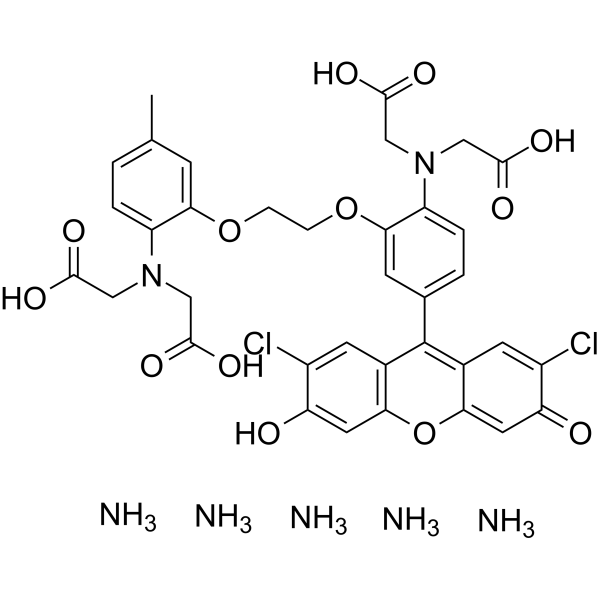
-
- HY-D0219A
-
|
|
Fluorescent Dye
|
Others
|
|
Thymol Blue sodium is an acid-base indicator used to indicate changes in pH. Thymol Blue sodium fades from red to yellow at pH 1.2 to 2.8 and from yellow to blue at pH 8.0 to 9.6 .
|
-
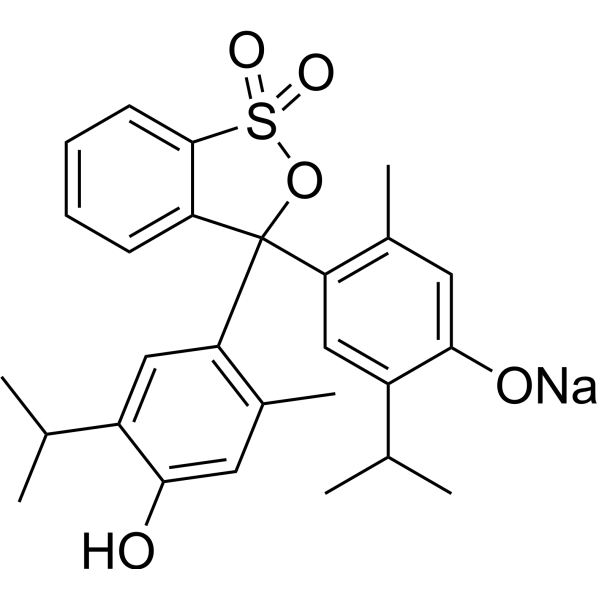
-
- HY-W351340
-
|
|
Fluorescent Dye
|
Others
|
|
4-(Benzyloxy)-2-nitrophenol is a synthetic building block that can be used in the synthesis of fluorescent ion indicators .
|
-
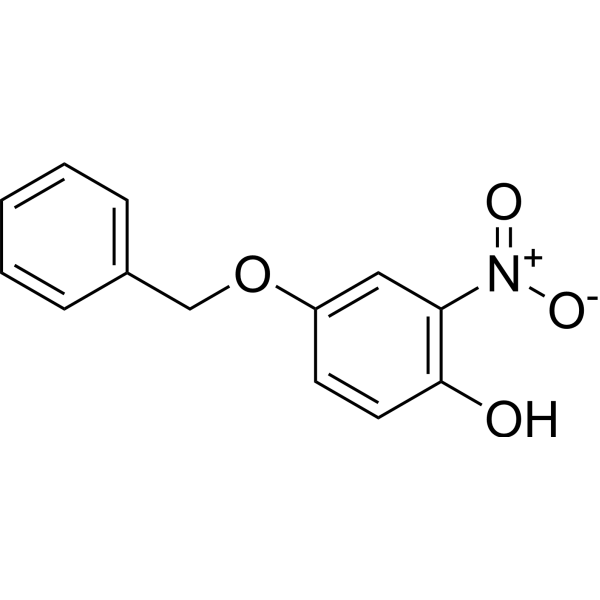
-
- HY-D1628
-
-
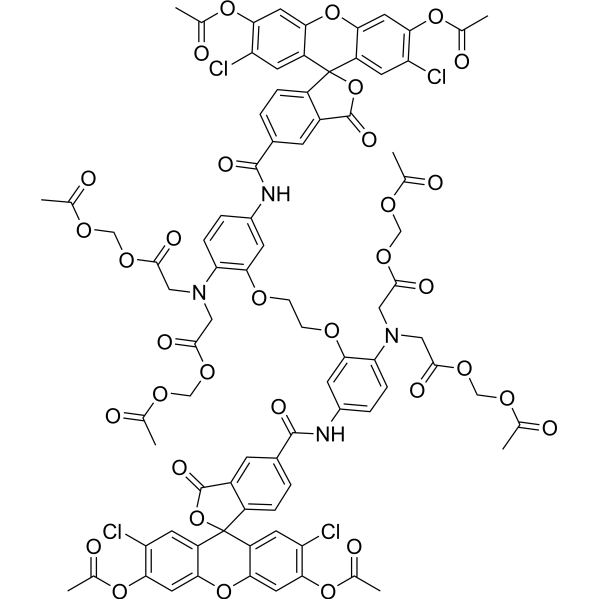
-
- HY-D0168
-
|
3,5-Dihydroxytoluene
|
Fluorescent Dye
|
Others
|
|
Orcinol (3,5-Dihydroxytoluene) is an organic compound used as biological dye and indicator for proteomics research.
|
-
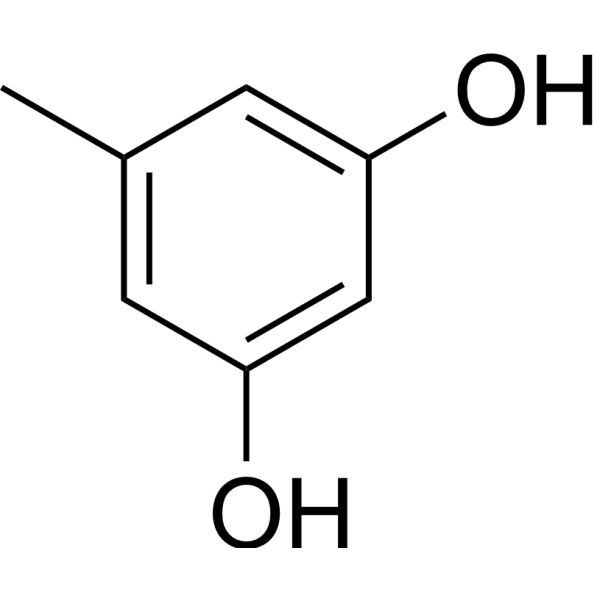
-
- HY-D1492
-
|
|
Fluorescent Dye
|
Others
|
|
Fast Sulphon Black F is a specific copper indicator. Fast Sulphon Black F can be used for EDTA titration .
|
-
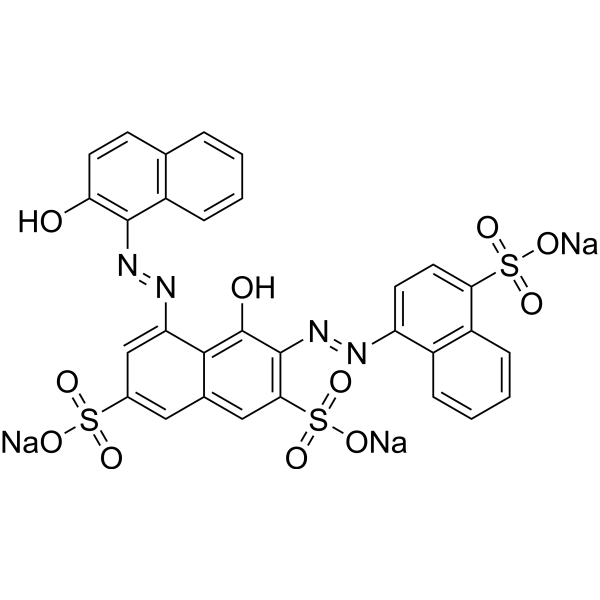
-
- HY-D1681
-
|
|
Fluorescent Dye
|
Others
|
|
Rhod-590 AM Ester is a fluorescent dye. Rhod-590 AM Ester can be used as a fluorescent indicator for calcium determination .
|
-
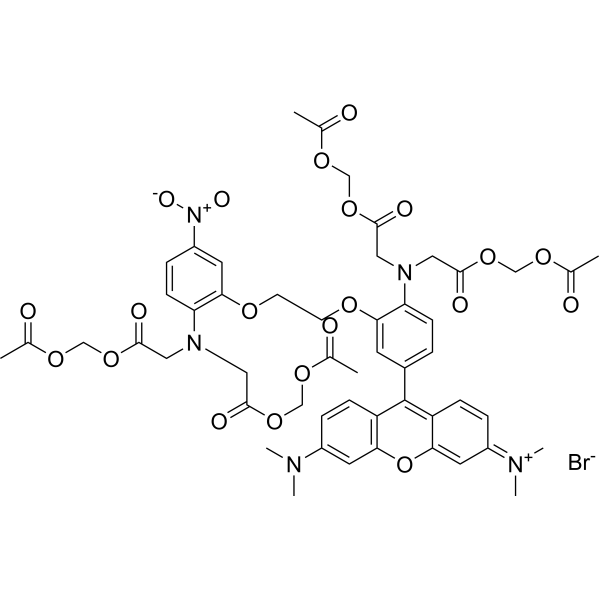
-
- HY-W140535
-
|
|
Fluorescent Dye
|
Others
|
|
Tetrasodium,4-(1,10-phenanthrolin-4-yl)benzenesulfonate,ruthenium((II)) is a luminescent indicator dye .
|
-
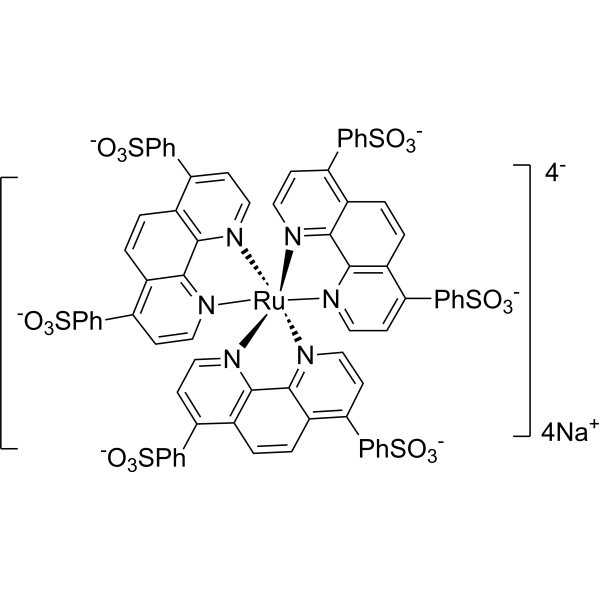
-
- HY-D0169A
-
|
Phenolsulfonephthalein sodium salt
|
Fluorescent Dye
|
Others
|
|
Phenol red (Phenolsulfonephthalein) sodium salt is a pH indicator dye, relying on a distinct color change from pink to yellow in case of a positive reaction .
|
-
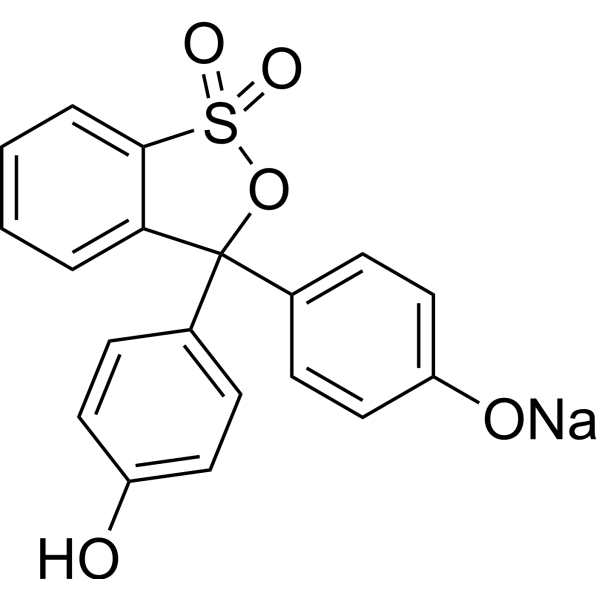
-
- HY-D1436
-
-
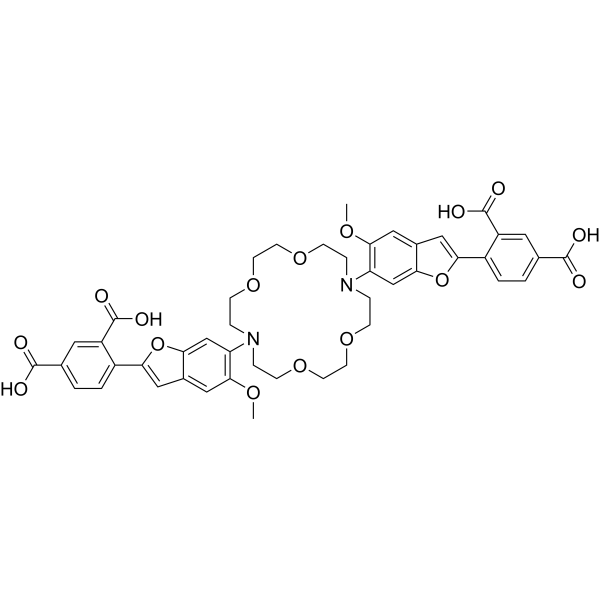
-
- HY-D1484
-
|
1,1'-Diethyl-2,4'-cyanine iodide
|
Fluorescent Dye
|
Others
|
|
Ethyl red (1,1'-Diethyl-2,4'-cyanine) iodide is an azo dye and acid–base indicator .
|
-
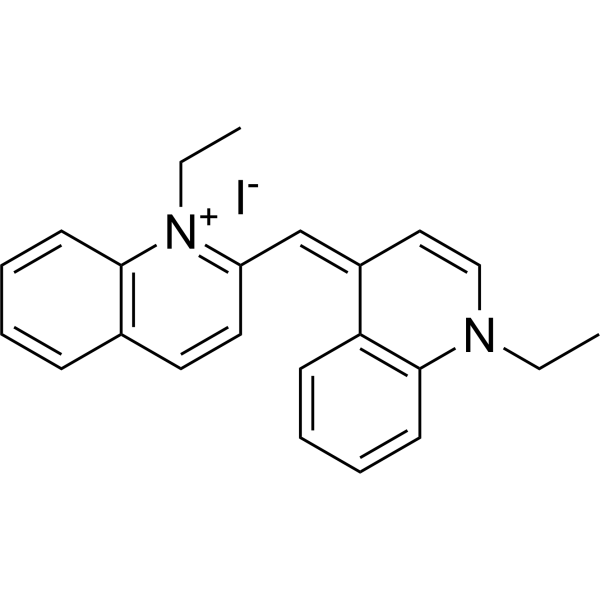
-
- HY-W351339
-
|
|
Fluorescent Dye
|
Cancer
|
|
BAPTA-TMFM is a fluorescent chelating indicator used to study the role of cytosolic free calcium.
|
-

-
- HY-W110904
-
|
|
Fluorescent Dye
|
Others
|
|
Methylthymol blue tetrasodium is a metallochromic indicator dye and can be used for determination of sulfate and calcium .
|
-
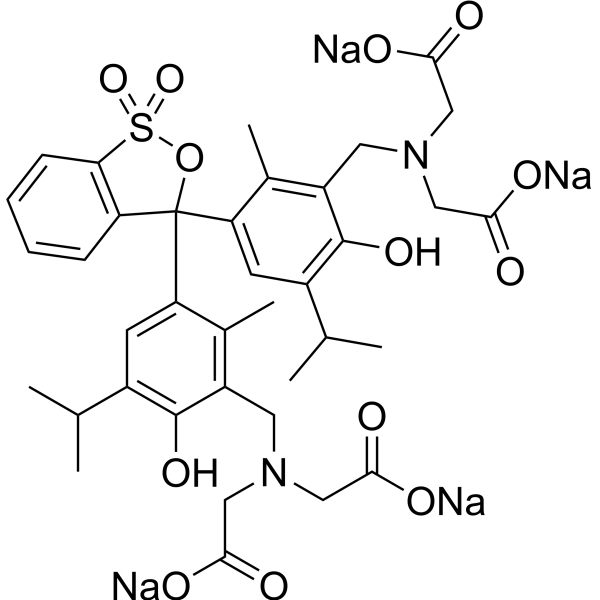
-
- HY-D0215
-
|
Safranine T
|
Fluorescent Dye
|
Others
|
|
Safranin (Safranin T) is an important and classical phenazinium dye. Safranin has been extensively used in the academic field as a spectroscopic probe and indicator. Safranin possesses a planar structure and cationic charge. It can readily intercalate into biological macromolecules, including DNA and proteins. Safranin can be used as a redox indicator in the determination of metal ion concentration .
|
-
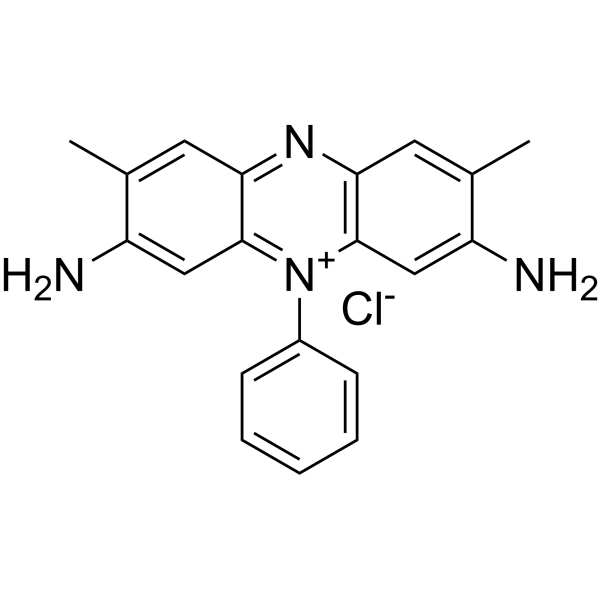
-
- HY-D0121
-
|
|
Fluorescent Dye
|
Others
|
|
INDO 1 is a fluorescent Ca 2+ indicator, binds specifically to Ca 2+ while emitting fluorescence, the maximum emission wavelength shifts from 485 nm before binding to 410 nm .
|
-
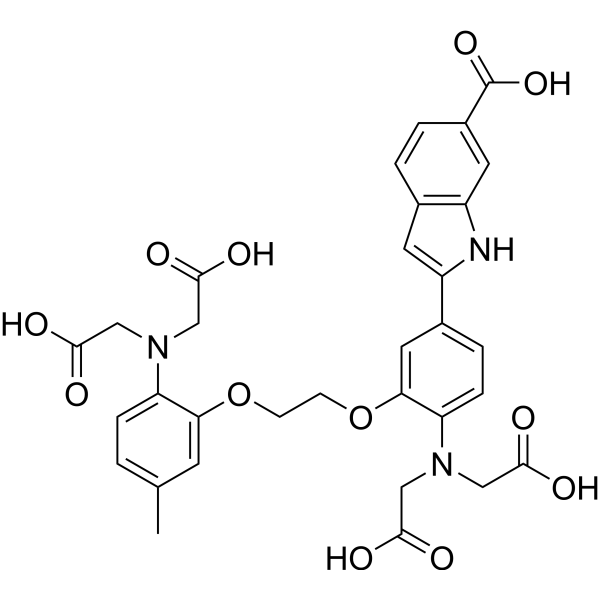
-
- HY-D0140
-
|
ETH 5294
|
Fluorescent Dye
|
Others
|
|
Chromoionophore I (ETH 5294) is a hydrophobic pH indicator. Chromoionophore I is used as a transmissive or fluorescent probe molecule in many types of hydrophobic sensor membranes. Chromoionophore I is oil-soluble .
|
-
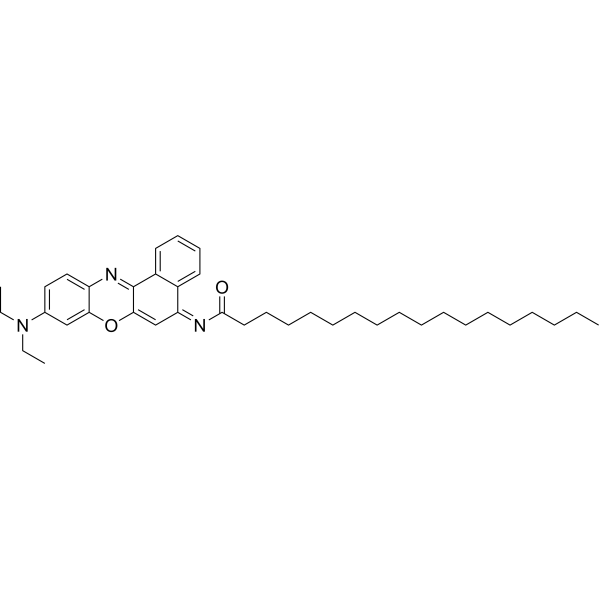
-
- HY-D0121A
-
|
|
Fluorescent Dye
|
|
|
INDO 1 pentapotassium is a fluorescent Ca 2+ indicator, binds specifically to Ca 2+ while emitting fluorescence, the maximum emission wavelength shifts from 485 nm before binding to 410 nm .
|
-

-
- HY-D0023
-
|
HPTS; Solvent Green 7
|
Fluorescent Dye
|
Others
|
|
Pyranine (HPTS; Solvent Green 7) is a pH-sensitive fluorescent indicator. Pyranine acts as a class of fluorescent chemosensor for the Cu + ion(λex=450 nm, λem=510 nm) .
|
-
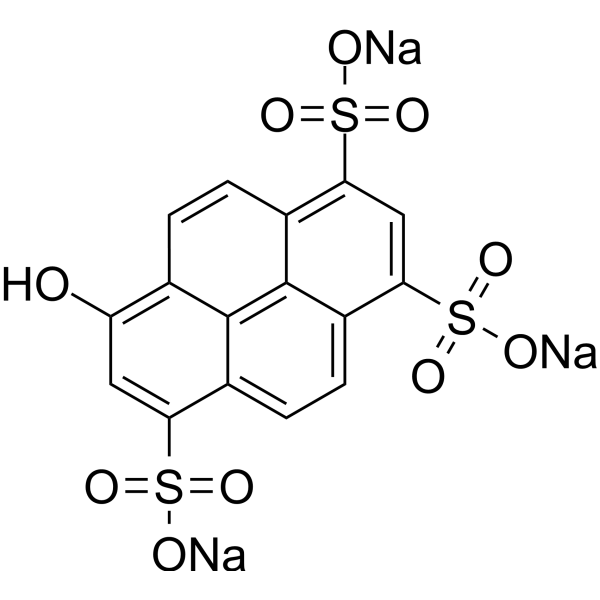
-
- HY-118320
-
|
Mordant orange 1
|
Fluorescent Dye
|
Others
|
|
Alizarine Yellow R (Mordant orange 1), a salicylic acid derivative, is a azo dye. Alizarine Yellow R is mostly used as a pH indicator, as a biological stain in chemical examinations and also in dyeing industries .
|
-
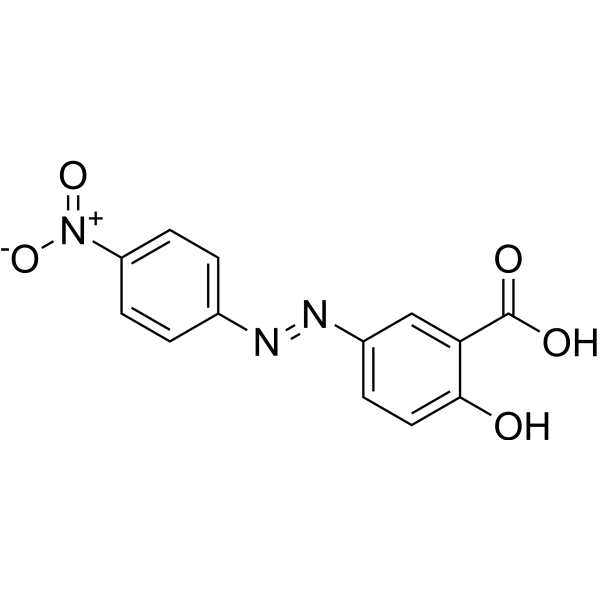
-
- HY-32349S
-
|
25-Hydroxy Vitamin D2-d3
|
Endogenous Metabolite
|
Metabolic Disease
|
|
Ercalcidiol-d3 is the deuterium labeled Ercalcidiol. Ercalcidiol is a metabolite of Vitamins D2. Ercalcidiol can be used as an indicator of vitamins D status .
|
-
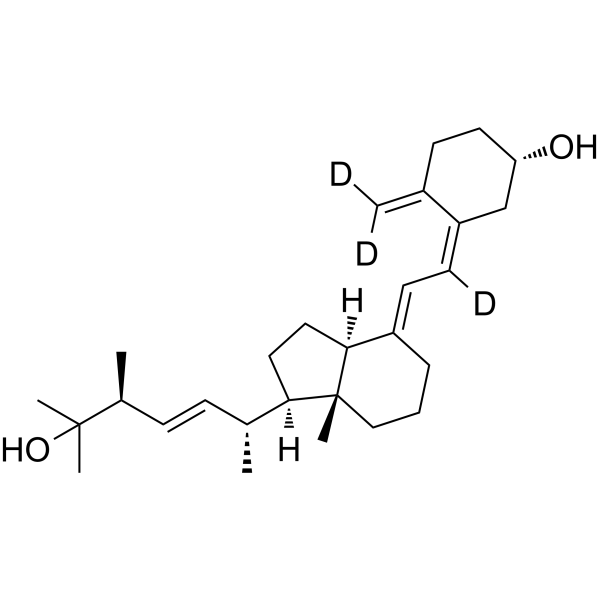
-
- HY-D1442
-
|
|
Fluorescent Dye
|
Others
|
|
SBFI (tetraammonium), the tetraammonium salt of SBFI, is a sodium fluorescence indicator. SBFI (tetraammonium) is sodium-sensitive dye. The excitation wavelength is set 333 nm, and the emission wavelength is 539 nm for SBFI .
|
-
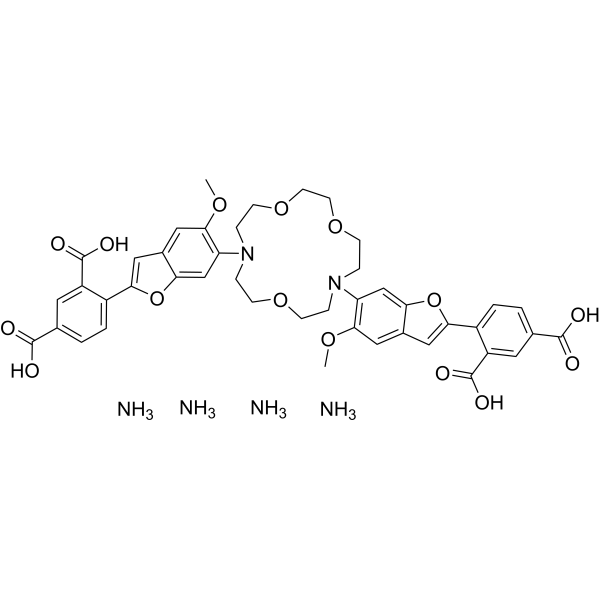
-
- HY-W012982
-
|
AOZ
|
Drug Metabolite
|
Metabolic Disease
|
|
3-Amino-2-oxazolidinone (AOZ) is the metabolite of Furazolidone (HY-B1336). 3-Amino-2-oxazolidinone is always be detected as a indicator of furazolidone residues in vivo .
|
-

-
- HY-D0169
-
|
Phenolsulfonephthalein
|
Fluorescent Dye
|
Others
|
|
Phenol red (Phenolsulfonephthalein) is a pH indicator dye, relying on a distinct color change from pink to yellow in case of a positive reaction .
|
-
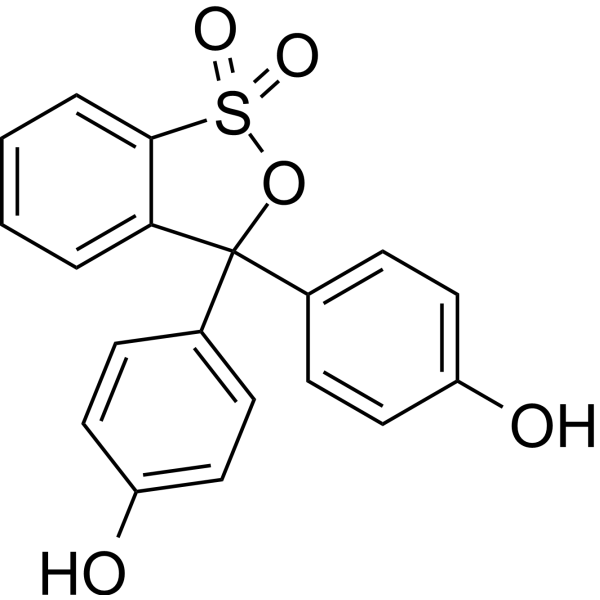
-
- HY-113409
-
|
|
Endogenous Metabolite
|
Metabolic Disease
|
|
3-Hydroxyisovaleric acid is a normal endogenous metabolite excreted in the urine. The urinary excretion of 3-hydroxyisovaleric acid is early and sensitive indicator of biotin deficiency .
|
-

-
- HY-W151206
-
|
|
Fluorescent Dye
|
Others
|
|
Hydroxy naphthol blue disodium, an azo dye, is a metal indicator for calcium and a colorimetric reagent for alkaline earth metal ions ( λmax = 650 nm). In the pH range between 12 and 13, the solution of the indicator is reddish pink in the presence of calcium ion and to deep blue in the presence of disodium EDTA .
|
-

-
- HY-D1091
-
-
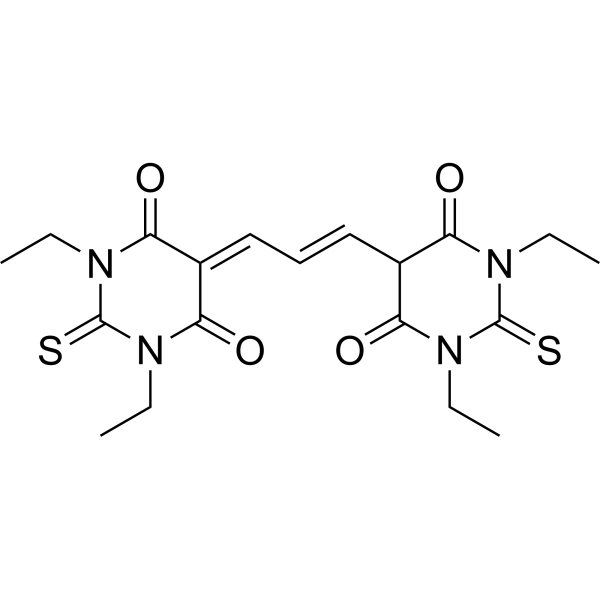
-
- HY-W003112
-
|
|
Fluorescent Dye
|
Others
|
|
4-Fluororesorcinol is a precursor used in the preparation of fluorescent dyes or indicators such as fluorescein, coumarin and resorcinol analogues .
|
-
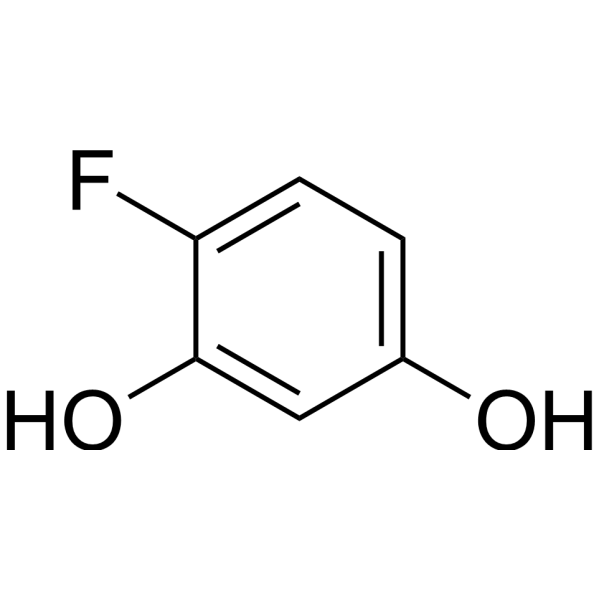
-
- HY-137128
-
|
|
Fluorescent Dye
|
Others
|
|
BTC tetrapotassium is a low affinity calcium indicator (Kd approximately 7-26 µM) featuring many desirable properties for cellular calcium imaging, including long excitation wavelengths (400/485 nm), low sensitivity to Mg 2+, and accuracy of ratiometric measurement .
|
-
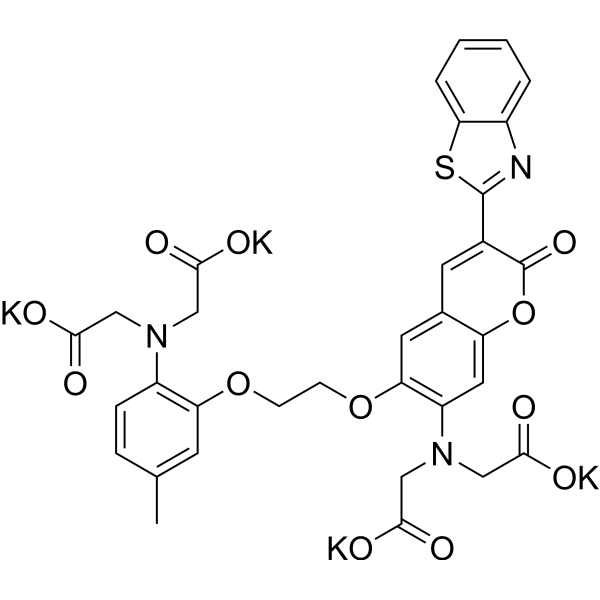
-
- HY-D1616
-
|
|
Fluorescent Dye
|
Others
|
|
5-Bromo-5'-methyl BAPTA tetramethyl ester is a derivative of BAPTA, which is a calcium indicator suitable for measurement of relatively high level of calcium .
|
-
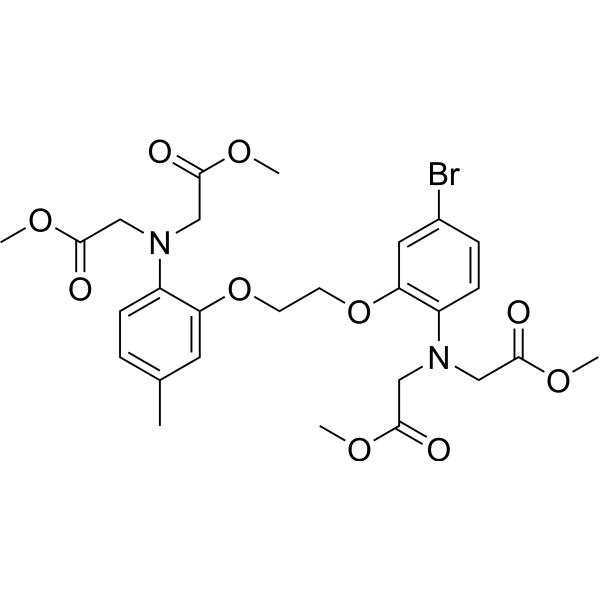
-
- HY-137103
-
|
|
Fluorescent Dye
|
Others
|
|
BTC-AM is a low affinity calcium indicator. BTC-AM has substantial calcium-independent fluorescence at all excitation wavelengths. BTC-AM is readily loaded into neurons and is rapidly hydrolysed .
|
-
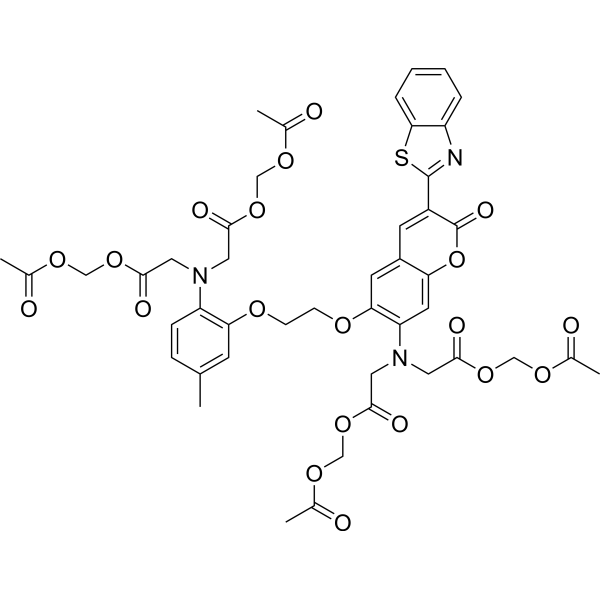
-
- HY-129491
-
|
CGP62221; O-Desmethyl PKC412
|
PKC
|
Cancer
|
|
O-Desmethyl Midostaurin (CGP62221; O-Desmethyl PKC412) is the active metabolite of Midostaurin (HY-10230) via cytochrome P450 liver enzyme metabolism. O-Desmethyl Midostaurin can be used as an indicator for Midostaurin metabolism in vivo . Midostaurin is a multi-targeted protein kinase inhibitor with IC50 ranging from 22-500 nM.
|
-
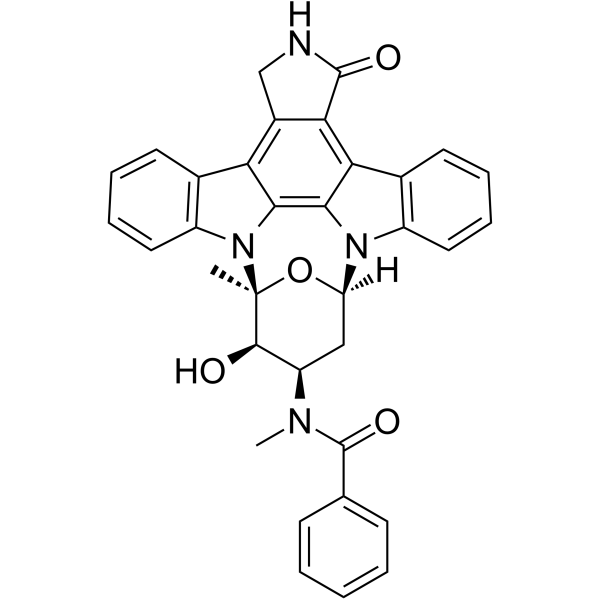
-
- HY-W142631
-
|
|
Fluorescent Dye
|
Cancer
|
|
4-(Phenylazo)diphenylamine is an excellent colorimetric indicator for the accurate determination of the concentration for a variety of strong bases, Lewis acids, and hydride reducing agents .
|
-
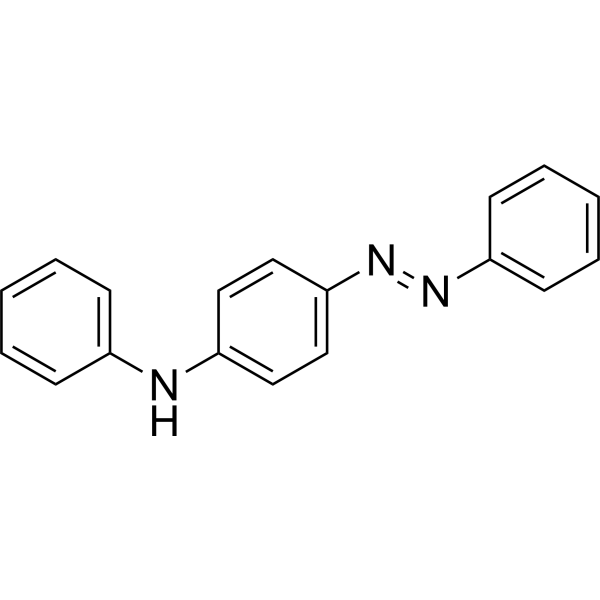
-
- HY-D1435
-
|
|
Na+/K+ ATPase
|
Neurological Disease
|
|
Oxonol VI acts as an optical indicator for membrane potentials in lipid vesicles. Oxonol VI is suitable for detecting changes of membrane potential associated with the activity of the (Na + + K +)-ATPase in reconstituted vesicles .
|
-
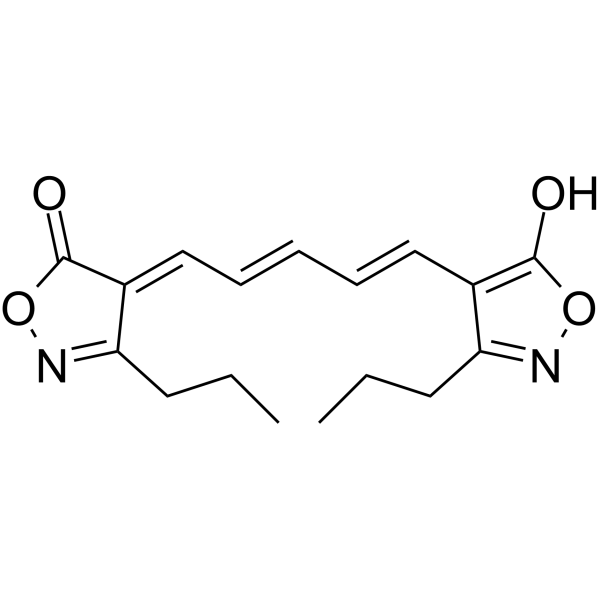
-
- HY-D0142
-
|
|
Fluorescent Dye
|
Others
|
|
Pyrene-1,3,6,8-tetrasulfonic acid tetrasodium is a fluorescent dye and pH indicator, also as a ligand of multifunctional metal-organic framework. Pyrene-1,3,6,8-tetrasulfonic acid tetrasodium has been used to detect CO2 release .
|
-

-
- HY-D1677
-
|
|
Fluorescent Dye
|
Others
|
|
5(6)-Carboxynaphthofluorescein is a pH-dependent fluorophore. 5(6)-Carboxynaphthofluorescein shows good sensitivity in an alkaline pH range and it can be exploited in the construction of fiber-optic pH sensors. 5(6)-Carboxynaphthofluorescein can be used as a fluorescent pH indicator (Ex/Em=593/668 nm) .
|
-

-
- HY-W012982S
-
|
AOZ-d4
|
Drug Metabolite
|
Others
|
|
3-Amino-2-oxazolidinone-d4 is a deuterium labeled 3-Amino-2-oxazolidinone. 3-Amino-2-oxazolidinone (AOZ) is the metabolite of Furazolidone (HY-B1336). 3-Amino-2-oxazolidinone is always be detected as an indicator of furazolidone residues[1][2].
|
-

-
- HY-D1755
-
|
|
Fluorescent Dye
|
Others
|
|
Fluo-3FF AM is a low affinity (Kd = 42 μM) fluorescent Ca 2+ sensitive indicator (Abs/Em = 462 nm/526 nm). Fluo-3FF AM is Mg 2+ insensitive and relatively photostable. Fluo-3FF AM is an analog of Fluo-3FF AM. Fluo-3FF AM is essentially non-fluorescent, but exhibits a strong fluorescence enhancement upon entry into cells and binding to calcium.
|
-
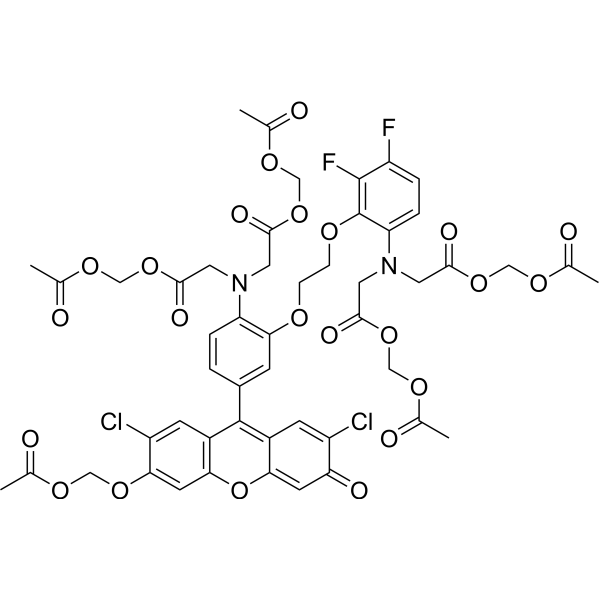
-
- HY-W021358
-
|
|
Others
|
Metabolic Disease
|
|
N,N,N′,N′-Tetramethyl-p-phenylenediamine (TMPD) is an redox indicator. N,N,N′,N′-Tetramethyl-p-phenylenediamine can be used for the research of impairment of cell respiration .
|
-
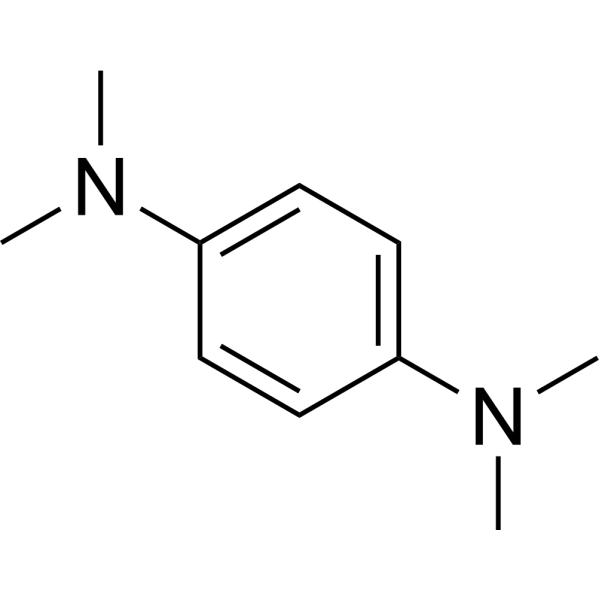
-
- HY-N8502
-
|
|
Fluorescent Dye
|
Cancer
|
|
Urdamycin A (Compound 3b) is an angucycline antibiotic that can be isolated from Streptomyces fradiae. Urdamycin A is an orange indicator with a change of the color to ultramarine blue at pH 7.7. Urdamycin A has anticancer activity with IC50s of 2.4 and 0.55 μg/mL in proliferation and stem cell assays, respectively .
|
-
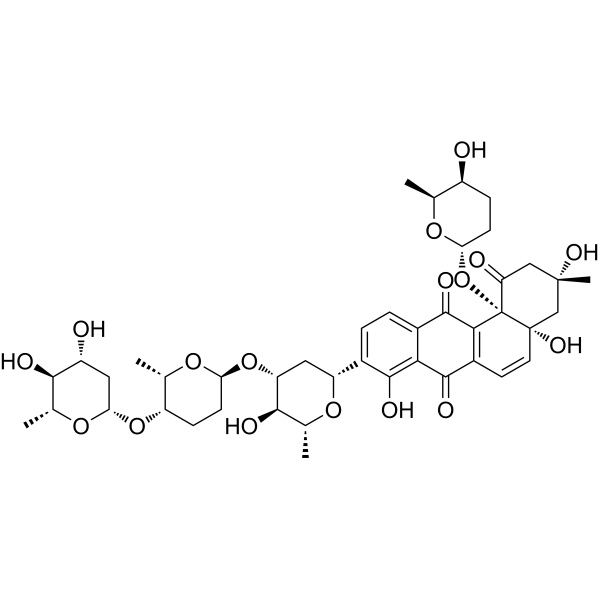
-
- HY-152696
-
|
|
Nucleoside Antimetabolite/Analog
|
Others
|
|
6-O-Methylinosine is a hypoxanthine analogue. Hypoxanthine is a kind of purine base mainly present in muscle tissue. And it is a metabolite produced by purine oxidase acting on xanthine. Hypoxanthine has typical anti-inflammatory effects and is a potential endogenous poly(ADP-ribose) polymerase (PARP) inhibitor. It is cytoprotective by inhibiting PAPR activity, inhibiting peroxynitrite-induced mitochondrial depolarization and secondary superoxide production. Hypoxanthine can also be used as an indicator of hypoxia .
|
-

-
- HY-D1536
-
|
|
Fluorescent Dye
|
Neurological Disease
|
|
Glycine cresol red is a complexometric indicator. Glycine cresol red forms coloured complexes with Al 3+, Ga 3+ and In 3+ ions in aqueous solutions. Glycine cresol red can been used for the spectrophotometric determination of inorganic ions. Glycine cresol red can be used as a stain in neurohistology .
|
-
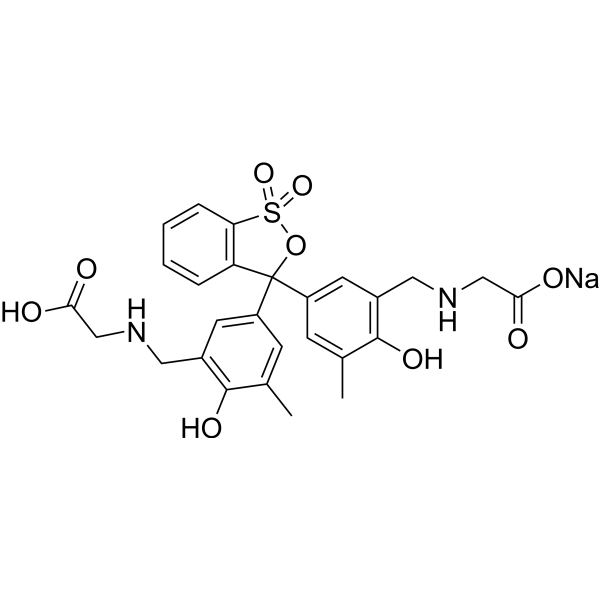
-
- HY-D1055
-
|
|
Fluorescent Dye
Reactive Oxygen Species
Mitochondrial Metabolism
|
Cancer
|
MitoSOX Red is a live cell fluorescent probe that specifically targets mitochondria and is cell membrane permeable. MitoSOX Red enters mitochondria and is oxidized by superoxide but not by other ROS or RNS generating systems. The oxidized MitoSOX Red then binds to nucleic acids in mitochondria/nucleus, producing strong red fluorescence. MitoSOX Red can be used as a fluorescent indicator to specifically detect superoxide. In addition, superoxide dismutase (SOD) can prevent the oxidation of MitoSOX Red.
Excitation/emission wavelength: 510/580 nm.
|
-
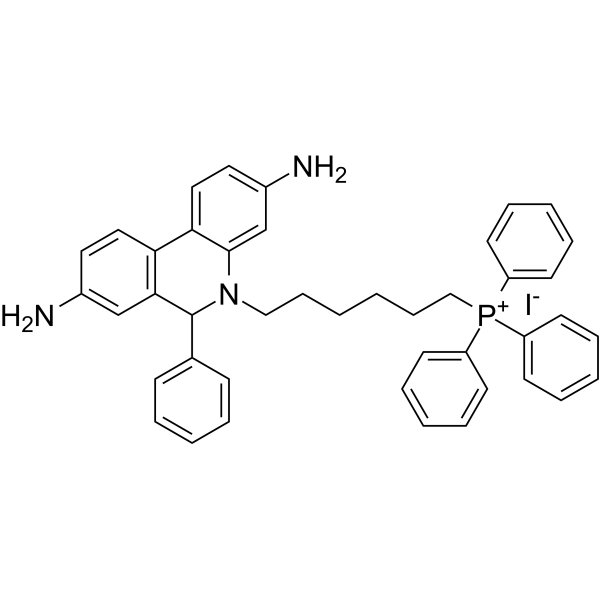
-
- HY-W039271
-
|
2-Chloro-6-O-methyl-inosine
|
Nucleoside Antimetabolite/Analog
|
Cancer
|
|
2-Chloro-6-methoxypurine riboside is a hypoxanthine analog. Hypoxanthine is a kind of purine base mainly present in muscle tissue. And it is a metabolite produced by purine oxidase acting on xanthine. Hypoxanthine has typical anti-inflammatory effects and is a potential endogenous poly(ADP-ribose) polymerase (PARP) inhibitor. It is cytoprotective by inhibiting PAPR activity, inhibiting peroxynitrite-induced mitochondrial depolarization and secondary superoxide production. Hypoxanthine can also be used as an indicator of hypoxia .
|
-

-
- HY-154017
-
|
|
Nucleoside Antimetabolite/Analog
|
Cancer
|
|
2′-C-Methyl-6-O-methylinosine is a hypoxanthine analog. Hypoxanthine is a kind of purine base mainly present in muscle tissue. And it is a metabolite produced by purine oxidase acting on xanthine. Hypoxanthine has typical anti-inflammatory effects and is a potential endogenous poly(ADP-ribose) polymerase (PARP) inhibitor. It is cytoprotective by inhibiting PAPR activity, inhibiting peroxynitrite-induced mitochondrial depolarization and secondary superoxide production. Hypoxanthine can also be used as an indicator of hypoxia .
|
-

-
- HY-154393
-
|
|
Nucleoside Antimetabolite/Analog
|
Cancer
|
|
2-Chloro-2'-deoxy-6-O-methylinosine is a hypoxanthine analog. Hypoxanthine is a kind of purine base mainly present in muscle tissue. And it is a metabolite produced by purine oxidase acting on xanthine. Hypoxanthine has typical anti-inflammatory effects and is a potential endogenous poly(ADP-ribose) polymerase (PARP) inhibitor. It is cytoprotective by inhibiting PAPR activity, inhibiting peroxynitrite-induced mitochondrial depolarization and secondary superoxide production. Hypoxanthine can also be used as an indicator of hypoxia .
|
-
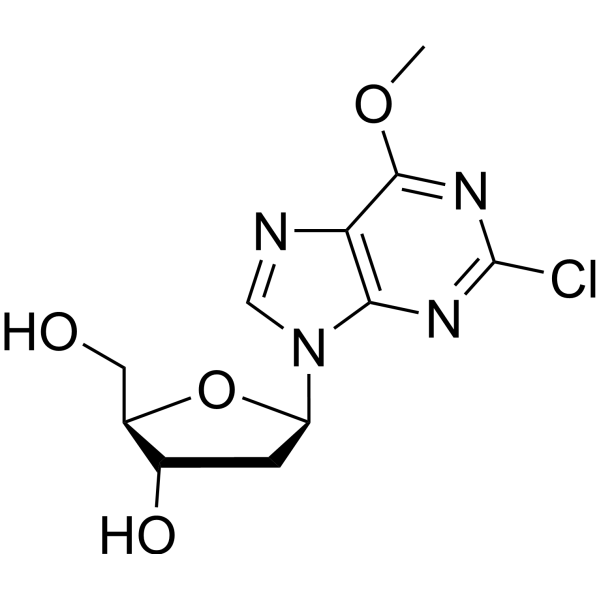
-
- HY-152678
-
|
|
Nucleoside Antimetabolite/Analog
|
Cancer
|
|
6-Methoxypurine-9-β-D-5’(R)-C-methylriboside is a hypoxanthine analog. Hypoxanthine is a kind of purine base mainly present in muscle tissue. And it is a metabolite produced by purine oxidase acting on xanthine. Hypoxanthine has typical anti-inflammatory effects and is a potential endogenous poly(ADP-ribose) polymerase (PARP) inhibitor. It is cytoprotective by inhibiting PAPR activity, inhibiting peroxynitrite-induced mitochondrial depolarization and secondary superoxide production. Hypoxanthine can also be used as an indicator of hypoxia .
|
-
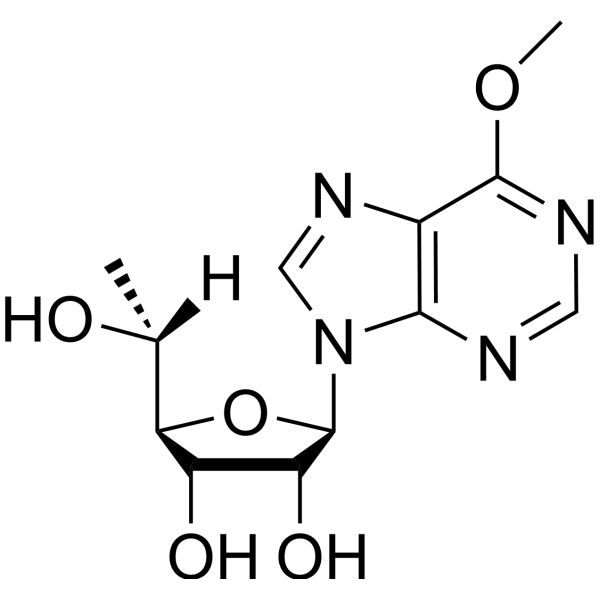
-
- HY-W141392
-
|
|
Nucleoside Antimetabolite/Analog
|
Cancer
|
|
2'-Fluoro-5'-O-DMT-2'-deoxyinosine-3'-CE-phosphoramidite is a hypoxanthine analog. Hypoxanthine is a kind of purine base mainly present in muscle tissue. And it is a metabolite produced by purine oxidase acting on xanthine. Hypoxanthine has typical anti-inflammatory effects and is a potential endogenous poly(ADP-ribose) polymerase (PARP) inhibitor. It is cytoprotective by inhibiting PAPR activity, inhibiting peroxynitrite-induced mitochondrial depolarization and secondary superoxide production. Hypoxanthine can also be used as an indicator of hypoxia .
|
-
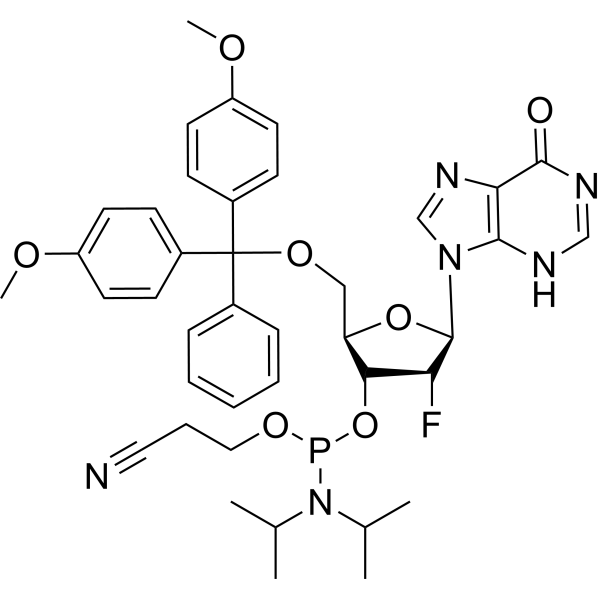
-
- HY-W392836
-
|
|
Nucleoside Antimetabolite/Analog
|
Cancer
|
|
2'-O-Methyl-5'-O-dmt-inosine-3'-CE-phosphoramidite is a hypoxanthine analog. Hypoxanthine is a kind of purine base mainly present in muscle tissue. And it is a metabolite produced by purine oxidase acting on xanthine. Hypoxanthine has typical anti-inflammatory effects and is a potential endogenous poly(ADP-ribose) polymerase (PARP) inhibitor. It is cytoprotective by inhibiting PAPR activity, inhibiting peroxynitrite-induced mitochondrial depolarization and secondary superoxide production. Hypoxanthine can also be used as an indicator of hypoxia .
|
-
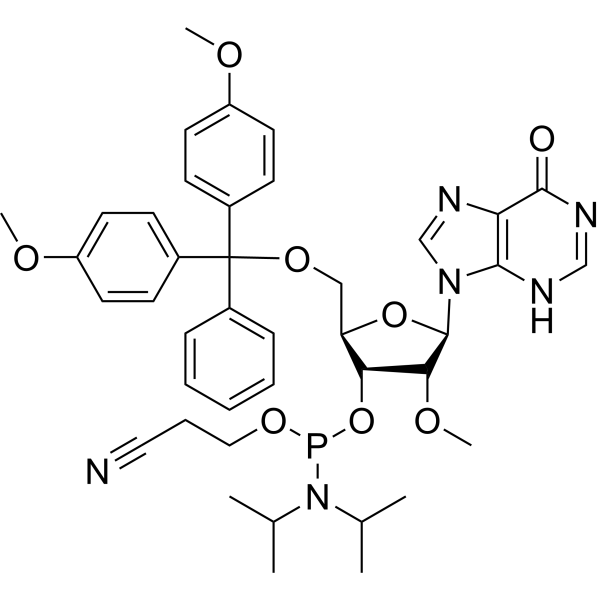
-
- HY-D0166
-
|
|
Fluorescent Dye
|
Others
|
|
Neutral Red, a nitrogenous pH-indicator with a pKi of 6.8, is an indicator for the internal acidification of thylakoids. Neutral Red stains lysosomes red .
|
-
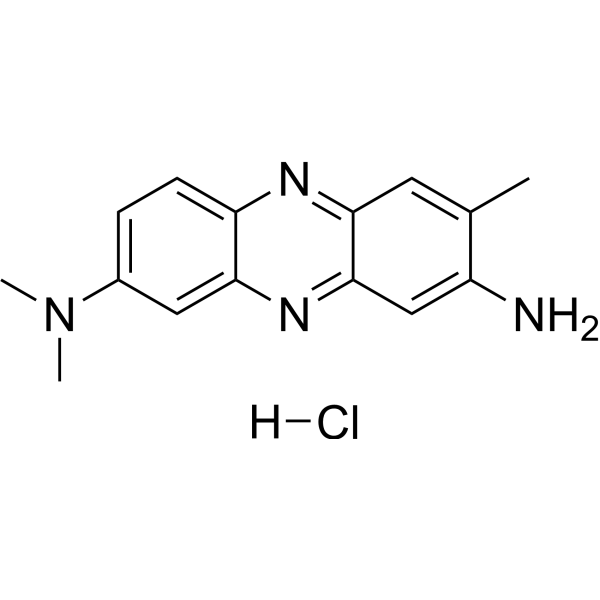
- HY-W110917
-
|
|
Biochemical Assay Reagents
|
Others
|
|
Dimethylsulfonazo III is a potent sulfate indicator. Dimethylsulfonazo III can be used as indicator to test those samples contaminated with potassium or phosphate ions .
|
-
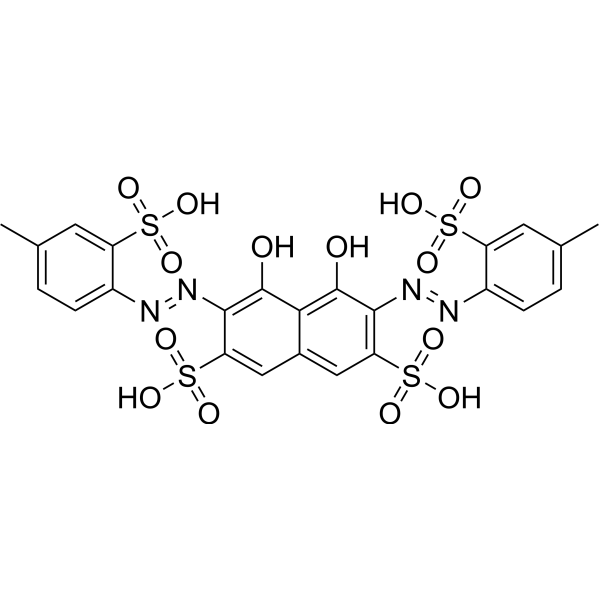
- HY-D0040
-
Calcein
4 Publications Verification
Fluorexon
|
Fluorescent Dye
|
Others
|
|
Calcein is a fluorescent dye and self-quenching probe, used as an indicator of lipid vesicle leakage, and also as a complexometric indicator for titration of calcium ions with EDTA, and for fluorometric determination of calcium.
|
-

- HY-D0012
-
-

- HY-D0948
-
|
|
Fluorescent Dye
|
Infection
|
|
Celestine Blue is a electroactive indicator in DNA biosensors. Celestine Blue is strongly adsorbed on the spinel phases and CNT (carbon nanotubes), facilitates dispersion, acts as a capping agent and allows for the fabrication of spinel decorated CNT. Celestine Blue is an efficient charge transfer mediator, which allows for significant improvement of capacitive behavior. TiO2 nanoparticles doped with Celestine Blue can be used as a label in a sandwich immunoassay for the hepatitis C virus (HCV) core antigen .
|
-

- HY-W331502
-
-
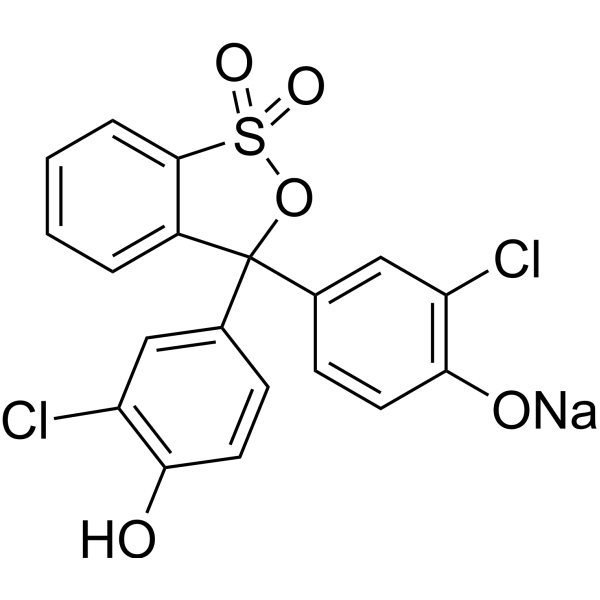
- HY-D1176
-
|
|
Fluorescent Dye
|
Others
|
|
Calcium Green 1AM is a cell-permeant fluorescent calcium indicator (Excitation 506 nm; Emission 531 nm). Calcium Green 1AM is converted to the fluorescent calcium indicator by intracellular esterases .
|
-
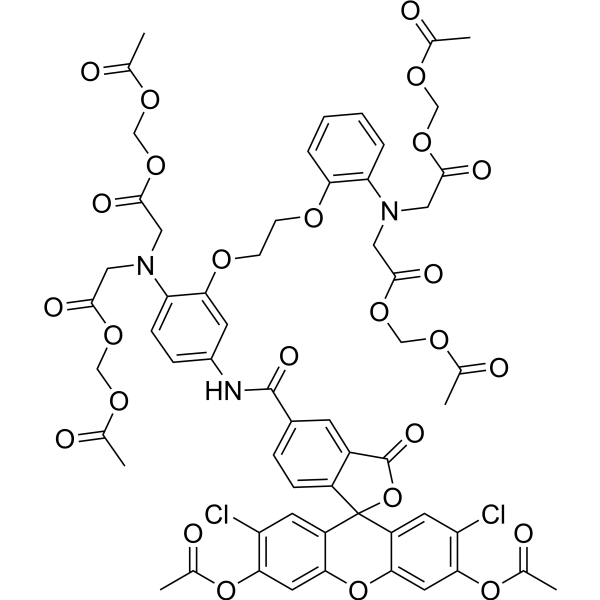
- HY-D0211
-
-
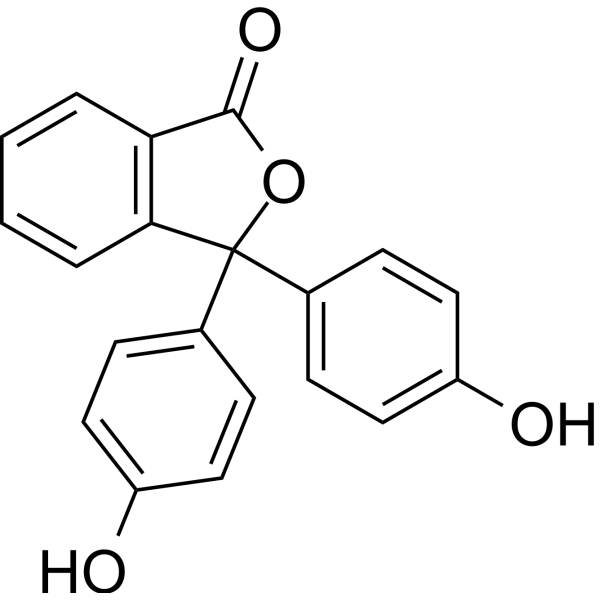
- HY-D1445
-
|
|
Fluorescent Dye
|
Metabolic Disease
|
|
PDMPO, a lysosome pH indicator, is an excellent fluorescent acidotropic reagent for fluorescence imaging. PDMPO is a potent tool with which to study acidic organelles of live cells. PDMPO exhibits pH-dependent dual-excitation and dual-emission spectral peaks. PDMPO produces a blue fluorescence in weakly acidic organelles and shifts to yellow in more acidic lysosomes (Abs=329 nm; Em=440 nm) .
|
-
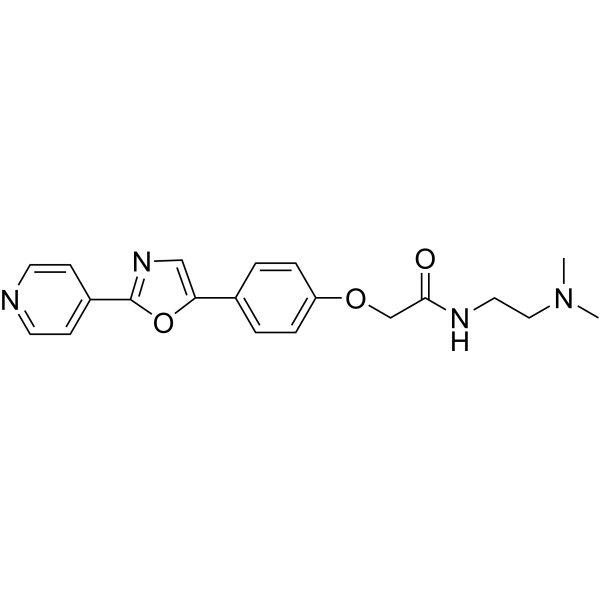
- HY-D0284
-
-
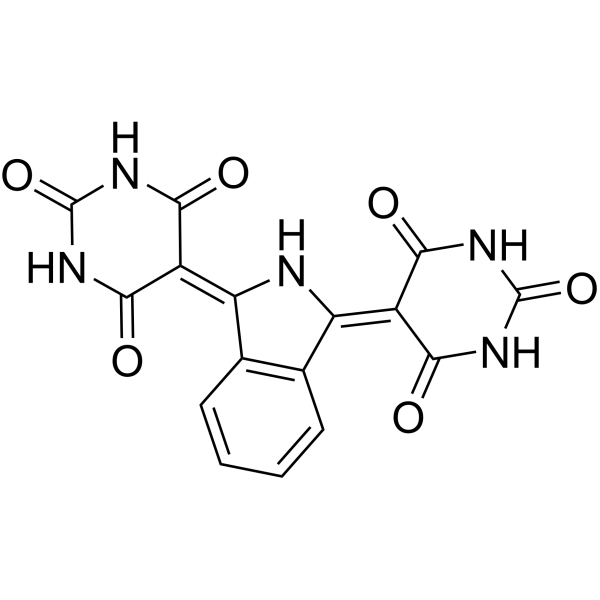
- HY-W110798
-
|
|
Biochemical Assay Reagents
|
Others
|
|
Bromophenol blue indicator (3.0-4.6) is a synthetic dye commonly used as an acid-base indicator with a transition range of pH 3.0-4.6. Bromophenol blue indicator (3.0-4.6) is water soluble and changes color from yellow to blue as the pH of the solution changes from acidic to basic. Its unique chemical properties make it an important ingredient in a variety of scientific applications, especially in biochemistry and molecular biology. In addition, it can be used as a stain in microbiology and histology. However, Bromophenol blue indicator (3.0-4.6) has potential irritating and staining properties.
|
-

- HY-103395
-
|
Methylpropanedioic acid; Methylmalonate
|
Endogenous Metabolite
|
Cancer
|
|
Methylmalonic acid (Methylmalonate) is an indicator of Vitamin B-12 deficiency in cancer.
|
-

- HY-101896
-
-
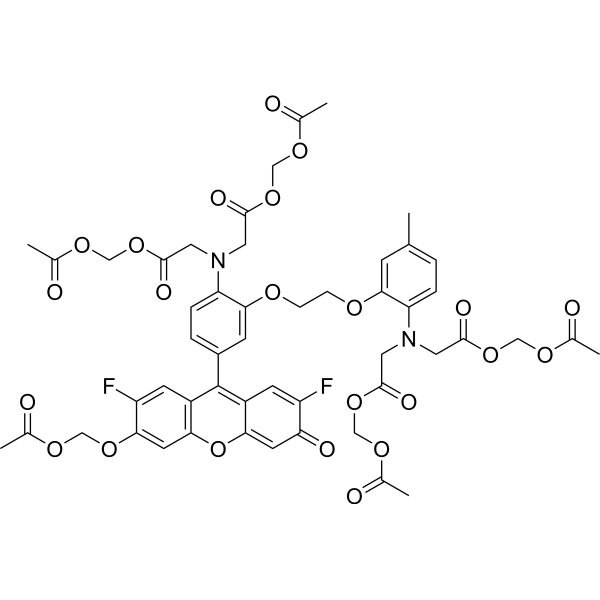
- HY-32349
-
-

- HY-D0801
-
|
|
Fluorescent Dye
|
Others
|
|
Calmagite is a complexometric indicator which can be used to detect calcium and magnesium in various samples.
|
-

- HY-N0091
-
|
Purin-6-ol; Sarcine
|
Endogenous Metabolite
|
Others
|
|
Hypoxanthine, a purine derivative, is a potential free radical generator and could be used as an indicator of hypoxia.
|
-
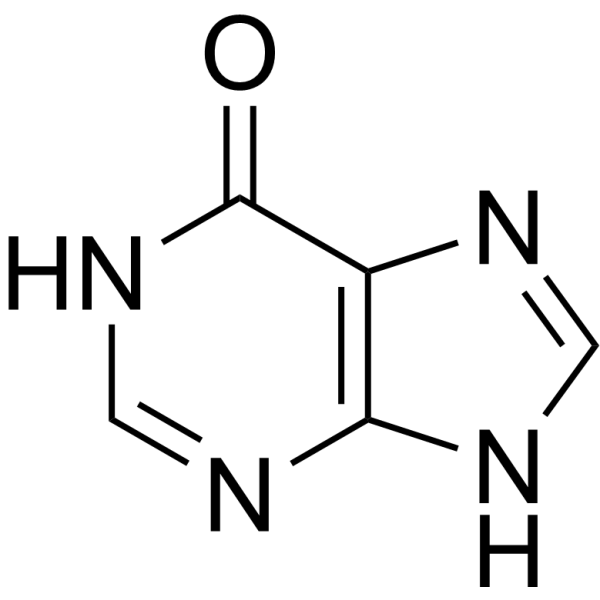
- HY-D1401
-
|
|
Fluorescent Dye
|
Others
|
|
OG 488, acid, a fluorescent pH indicator, has many applications in biochemistry and neurosciences .
|
-
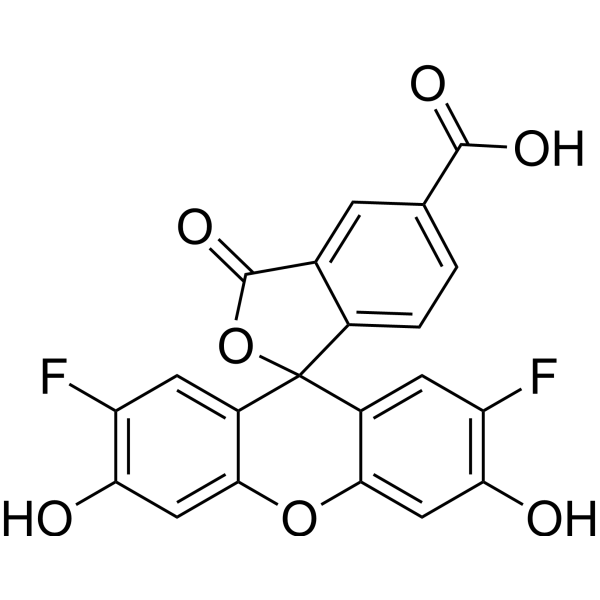
- HY-D1779
-
-
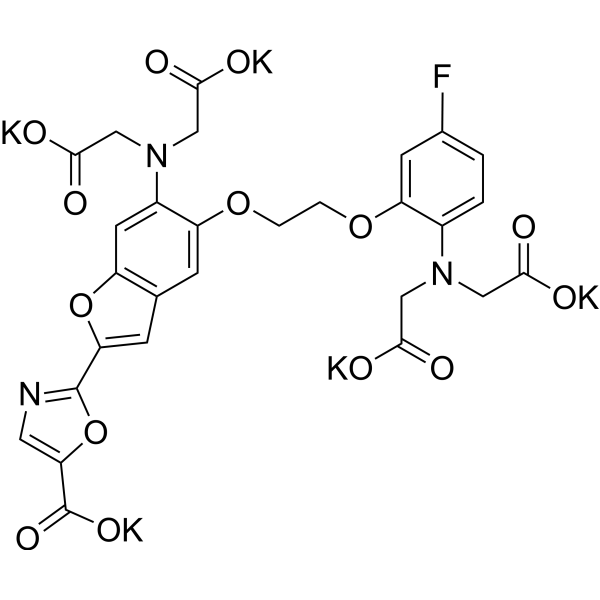
- HY-118103
-
|
Coprostan-3-ol
|
Endogenous Metabolite
|
Others
|
|
Coprostanol (Coprostan-3-ol) is a fecal sterol formed by microbial reduction of cholesterol in the intestines of man and higher animals. Coprostanol can be used as an indicator sterol of fecal pollution. Coprostanol has been recognized as a good indicator of pollution of water resources by sewage discharges .
|
-
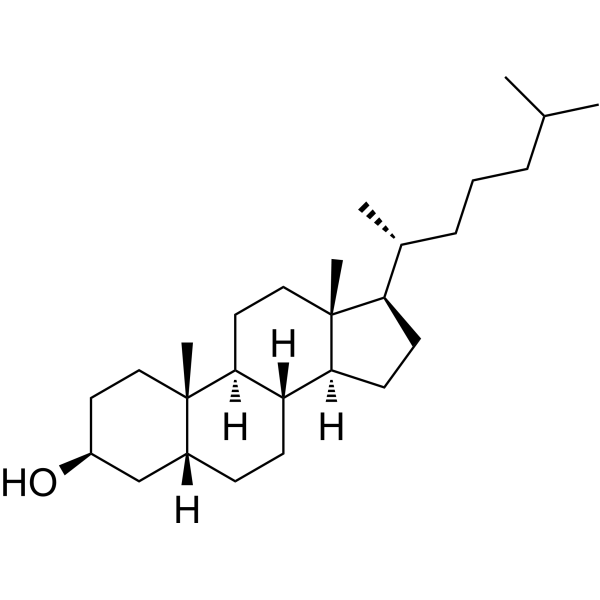
- HY-113486
-
-
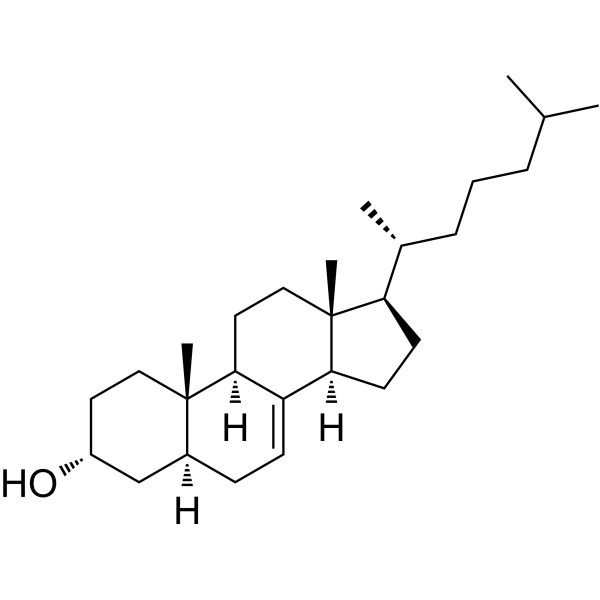
- HY-101883
-
|
|
Fluorescent Dye
|
Others
|
|
BCECF-AM is a cell membrane permeable compound widely used as a fluorescent indicator for intracellular pH.
|
-
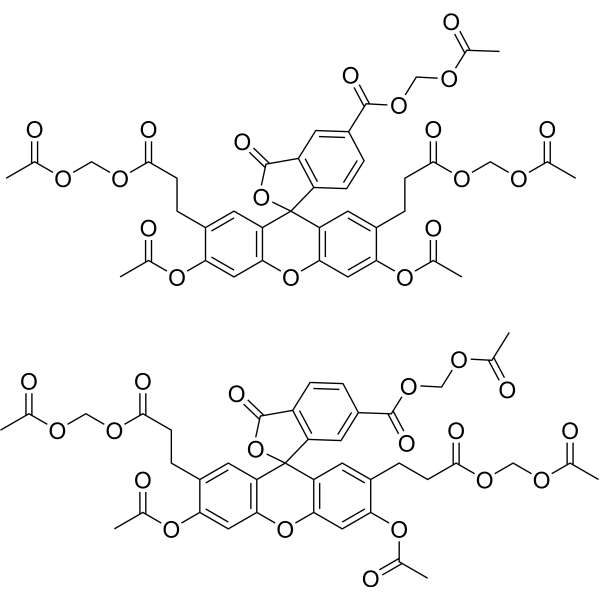
- HY-D0081A
-
-
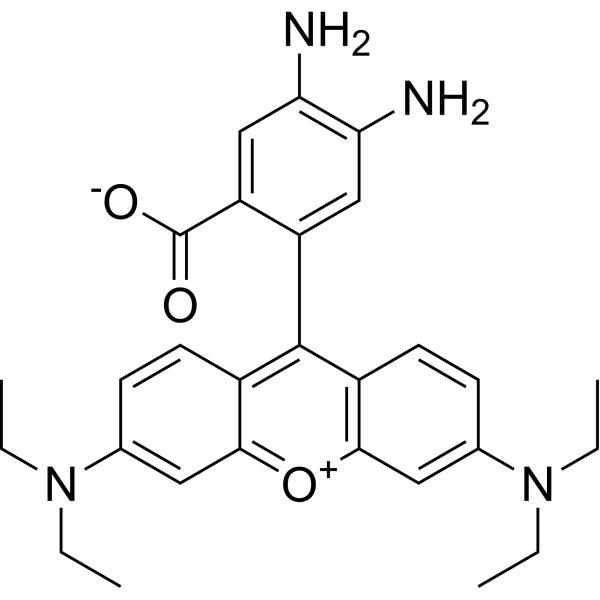
- HY-D1502
-
-
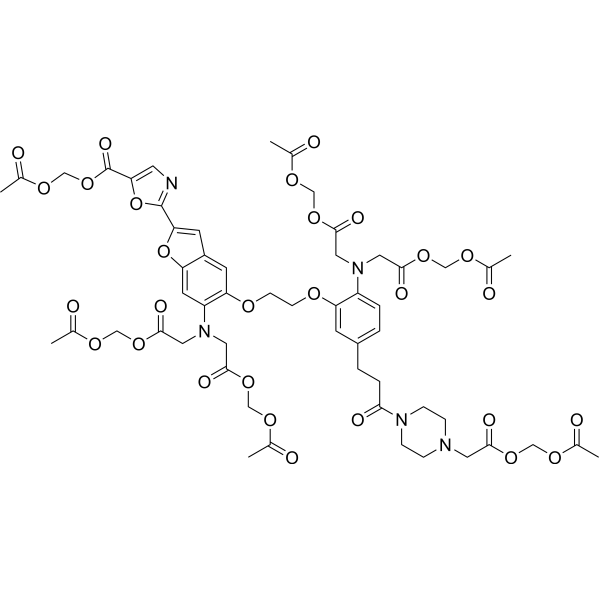
- HY-D1750
-
|
|
Fluorescent Dye
|
Others
|
|
Rhodamine B thiolactone is a high-sensitive Hg 2+ indicator used for measuring Hg 2+ concentration.
|
-
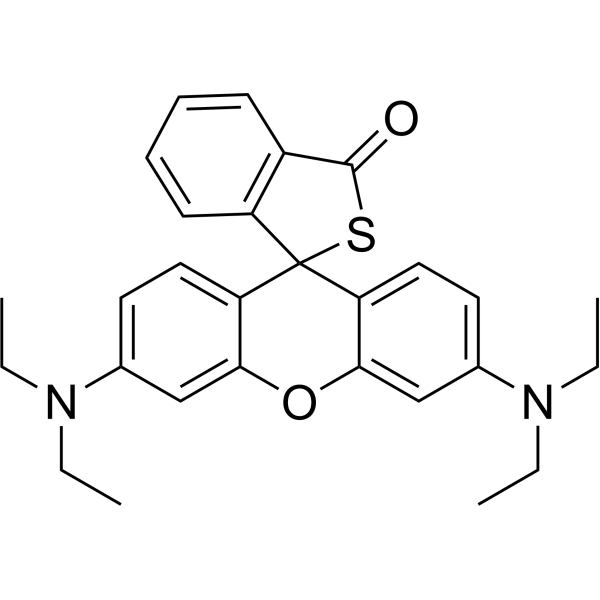
- HY-D1776
-
|
|
Fluorescent Dye
|
Others
|
|
FFP-18-AM is a cell-permeable fluorescent indicator for measurement of near-membrane calcium.
|
-
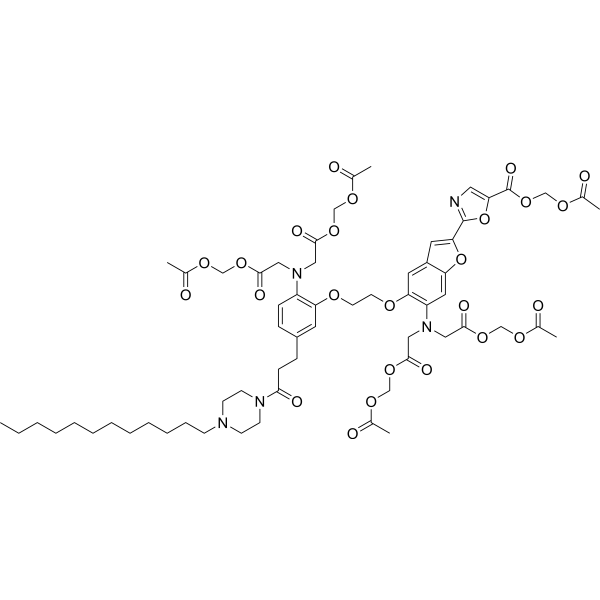
- HY-126831
-
|
|
Fluorescent Dye
|
Others
|
|
SBFI-AM is a Na + selective fluorescent indicator. SBFI-AM shows selectivity for Na + over K + .
|
-
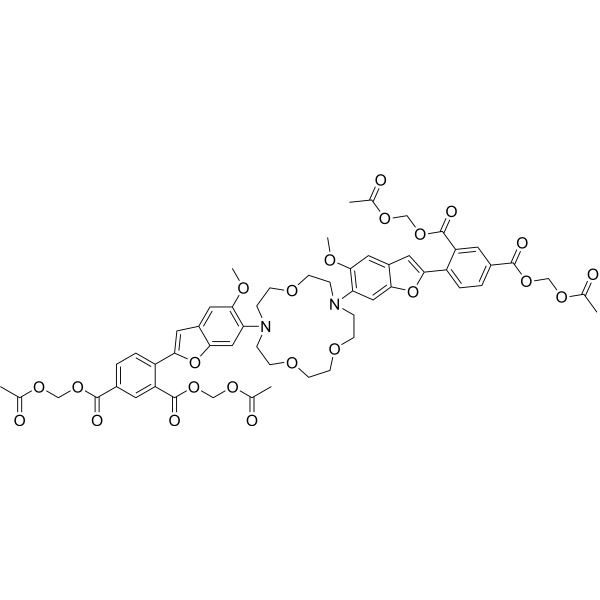
- HY-111391A
-
|
Diazoresorcinol (sodium), indicator
|
Biochemical Assay Reagents
|
Others
|
|
Resazurin sodium salt, indicator is a biochemical reagent that can be used as a biological material or organic compound for life science related research.
|
-
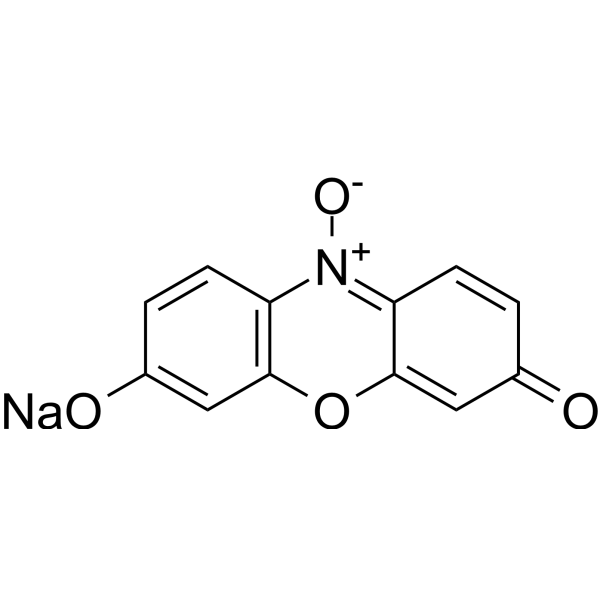
- HY-D1761
-
|
|
Fluorescent Dye
|
Others
|
|
Fura-4F pentapotassium is a cell-impermeant fluorescent indicator for intracellular calcium ion measurement.
|
-
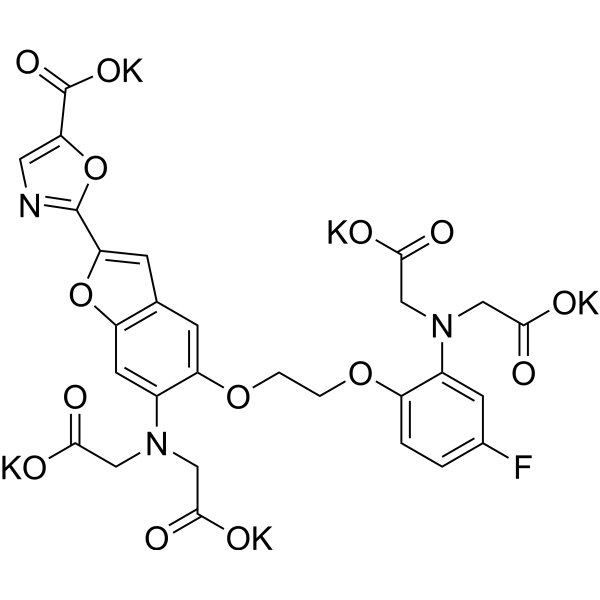
- HY-B1178
-
|
(-)-Cotinine; (S)-Cotinine; NIH-10498
|
Endogenous Metabolite
|
Cancer
|
|
Cotinine ((-)-Cotinine), an alkaloid in tobacco and a major metabolite of nicotine, is used as a biological indicator to measure the composition of tobacco smoke
|
-

- HY-101897
-
|
Fura-2 Acetoxymethyl ester
|
Fluorescent Dye
|
Others
|
|
Fura-2 AM is a high affinity, intracellular, UV light-excitable and ratiometric fluorescent Ca 2+ indicator.
|
-
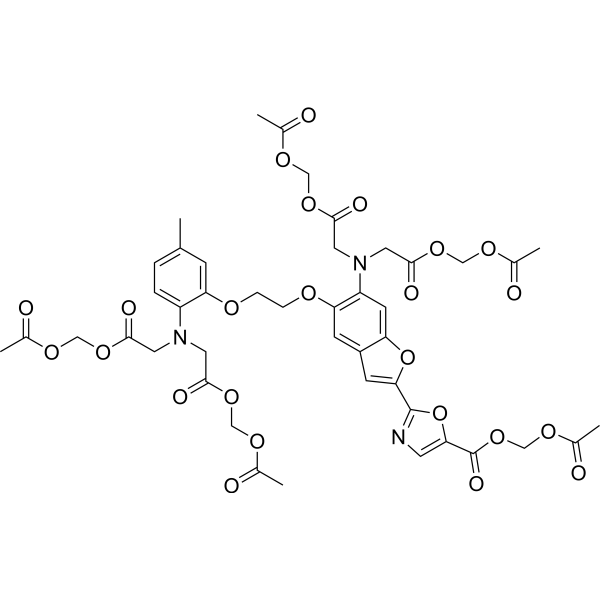
- HY-B1307
-
|
|
Cytochrome P450
|
Neurological Disease
|
|
Zoxazolamine is widely used for a pharmacologic test that serves as a convenient indicator of changes in cytochrome P-450 activity in rodents.
|
-
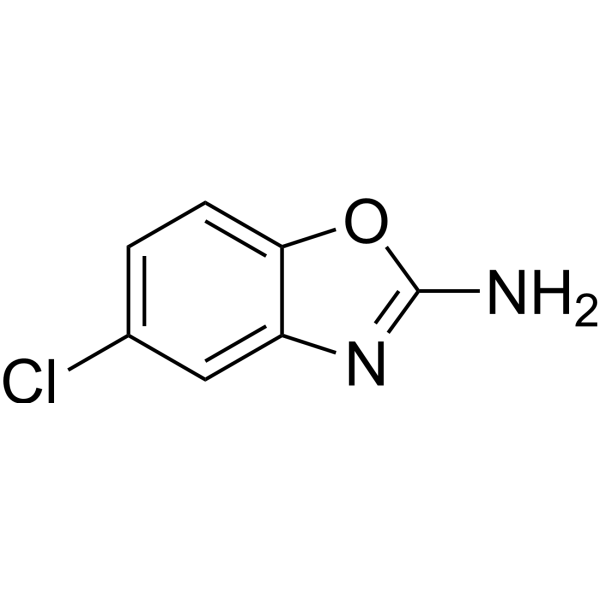
- HY-W017006
-
-
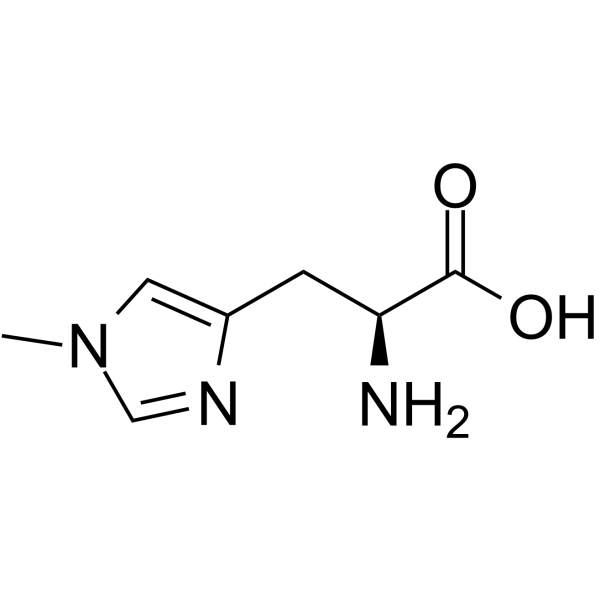
- HY-B1359A
-
|
|
Biochemical Assay Reagents
|
Others
|
|
Methylene blue indicator is a biochemical reagent that can be used as a biological material or organic compound for life science related research.
|
-
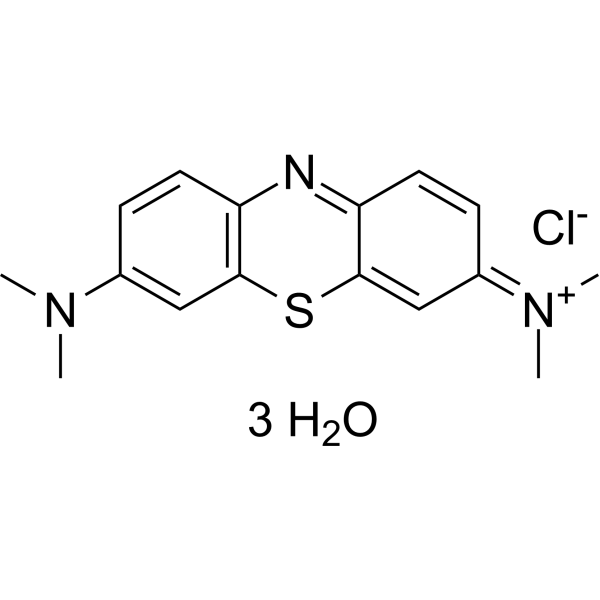
- HY-124350
-
-
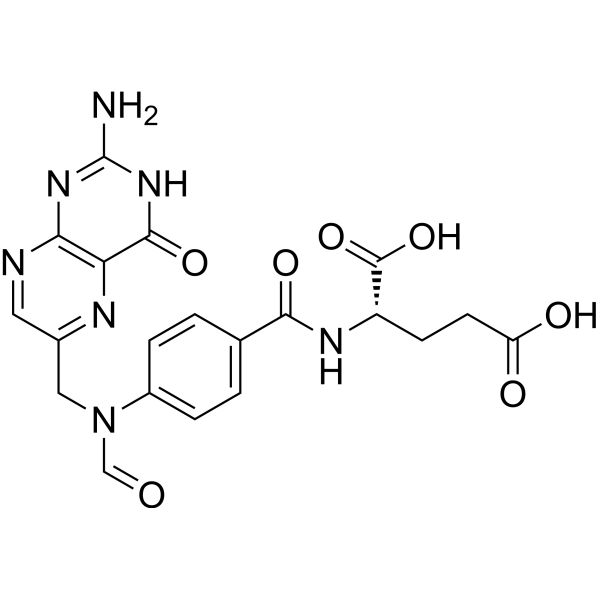
- HY-B1422
-
|
Aminacrine
|
Bacterial
HIV
|
Infection
|
|
9-Aminoacridine, a fluorescent probe, acts as an indicator of pH for quantitative determination of transmembrane pH gradients (inside acidic). 9-Aminoacridine is an antimicrobial. 9-Aminoacridine exerts its antimicrobial activity by interacting with specific bacterial DNA and disrupting the proton motive force in K. pneumoniae. 9-Aminoacridine is a HIV-1 inhibitor and inhibits HIV LTR transcription highly dependent on the presence and location of the amino moiety. 9-Aminoacridine inhibits virus replication in HIV-1 infected cell lines. 9-Aminoacridine is used as a Rifampin (RIF; HY-B0272) adjuvant for the multidrug-resistant K. pneumoniae infections .
|
-
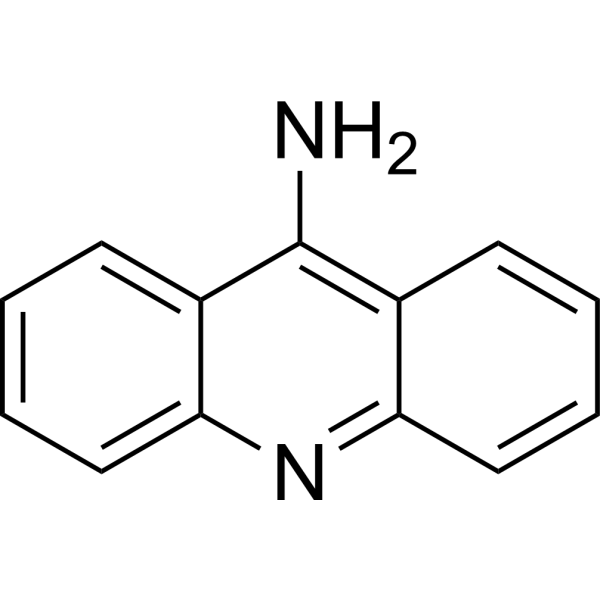
- HY-133527
-
|
Oregon green 488 succinimidyl ester
|
Fluorescent Dye
|
Neurological Disease
|
|
OG 488, SE (Oregon green 488 succinimidyl ester), a fluorescent pH indicator, has many applications in biochemistry and neurosciences .
|
-
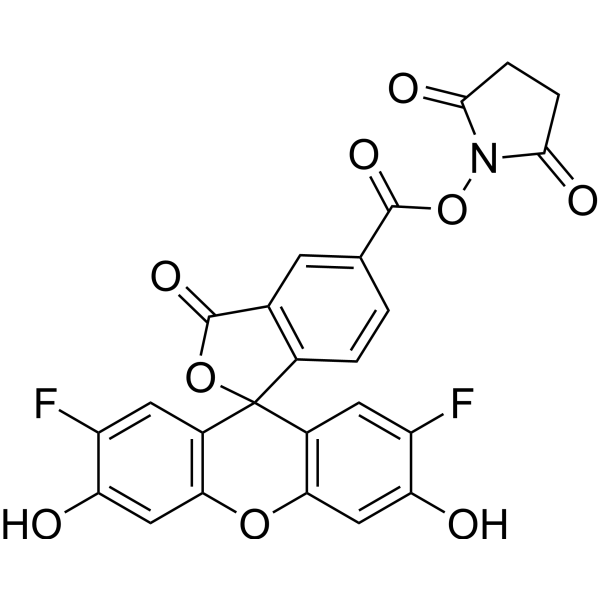
- HY-D0309A
-
|
Basic Red 1 (indicator)
|
Biochemical Assay Reagents
|
Others
|
|
Rhodamine 6G, indicator is a biochemical reagent that can be used as a biological material or organic compound for life science related research.
|
-

- HY-130575
-
|
|
Fluorescent Dye
|
Others
|
|
Fura-FF AM is a cell-permeable acetoxymethyl ester of fura-FF, a dluorescent calcium indicator. Fura-FF AM is hydrolyzed by intracellular esterases to release fura-FF in cells. Fura-FF is a difluorinated derivative of the calcium indicator fura-2. Compared to fura-2, fura-FF has a low affinity for calcium and is suitable for studying compartments with high concentrations of calcium.
|
-
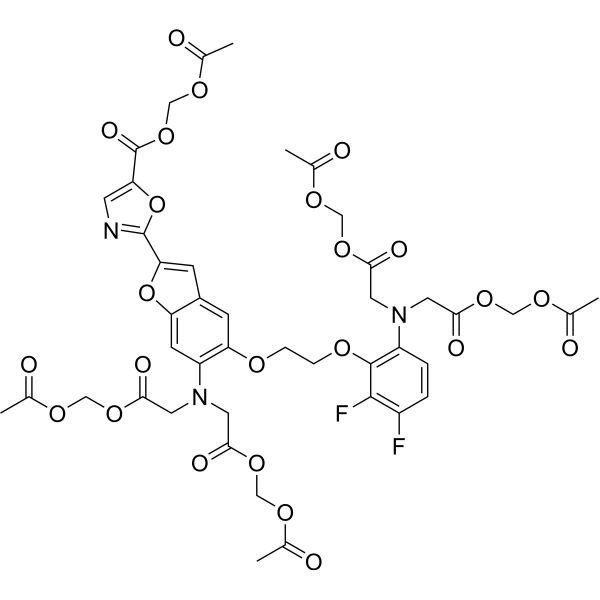
- HY-115773
-
|
NMTPRO; N-Nitroso-2-methylthiazolidine 4-carboxylic acid; N-nitrosomethylthioproline
|
Endogenous Metabolite
|
Metabolic Disease
|
|
NMTCA (NMTPRO) is a sulfur-containing N-nitrosamino acid. NMTCA can be used as an indicator of endogenous nitrosation by gas chromatography-thermalenergyanalysis .
|
-
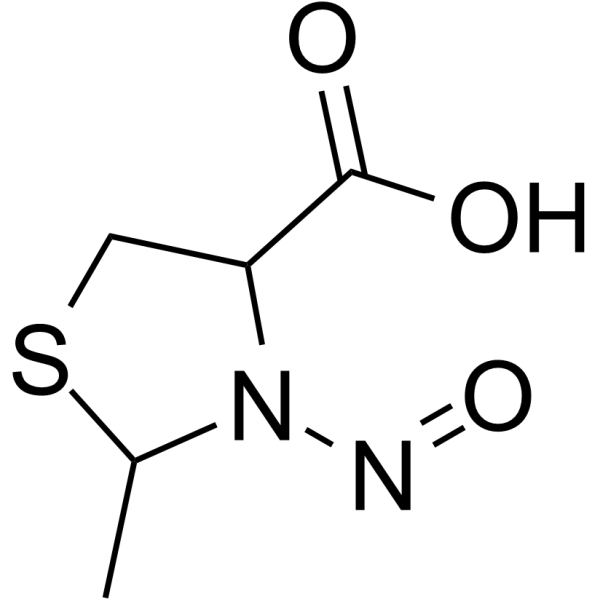
- HY-W110896
-
|
Phthalein Purple
|
Biochemical Assay Reagents
|
Others
|
|
Phthalate complexing agent [Chelation indicator] is a biochemical reagent that can be used as a biological material or organic compound for life science related research.
|
-
![Phthalate complexing agent [Chelation <em>indicator</em>]](//file.medchemexpress.com/product_pic/hy-w110896.gif)
- HY-D0110A
-
|
|
Fluorescent Dye
|
Others
|
|
Fura-2 pentapotassium is a scaled fluorescent dye that can be used for intracellular calcium imaging with the Kd value of 140 nM. Fura-2 pentapotassium has an emission wavelength of 510 nm and excitation wavelengths of 340 nm or 380 nm and the ratio of 340/380 fluorescence intensity is proportional to the intracellular Ca 2+ level .
|
-
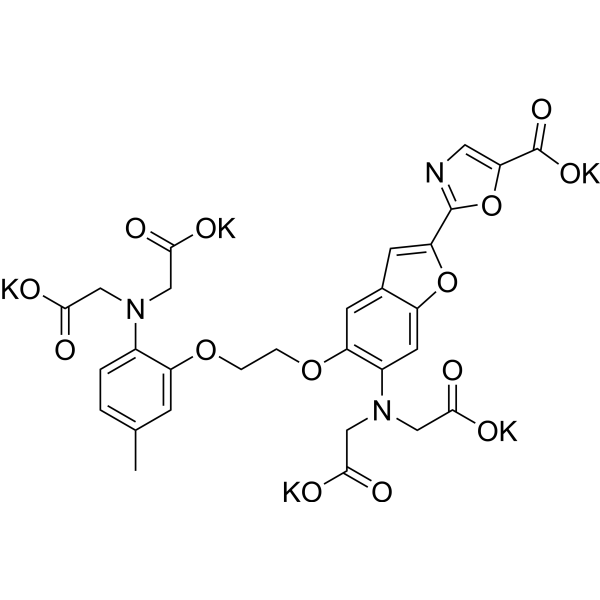
- HY-108398A
-
|
5,8,11-Eicosatrienoic acid
|
Others
|
Metabolic Disease
Cancer
|
|
Mead acid (5,8,11-Eicosatrienoic acid), an unsaturated (Omega-9) fatty acid, is an indicator of essential fatty acid deficiency .
|
-
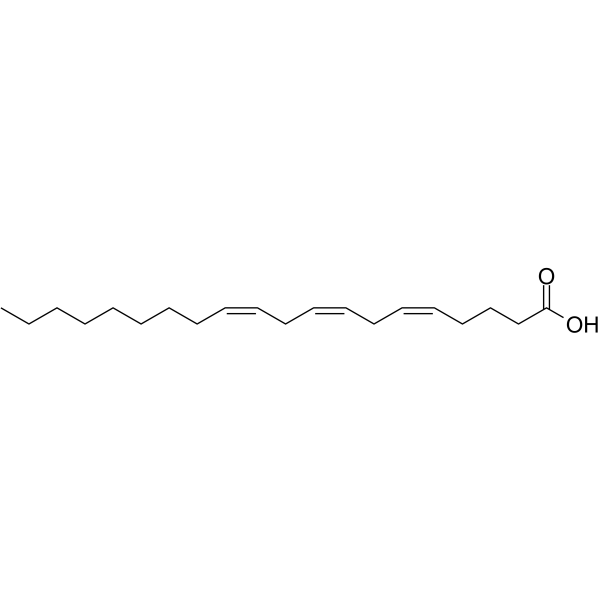
- HY-B2033S1
-
|
|
Fungal
Isotope-Labeled Compounds
|
Others
|
|
Pyrimethanil-d5 is the deuterium labeled Hypoxanthine. Hypoxanthine, a purine derivative, is a potential free radical generator and could be used as an indicator of hypoxia.
|
-
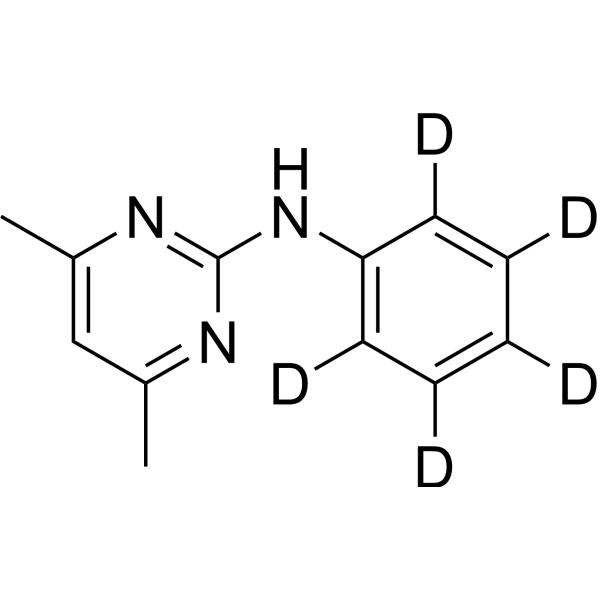
- HY-D1477
-
|
|
Fluorescent Dye
|
Others
|
|
5(6)-Carboxyfluorescein diisobutyrate is a protected 5(6)-carboxyfluorescein. 5(6)-carboxyfluorescein is a fluorescence pH indicator .
|
-
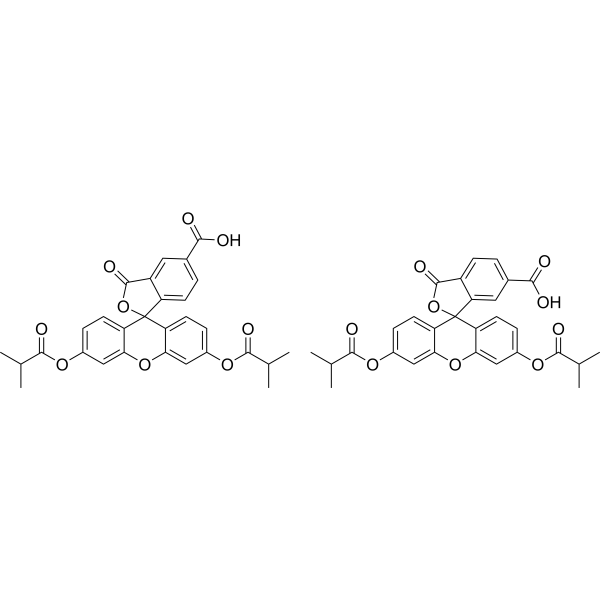
- HY-D0285
-
|
PTCDI
|
Fluorescent Dye
|
Others
|
|
3,4,9,10-Perylenetetracarboxylic-diimide (PTCDI), an organic heteropolycyclic compound, is a dimethylimine that can be used in biological dyes and indicators .
|
-
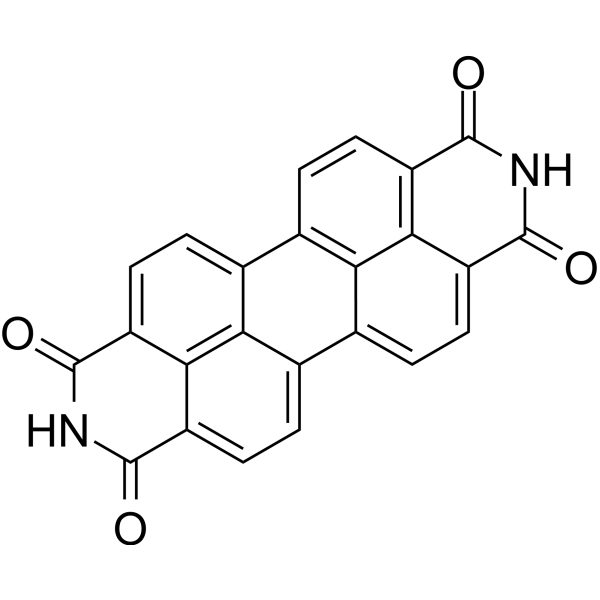
- HY-W110883
-
|
|
Biochemical Assay Reagents
|
Others
|
|
Xylenol Orange (tetrasodium), metal indicator, AR is a biochemical reagent that can be used as a biological material or organic compound for life science related research.
|
-
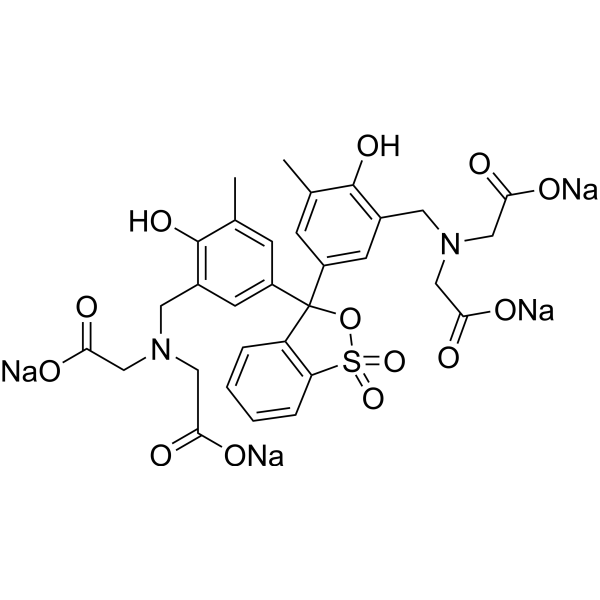
- HY-12509
-
|
|
iGluR
|
Neurological Disease
|
|
PEPA is an allosteric modulator of AMPA receptors; binds to the GluA2o and GluA3o LBDs and can be utilized as an indicator of AMPA receptor heterogeneity.
|
-
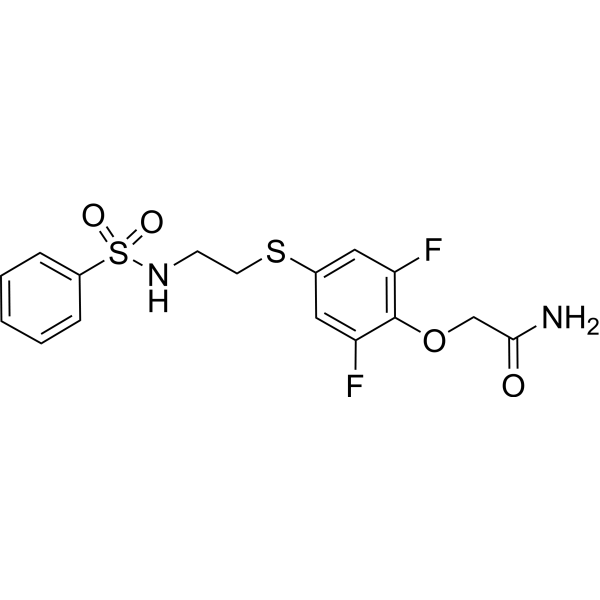
- HY-101887
-
|
|
Fluorescent Dye
|
Others
|
|
Calcein Blue, a membrane-impermeant fluorescent dye, is a coumarin derivative that contains an iminodiacetic acid structure. Calcein Blue is also a metallofluorochromic indicator .
|
-

- HY-W110884
-
|
|
Biochemical Assay Reagents
|
Others
|
|
Eriochrome cyanine R indicator (C.I. 43820) is a biochemical reagent that can be used as a biological material or organic compound for life science related research.
|
-
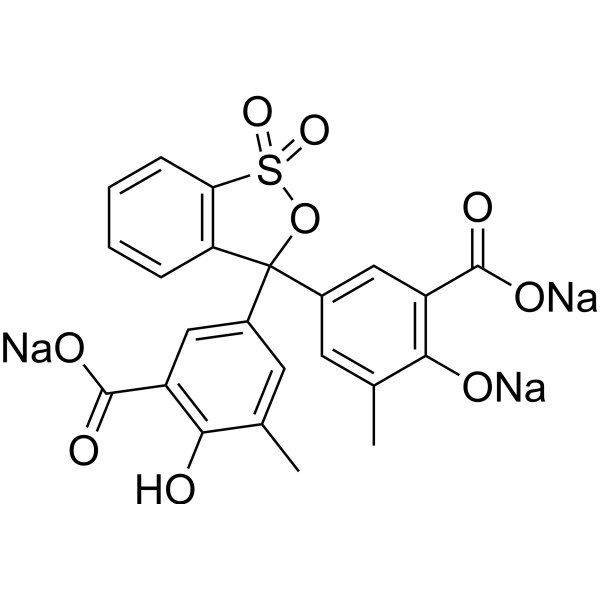
- HY-W110927
-
|
|
Biochemical Assay Reagents
|
Others
|
|
Alizarin red S indicator (C.I. 58005) is a biochemical reagent that can be used as a biological material or organic compound for life science related research.
|
-
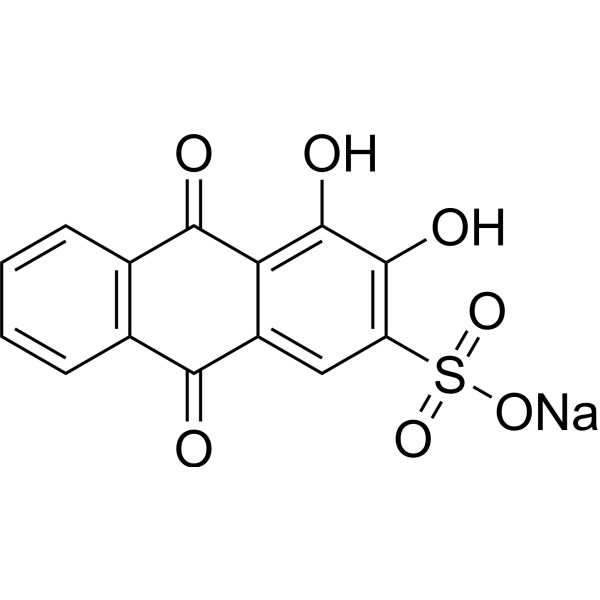
- HY-103395R
-
|
Methylpropanedioic acid (Standard); Methylmalonate (Standard)
|
Endogenous Metabolite
|
Cancer
|
|
Methylmalonic acid (Standard) is the analytical standard of Methylmalonic acid. This product is intended for research and analytical applications. Methylmalonic acid (Methylmalonate) is an indicator of Vitamin B-12 deficiency in cancer.
|
-
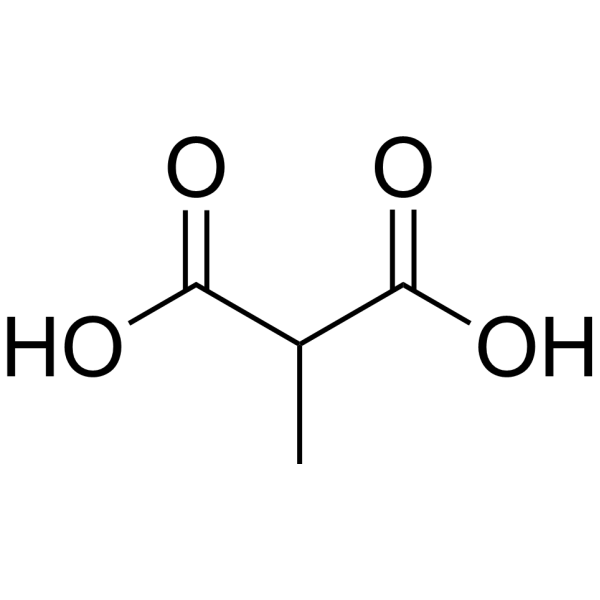
- HY-103395S
-
|
Methylpropanedioic acid-d3; Methylmalonate-d3
|
Endogenous Metabolite
|
Cancer
|
|
Methylmalonic acid-d3 is the deuterium labeled Methylmalonic acid. Methylmalonic acid (Methylmalonate) is an indicator of Vitamin B-12 deficiency in cancer[1][2].
|
-

- HY-W025785
-
|
Solvent Yellow 2; Dimethyl yellow
|
Others
|
Others
|
|
Methyl yellow (Solvent Yellow 2) is a pH indicator. Methyl yellow appears red at low pH, and becomes yellow above pH 4.0 .
|
-
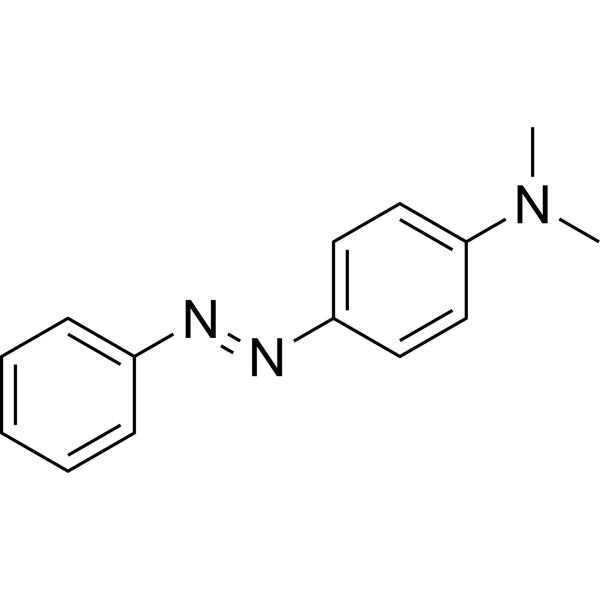
- HY-B1727
-
|
|
|
|
|
Phenanthrene is a polycyclic aromatic hydrocarbon (PAH) and has been frequently used as an indicator for monitoring PAH contaminated matrices . Phenanthrene induces oxidative stress and inflammation .
|
-
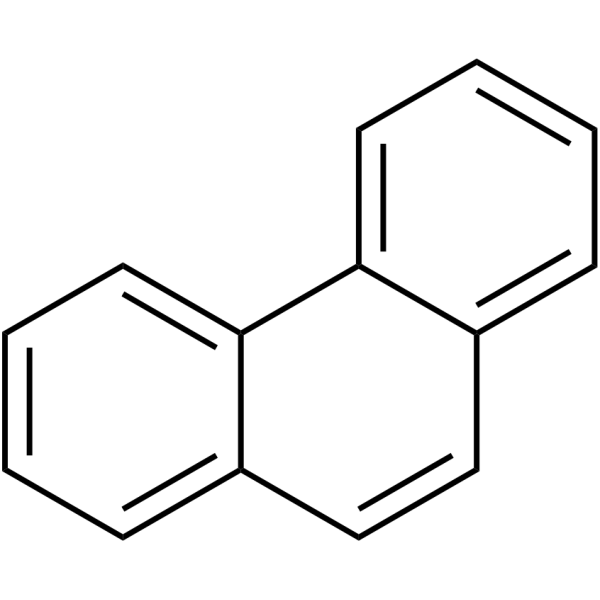
- HY-136457
-
|
|
Drug Metabolite
|
Others
|
|
2-NP-AHD is a 2-nitrophenyl derivative of AHD (a metabolite of nitrofurans type of antibiotics), can be used as indicator of the illegal usage of nitrofuran agents .
|
-

- HY-N1442
-
|
Orange II; D&C Orange NO. 4
|
|
|
|
Acid orange 7 (Orange II), an azo dye, is an indicator pollutant. Acid orange 7 appears in manufacturing wastewater disposed of from the textile, food, and cosmetic industries .
|
-
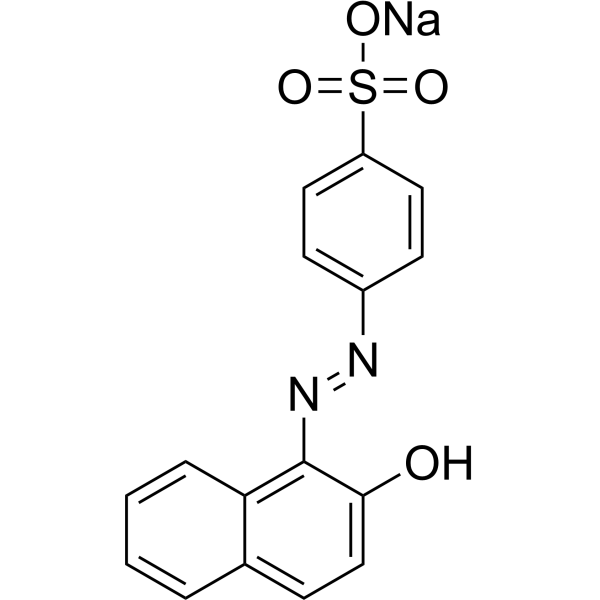
- HY-113486S1
-
-
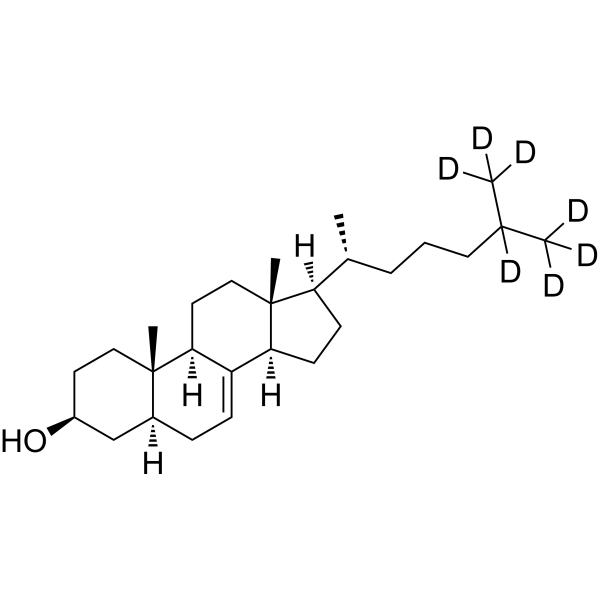
- HY-W110910
-
|
|
Biochemical Assay Reagents
|
Others
|
|
Eriochrome black T indicator (C.I. 14645), 1% solid is a biochemical reagent that can be used as a biological material or organic compound for life science related research.
|
-

- HY-D1758
-
|
|
Fluorescent Dye
|
Others
|
|
Fura-5F AM is a membrane-permeant fluorescent calcium indicator. Upon entering the cell, this probe is hydrolyzed by cytosilic esterases and trapped as the active chelator.
|
-
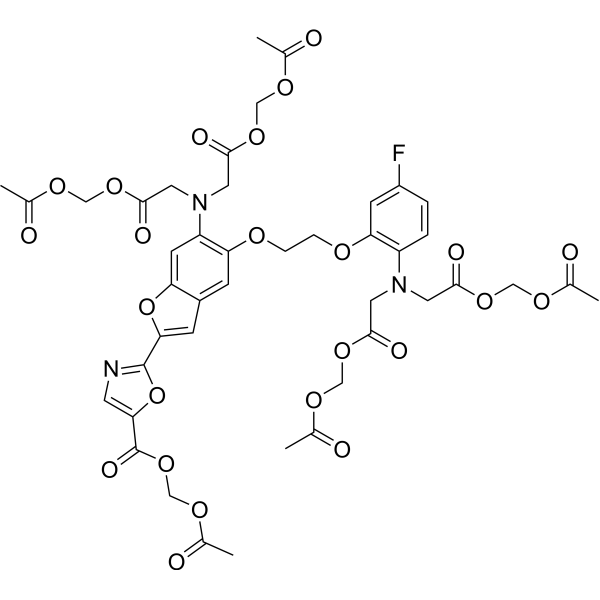
- HY-D1759
-
|
|
Fluorescent Dye
|
Others
|
|
Fura-4F AM is a cell-permeant fluorescent calcium indicator. Upon entering the cell, this probe is hydrolyzed by cytosilic esterases and trapped as the active chelator.
|
-
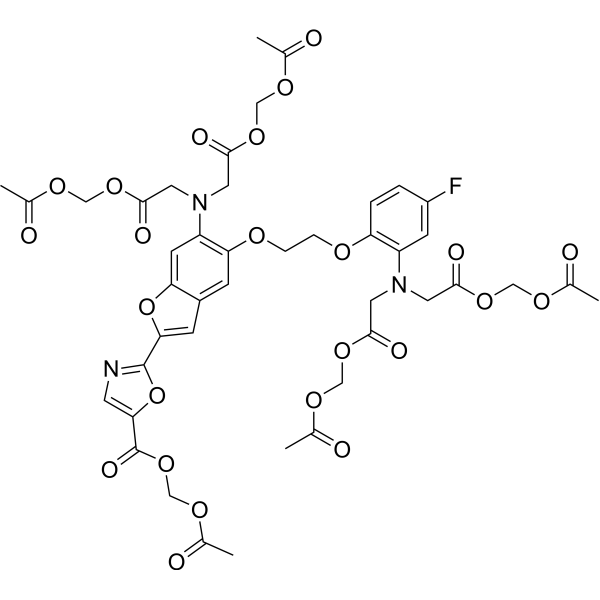
- HY-D1773
-
|
|
Fluorescent Dye
|
Others
|
|
YOYO-3 is a cell-impermeant dye with far-red fluorescence used as nulear counterstain and dead cell indicator. It generates bright fluorescence upon binding to DNA.
|
-
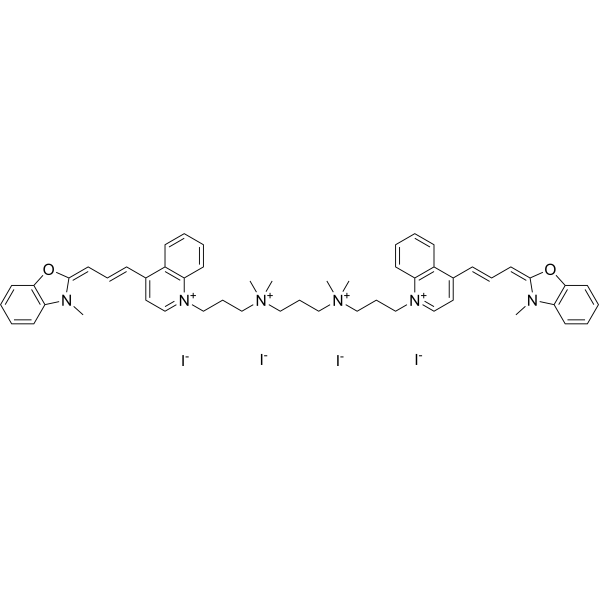
- HY-B1571
-
|
|
|
|
|
Bromophenol blue is an acid phthalein dye, and it is used as a tracking dye for electrophoresis. Bromophenol blue is also used as a pH indicator, with a transition range of pH 3 to 4.6 .
|
-
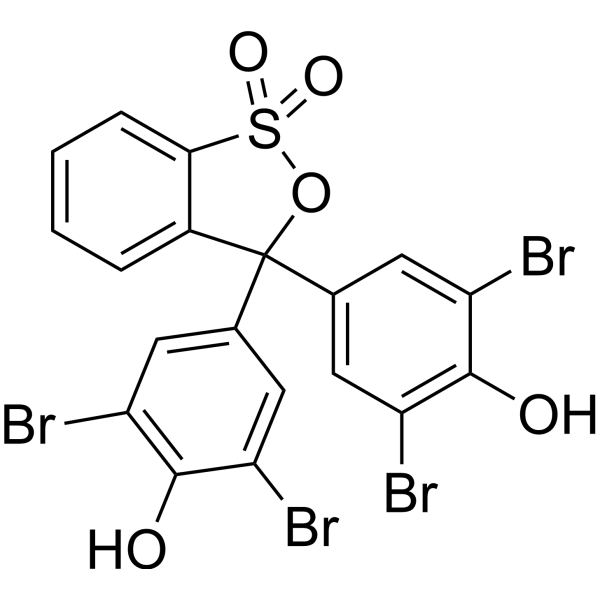
- HY-Y1125
-
|
Pseudothymine
|
|
|
|
6-Methyluracil (Pseudothymine), a metabolite of Uracil, can be used as an indicator of acetoacetyl-CoA (AACoA) accumulation. 6-Methyluracil exhibits antiradiation effect in vivo .
|
-
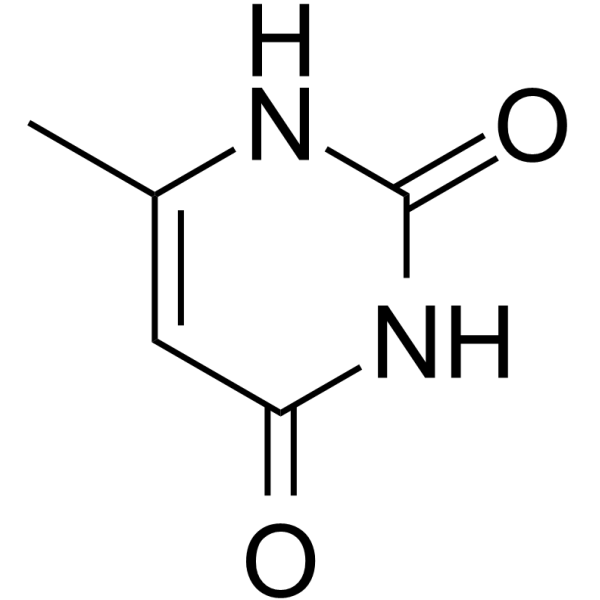
- HY-129247
-
|
|
Others
|
Others
|
|
Versicolorin A, a precursor of aflatoxin B1 (AFB1), can serve as an early indicator of aflatoxin (AF) contamination, even when AFs themselves are present at undetectable levels .
|
-
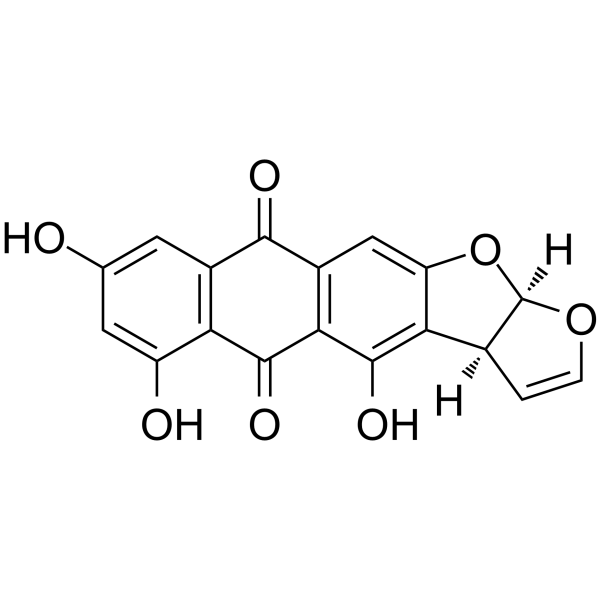
- HY-W009300S1
-
-

- HY-103395S1
-
|
|
Endogenous Metabolite
|
Cancer
|
|
Methylmalonic acid- 13C4 is the 13C labeled Methylmalonic acid[1]. Methylmalonic acid (Methylmalonate) is an indicator of Vitamin B-12 deficiency in cancer[2].
|
-
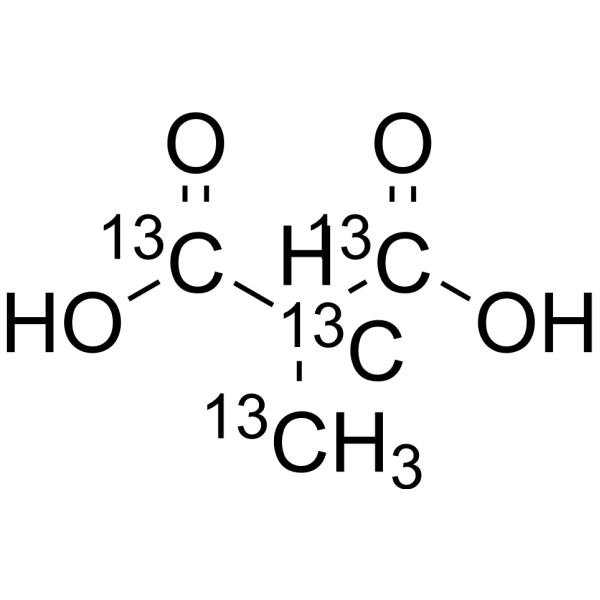
- HY-N0091S5
-
|
|
Endogenous Metabolite
|
Others
|
|
Hypoxanthine-d4 is the deuterium labeled Hypoxanthine[1]. Hypoxanthine, a purine derivative, is a potential free radical generator and could be used as an indicator of hypoxia[2].
|
-

- HY-N0091S6
-
|
|
Endogenous Metabolite
|
Others
|
|
Hypoxanthine-d2 is the deuterium labeled Hypoxanthine[1]. Hypoxanthine, a purine derivative, is a potential free radical generator and could be used as an indicator of hypoxia[2].
|
-
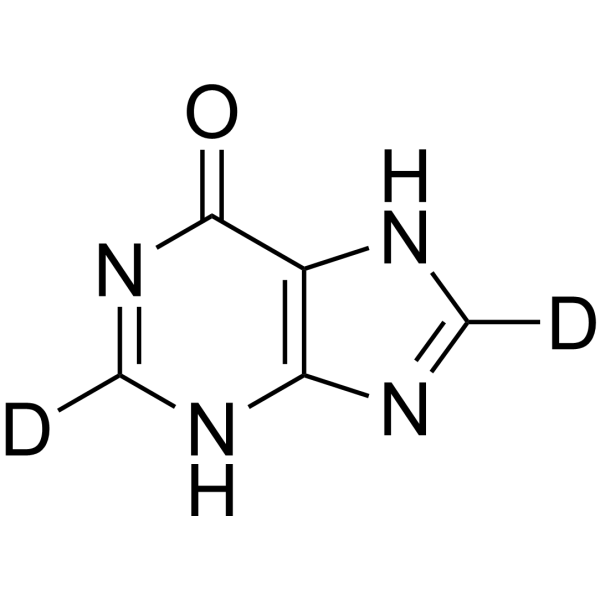
- HY-113486R
-
|
|
Endogenous Metabolite
|
Metabolic Disease
|
|
Lathosterol(Standard) is the analytical standard of Lathosterol. This product is intended for research and analytical applications. Lathosterol is a cholesterol-like molecule. Serum Lathosterol concentration is an indicator of whole-body cholesterol synthesis.
|
-
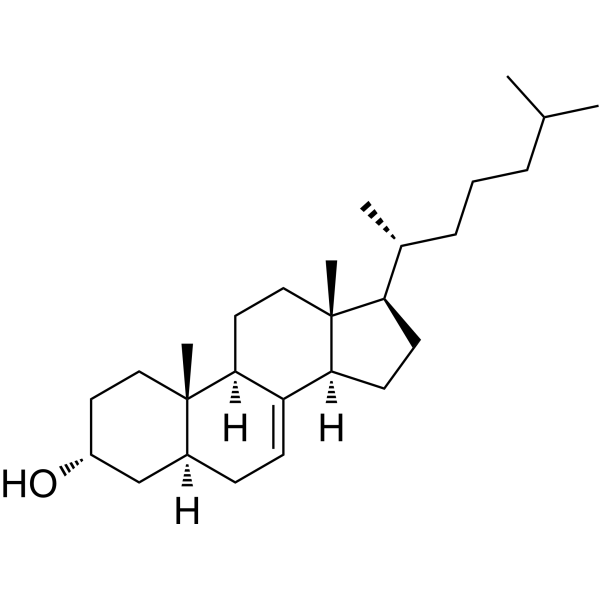
- HY-113486S
-
|
|
Endogenous Metabolite
|
|
|
(S)-Lathosterol-d4 is the deuterium labeled (S)-Lathosterol. Lathosterol is a cholesterol-like molecule. Serum Lathosterol concentration is an indicator of whole-body cholesterol synthesis[1].
|
-
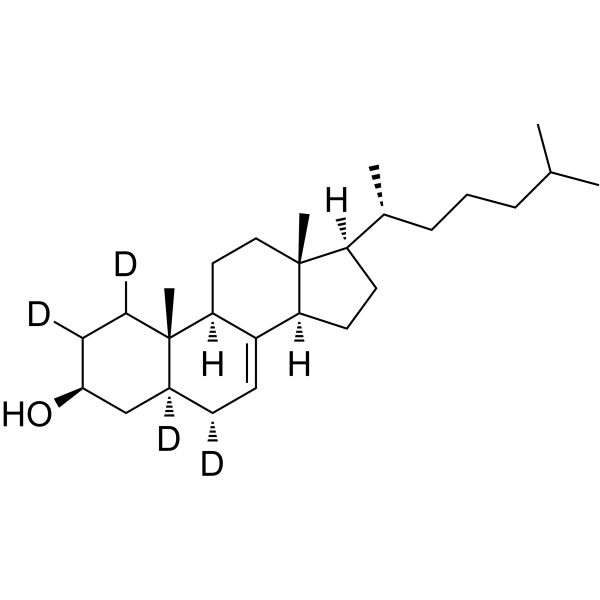
- HY-41121S1
-
-

- HY-N0091S7
-
|
Purin-6-ol-15N4; Sarcine-15N4
|
Endogenous Metabolite
|
Others
|
|
Hypoxanthine- 15N4 is the 15N labeled Hypoxanthine[1]. Hypoxanthine, a purine derivative, is a potential free radical generator and could be used as an indicator of hypoxia[2].
|
-

- HY-113406
-
|
|
Others
|
Inflammation/Immunology
|
|
Hexanoylcarnitine exists in human urine and plasma. Hexanoylcarnitine can be used as a plasma detection indicator in patients with methylmalonic aciduria, propionic acidemia, and medium-chain acyl-CoA dehydrogenase deficiency .
|
-
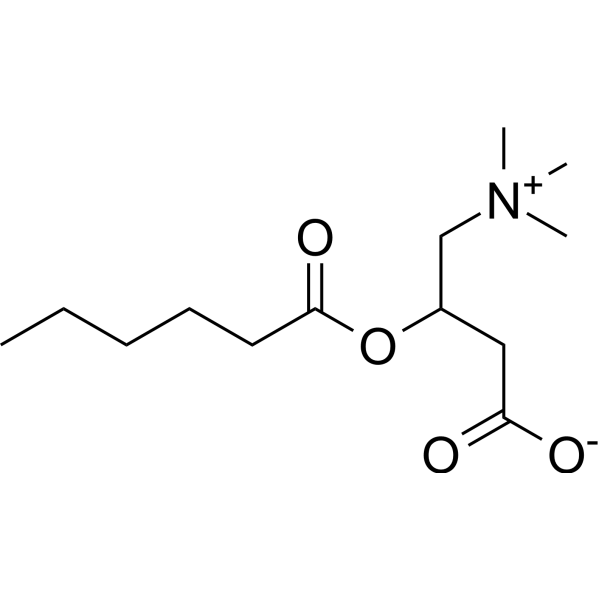
- HY-W008820
-
|
|
Endogenous Metabolite
|
Metabolic Disease
|
|
Glutaric acid, C5 dicarboxylic acid, is an intermediate during the catabolic pathways of lysine and tryptophan. Glutaric acid affects pericyte contractility and migration. Glutaric acid is an indicator of glutaric aciduria type I .
|
-
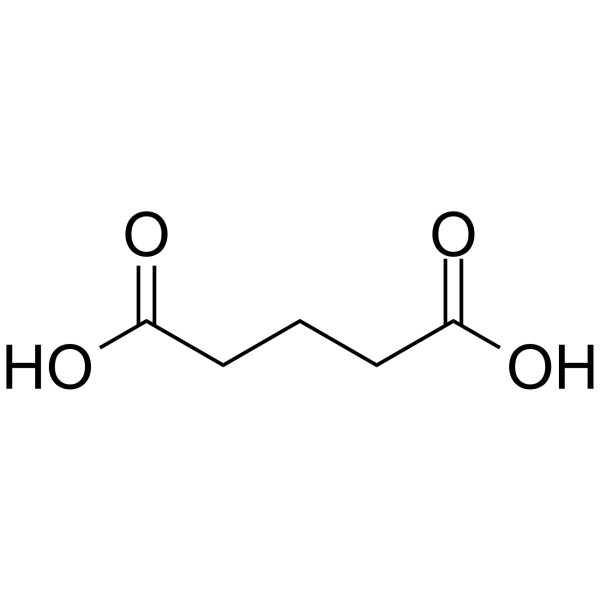
- HY-D1488
-
|
|
Fluorescent Dye
|
Others
|
|
Ethyl benzo[6,7]-4-oxo-4H-quinolizine-3-carboxlate (Compound 3) is a Mg 2+ selective fluorescent indicator .
|
-
![Ethyl benzo[6,7]-4-oxo-4H-quinolizine-3-carboxlate](//file.medchemexpress.com/product_pic/hy-d1488.gif)
- HY-D0112
-
|
|
Fluorescent Dye
|
Others
|
|
7-Hydroxycoumarin-4-acetic acid, a pH-indicator dye, is covalently bound to bovine serum albumin (BSA) at the positions of reactive amino groups (λmax=326 nm) .
|
-

- HY-W110794
-
|
|
Biochemical Assay Reagents
|
Others
|
|
Crystal violet indicator (0.0-2.0)(C.I. 42555), AR is a biochemical reagent that can be used as a biological material or organic compound for life science related research.
|
-
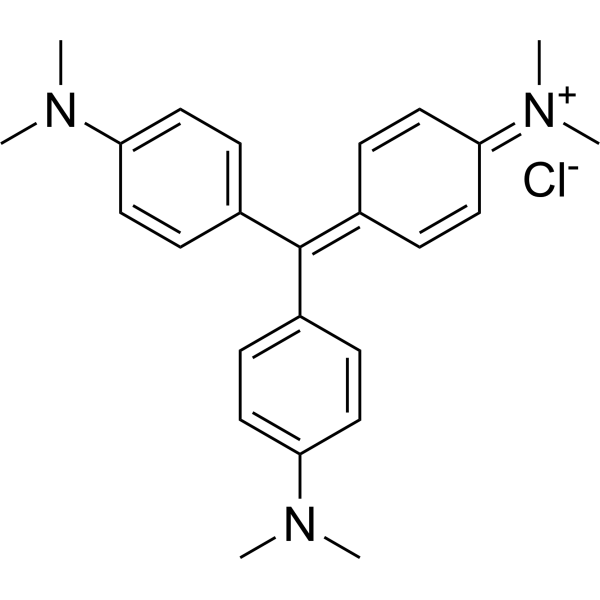
- HY-129380
-
|
Fructoselysine
|
Endogenous Metabolite
|
Metabolic Disease
|
|
Fructosyl-lysine (Fructoselysine) is an amadori glycation product from the reaction of glucose and lysine by the Maillard reaction. Fructosyl-lysine is the precursor to glucosepane, a lysine–arginine protein cross-link that can be an indicator in diabetes detection .
|
-
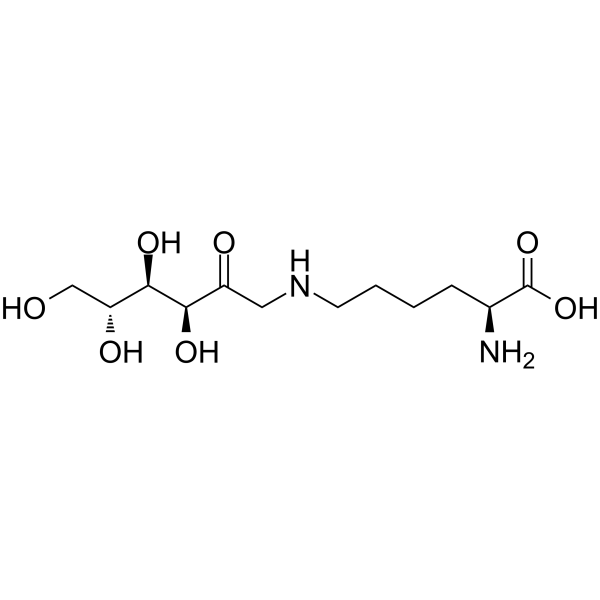
- HY-129380A
-
|
Fructoselysine dihydrochloride
|
Endogenous Metabolite
|
Metabolic Disease
|
|
Fructosyl-lysine (Fructoselysine) dihydrochloride is an amadori glycation product from the reaction of glucose and lysine by the Maillard reaction. Fructosyl-lysine dihydrochloride is the precursor to glucosepane, a lysine–arginine protein cross-link that can be an indicator in diabetes detection .
|
-
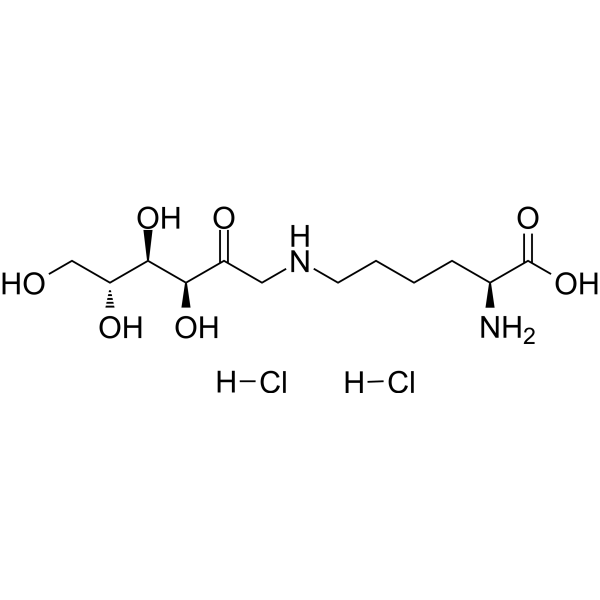
- HY-D1760
-
|
Sodium-binding benzofuran isophthalate
|
Fluorescent Dye
|
Others
|
|
SBFI is a membrane-permeant, fluorescent Na + indicator dye. SBFI is excited at 340 nm and the fluorophore emission is collected at 450 nm . SBFI selective for Na + over K + with Kd values of 20 and 120 mM for these ions, respectively. .
|
-
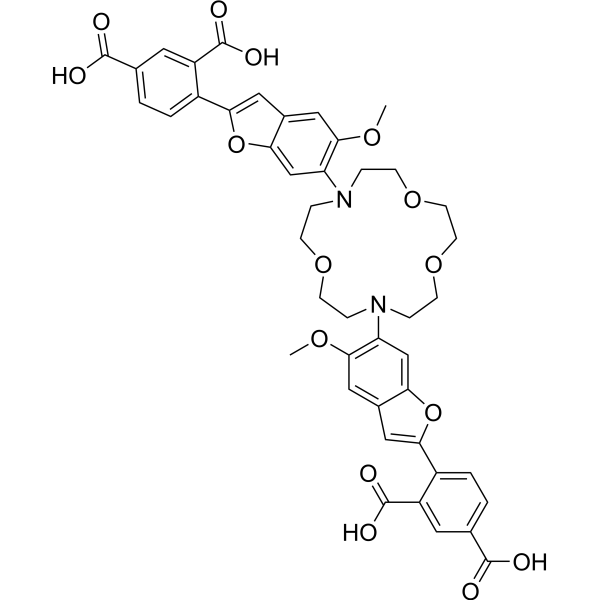
- HY-131510
-
|
SNARF-DE
|
Fluorescent Dye
|
Others
|
|
Chromoionophore XIII (SNARF-DE) is a pH senor that enables excitation with red light. Chromoionophore XIII functionality renders the indicator molecule lipophilic and water-insoluble but also prevents lactonization of the dye in an apolar environment .
|
-
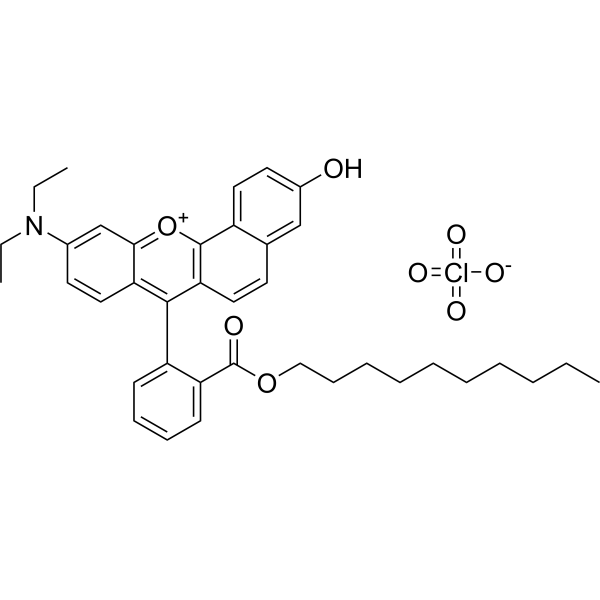
- HY-108398AS
-
|
5,8,11-Eicosatrienoic acid-d6
|
Isotope-Labeled Compounds
|
Metabolic Disease
Cancer
|
|
Mead acid-d6 is the deuterium labeled Mead acid. Mead acid (5,8,11-Eicosatrienoic acid), an unsaturated (Omega-9) fatty acid, is an indicator of essential fatty acid deficiency[1].
|
-
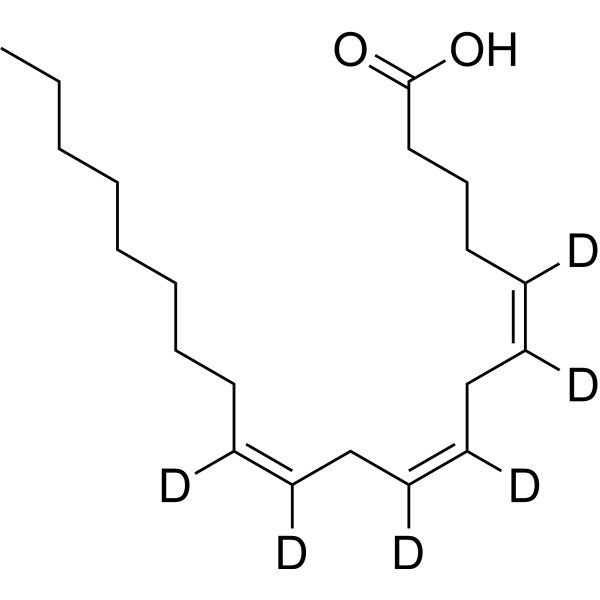
- HY-W074143
-
|
|
Fluorescent Dye
|
Others
|
|
Tris(4,7-diphenyl-1,10-phenanthroline)ruthenium(II) dichloride is an oxygen-sensitive fluorescent indicator widely used as a probe for luminescence detection and quantitative oxygen determination .
|
-
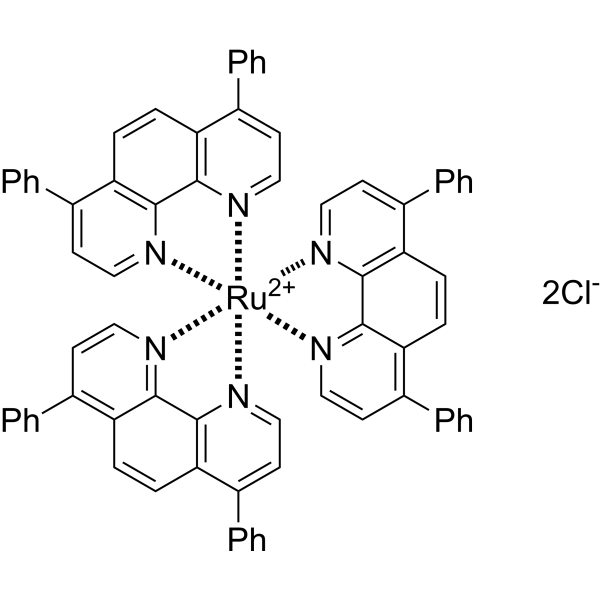
- HY-129547
-
|
|
Fluorescent Dye
|
Others
|
|
Fluo-3 pentapotassium is a fluorescent indicator for intracellular Ca 2+ that is used in flow cytometry and cell-based experiments. Fluo-3 pentapotassium produces fluorescence with an emission maximum at 525 nm upon binding to calcium.
|
-
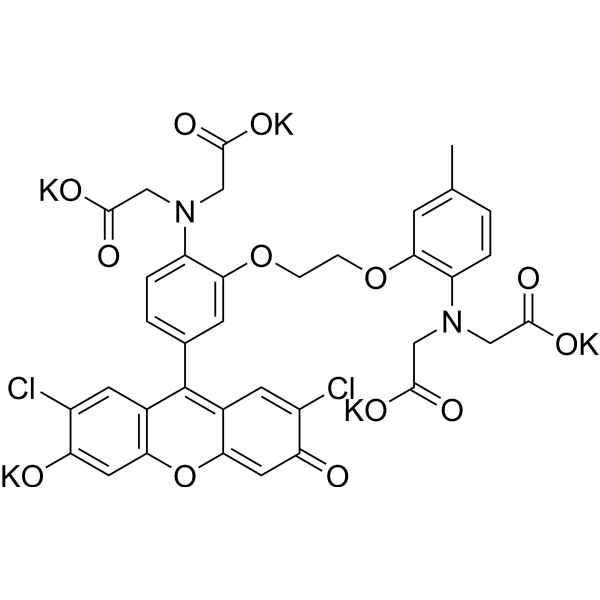
- HY-D1769
-
|
|
Fluorescent Dye
|
Others
|
|
N-hydroxy Rhodamine B amide is a ClO - indicator, which is hydrolyzed to prduce fluorescence in the presence of ClO -. The fluorescence intensity of N-hydroxy Rhodamine B amide is proportional to the product, thus can be used to quantify ClO -.
|
-
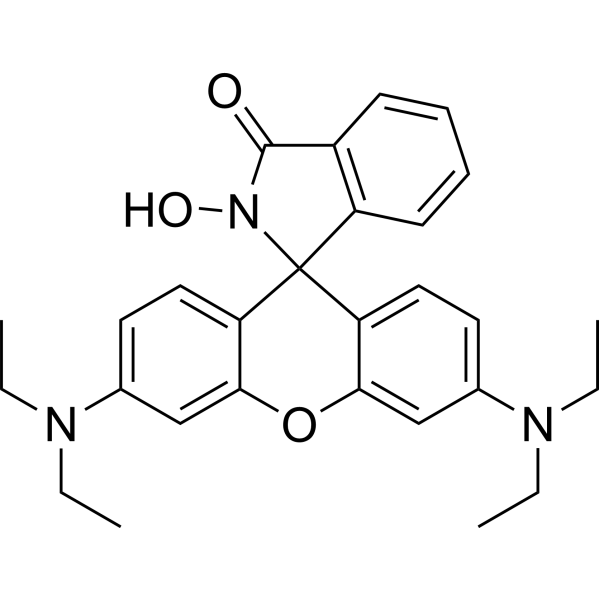
- HY-W017006S
-
|
|
Endogenous Metabolite
|
Metabolic Disease
|
|
1-Methyl-L-histidine-d3 is the deuterium labeled 1-Methyl-L-histidine. 1-Methyl-L-histidine is an objective indicator of meat ingestion and exogenous 3-methylhistidine (3MH) intake.
|
-

- HY-W012855S
-
|
|
Isotope-Labeled Compounds
|
Others
|
|
3-Mercapto-3-methylbutan-1-ol-d6 is the deuterium labeled Hypoxanthine. Hypoxanthine, a purine derivative, is a potential free radical generator and could be used as an indicator of hypoxia.
|
-
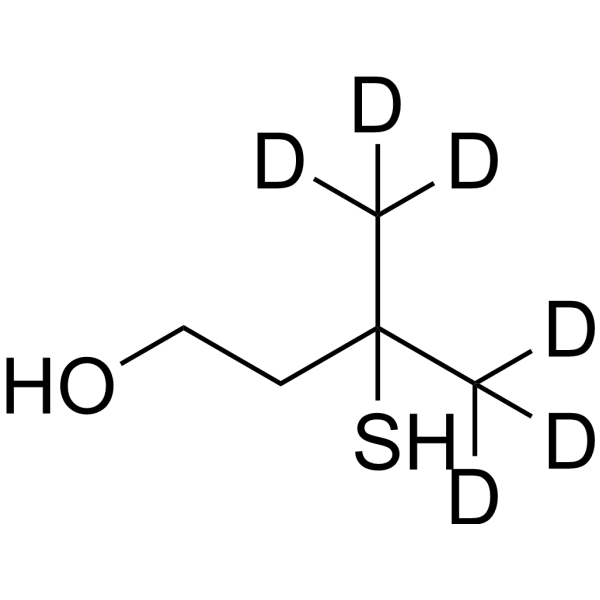
- HY-104058
-
|
Oregon Green 488 BAPTA 1AM
|
Fluorescent Dye
|
Others
|
|
Oregon-BAPTA Green 1AM (Oregon Green 488 BAPTA 1AM) is a fluorescent Ca 2+ indicator that consists of a green fluorescent probe OG 488 and a cell-permeable Ca 2+ chelator BAPTA AM.
|
-

- HY-D1894
-
|
|
Fluorescent Dye
|
Others
|
|
5-Br-PAPS is a highly specific Zn 2+ metallochromic indicator. 5-Br-PAPS is used in assays for measuring free Zn 2+ by forming a deeply colored red Zn 2+ complex .
|
-
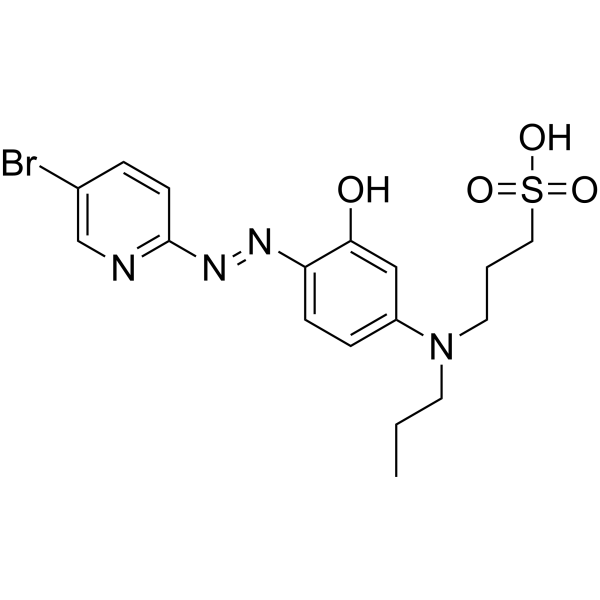
- HY-W008016S
-
-
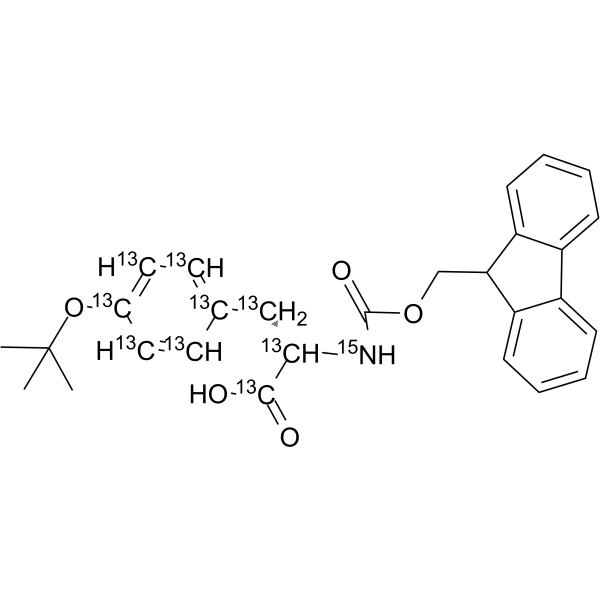
- HY-N10681
-
|
Euonine
|
Others
|
Others
|
|
Evonimine (Euonine) is an alkaloid isolated from Tripterygium wilfordii Hook. Evonimine exhibits significant inhibition of humoral-mediated immunity using the haemolytic response as an indicator, and shows good anti-feeding activity against the lepidopteran Spodoptera littoralis .
|
-

- HY-W008820S
-
|
|
Endogenous Metabolite
|
Metabolic Disease
|
|
Glutaric acid-d6 is the deuterium labeled Glutaric acid. Glutaric acid is an intermediate during the catabolic pathways of lysine and tryptophan. Glutaric acid affects pericyte contractility and migration. Glutaric acid is an indicator of glutaric aciduria type I[1][2][3].
|
-
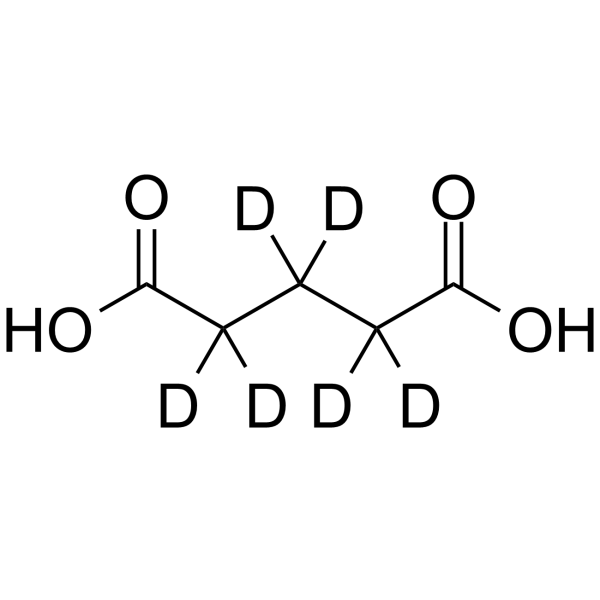
- HY-B1727S
-
|
|
Isotope-Labeled Compounds
|
Inflammation/Immunology
|
|
Phenanthrene-d10 is the deuterium labeled Phenanthrene. Phenanthrene is a polycyclic aromatic hydrocarbon (PAH) and has been frequently used as an indicator for monitoring PAH contaminated matrices[1]. Phenanthrene induces oxidative stress and inflammation[2].
|
-
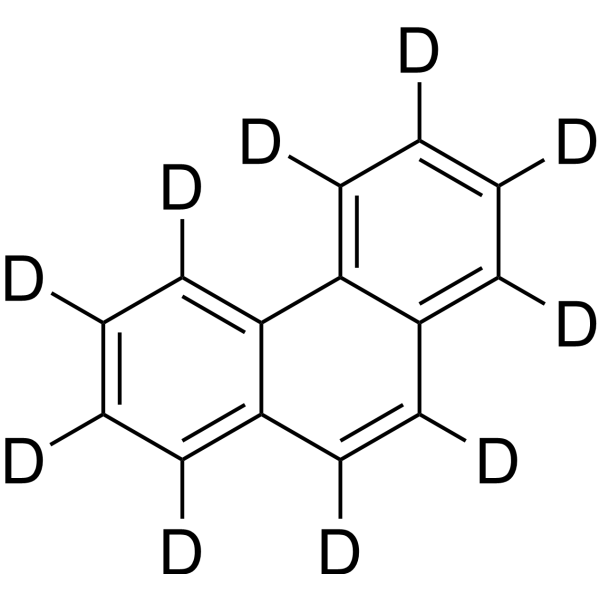
- HY-N4241
-
|
|
Others
|
Others
|
|
Kauran-18-oic acid, 16,17,19-trihydroxy-, (4α)- (compound 5) is a endogenous ent-kaurane diterpene compound in green coffee beans, providing direct chemical indicators of low-quality coffee .
|
-
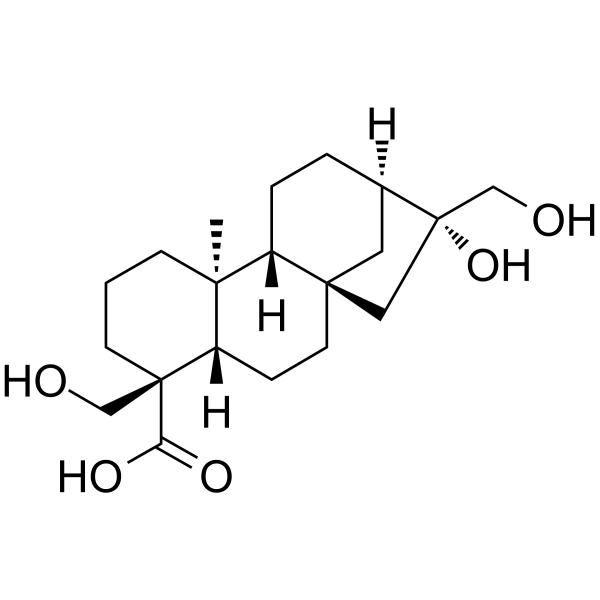
- HY-D0011
-
|
|
Biochemical Assay Reagents
|
Others
|
|
Bromophenol blue sodium is a pH indicator. It changes from yellow at pH 3.0 to blue at pH 4.6. Bromophenol blue sodium is also used as a tracking dye to monitor the process of agarose gel electrophoresis and polyacrylamide gel electrophoresis .
|
-
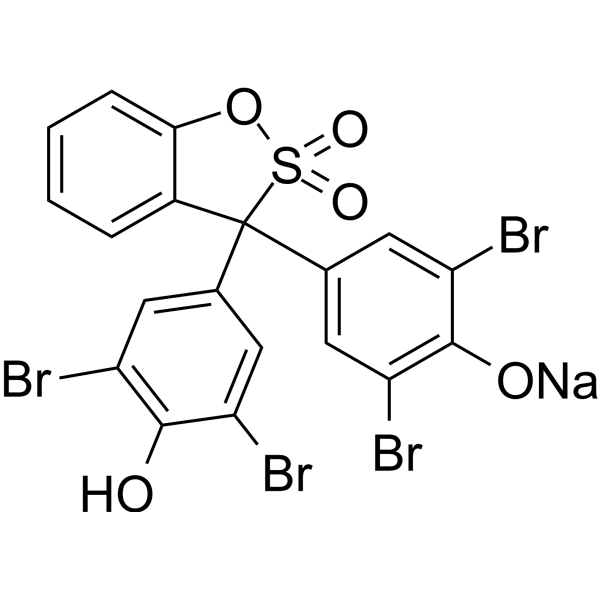
- HY-D0015A
-
|
|
Fluorescent Dye
|
Others
|
|
Cresol Red sodium is a triarylmethane dye. Cresol Red sodium can be used for indicating pH, temperatures and salinities .
|
-
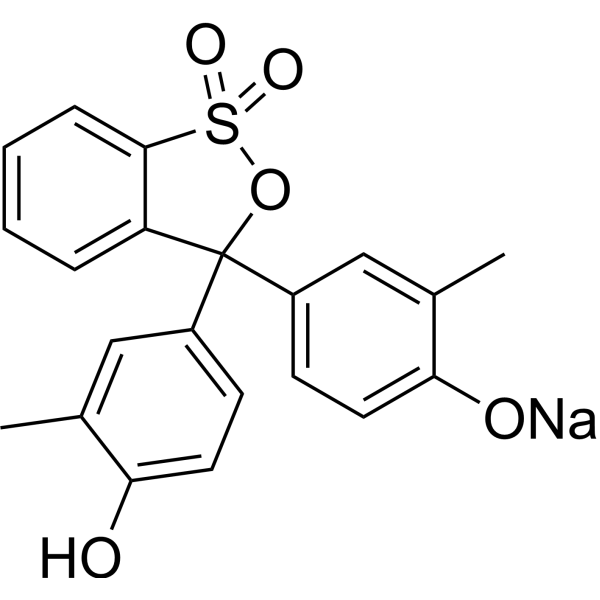
- HY-106586
-
|
P-286
|
Biochemical Assay Reagents
|
Others
|
|
Ioxaglic acid (P-286) is negatively charged contrast agent, is useful as an inverse indicator for glycosaminoglycan (GAG) used in computed tomography (CT). Ioxaglic acid can be used for imaging of human osteoarthritic cartilage via quantitative assessment of glycosaminoglycan content .
|
-
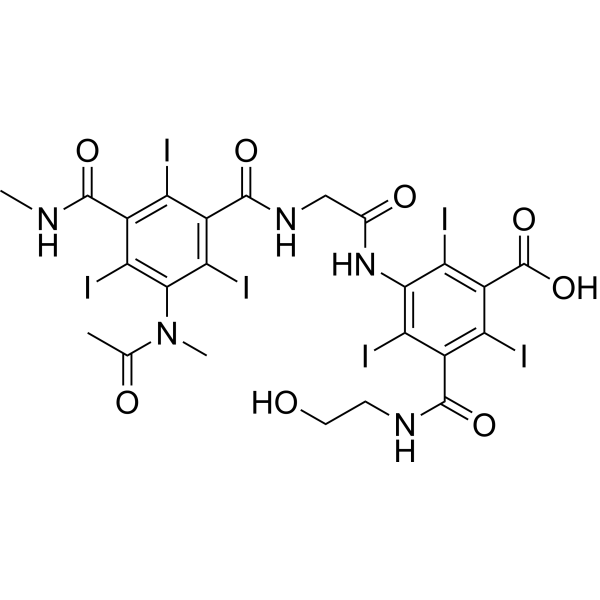
- HY-D1768
-
|
|
Fluorescent Dye
|
Others
|
|
Fluo-4FF AM is a cell-permeant fluorescent calcium indicator. Fluo-4FF is an analog of Fluo-4 with a lower affinity for calcium, which is suitable for investigation of relatively high level of intracellular calcium.
|
-

- HY-N9945
-
-
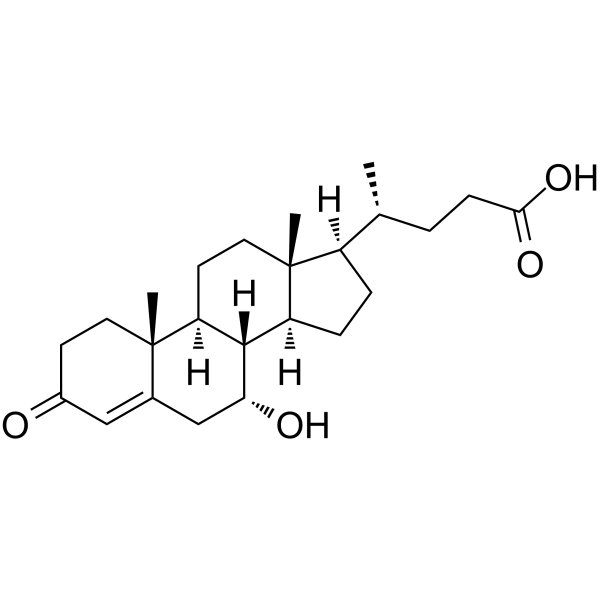
- HY-W008820S1
-
|
|
Endogenous Metabolite
|
Metabolic Disease
|
|
Glutaric acid-d4 is the deuterium labeled Glutaric acid. Glutaric acid, C5 dicarboxylic acid, is an intermediate during the catabolic pathways of lysine and tryptophan. Glutaric acid affects pericyte contractility and migration. Glutaric acid is an indicator of glutaric aciduria type I[1][2][3].
|
-
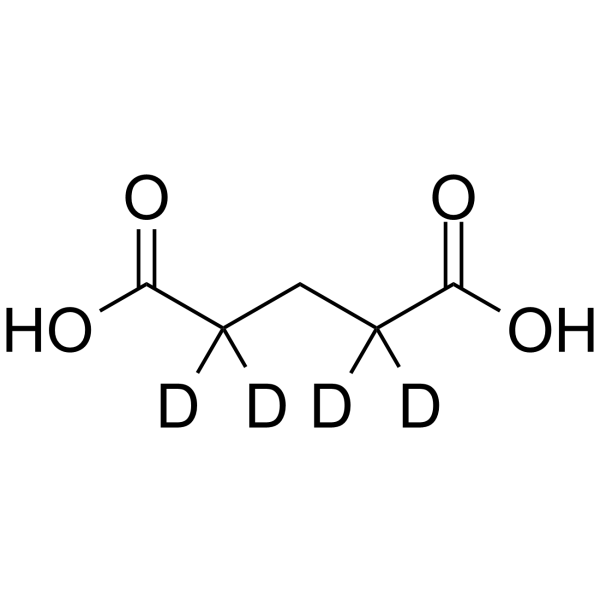
- HY-W008820S2
-
|
|
Endogenous Metabolite
|
Metabolic Disease
|
|
Glutaric acid-d2 is the deuterium labeled Glutaric acid. Glutaric acid, C5 dicarboxylic acid, is an intermediate during the catabolic pathways of lysine and tryptophan. Glutaric acid affects pericyte contractility and migration. Glutaric acid is an indicator of glutaric aciduria type I[1][2][3].
|
-

- HY-D0720
-
|
NSC-151912; L-6868
|
Fluorescent Dye
Reactive Oxygen Species
|
Others
|
|
Lucigenin is a chemiluminescence probe. Lucigenin can be used to detect the production of endogenous superoxide anion radical (O 2-). Lucigenin is extremely sensitive to chloride ions, while it combined with chloride ions, the fluorescence will be quenched. Lucigenin also can be used as a chloride indicator. Ex/Em=455/505 nm .
|
-

- HY-D0254
-
Gallein
4 Publications Verification
Pyrogallol phthalein
|
PI3K
|
Cancer
|
|
Gallein is a G protein βγ (Gβγ) subunit signalling inhibitor. Gallein disrupts the interaction of Gβγ subunits with the PI3Kγ. Anticancer agent . Gallein used as a red dye, an acid-base indicator and as a detection reagent for phosphates .
|
-
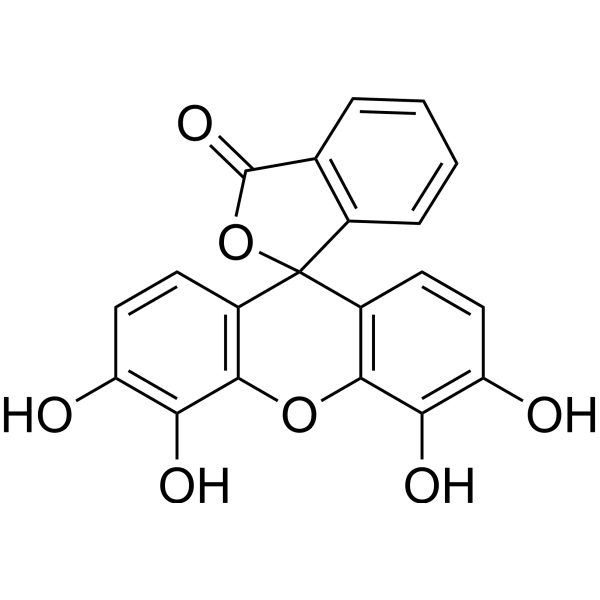
- HY-129912
-
|
|
Endogenous Metabolite
|
Cancer
|
|
N1,N8-Diacetylspermidine is a polyamines in the human urine . N1,N8-Diacetylspermidine is useful as prognostic indicators after treatment and during follow-up examination of cancer patients .
|
-
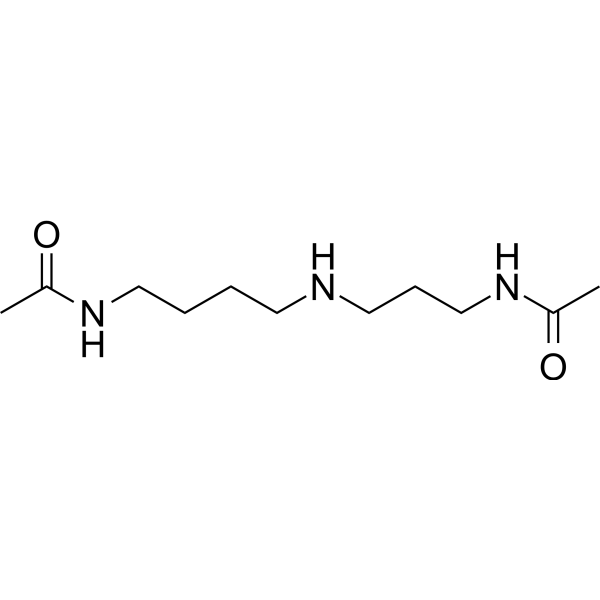
- HY-129912A
-
|
|
Endogenous Metabolite
|
Cancer
|
|
N1,N8-Diacetylspermidine hydrochloride is a polyamines in the human urine . N1,N8-Diacetylspermidine hydrochloride is useful as prognostic indicators after treatment and during follow-up examination of cancer patients .
|
-
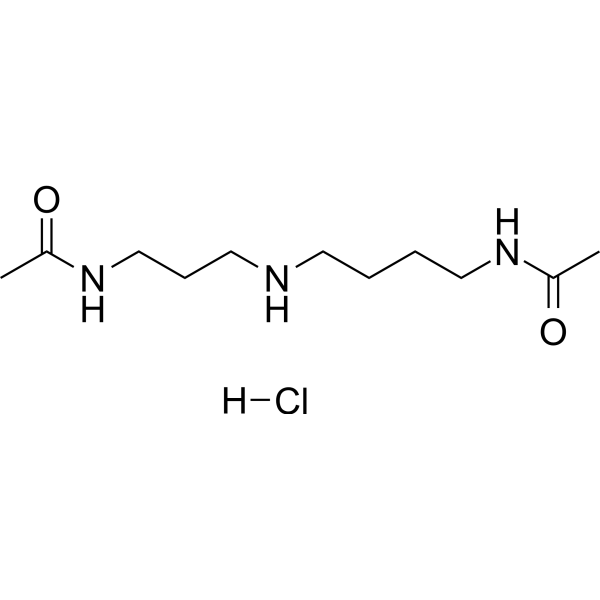
- HY-W099331
-
|
MEGX hydrochloride; Norlidocaine hydrochloride
|
Drug Metabolite
|
Metabolic Disease
Inflammation/Immunology
|
|
Monoethylglycinexylidide (MEGX) hydrochloride is a metabolite of Lidocain (HY-B0185) via oxidative N-deethylation of Lignocaine by liver cytochrome P-450 enzymes in the liver. Monoethylglycinexylidide has proven to be a highly sensitive indicator of hepatic dysfunction, especially in the field of liver transplantation .
|
-
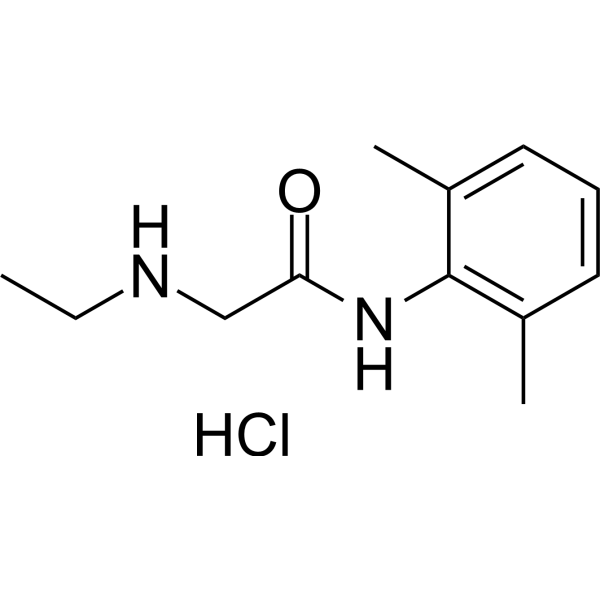
- HY-D1702
-
|
|
Fluorescent Dye
|
Others
|
|
Mag-Fura-2 tetrapotassium is a UV excitable rational fluorescent Mg 2+/Ca 2+ indicator (Ex=334-360 nm, Em=510 nm). Mag-Fura-2 tetrapotassium can be used for the determination of Mg 2+ and Ca 2+ concentrations .
|
-

- HY-112948
-
|
|
Endogenous Metabolite
|
Metabolic Disease
|
|
2-Methylbutyrylcarnitine is a fatty acid metabolite. 2-Methylbutyrylcarnitine is found mainly in the blood and urine of humans and animals and is produced through the pyruvate carboxylation pathway. 2-Methylbutyrylcarnitine exhibits high level in the plasma of subjects with steatohepatitis (NASH) and can be used as an indicator for the diagnosis of metabolic diseases .
|
-
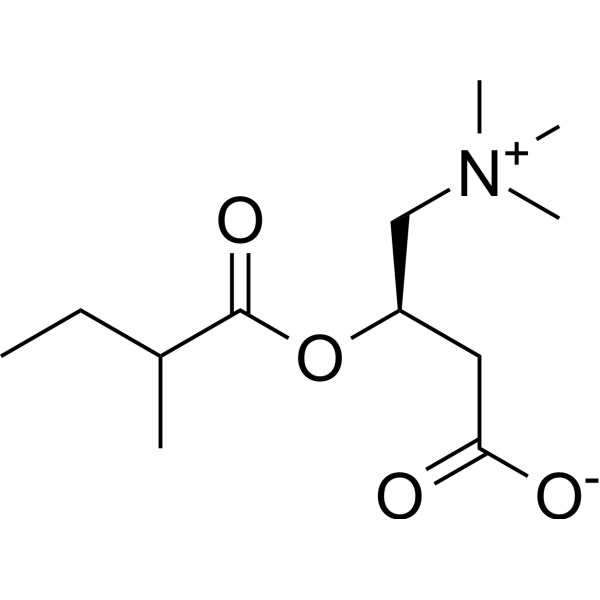
- HY-111330
-
|
HPF; 3'-p-(Hydroxyphenyl) fluorescein
|
Fluorescent Dye
Reactive Oxygen Species
|
Others
|
|
Hydroxyphenyl Fluorescein (HPF) is a stable ROS fluorescent probe dye. Hydroxyphenyl Fluorescein has stronger specificity and stability than H2DCFDA (HY-D0940). Hydroxyphenyl Fluorescein can produce strong green fluorescence through hydroxyl radical reaction with intracellular peroxynitroso. Hydroxyphenyl Fluorescein can be applied for fluorescence microscopy, high-throughput imager, luciferase microplate reader or flow cytometry. Ex/Em=490/515 nm .
|
-

- HY-113465
-
|
LTE4
|
Endogenous Metabolite
|
Inflammation/Immunology
|
|
Leukotriene E4 (LTE4) is produced by the action of dipeptidase on LTD4. Leukotriene E4 is one of the constituents of slow-reacting substance of anaphylaxis (SRS-A). Leukotriene E4 accumulates in both plasma and urine and urinary excretion of Leukotriene E4 is most often used as an indicator of asthma.
|
-
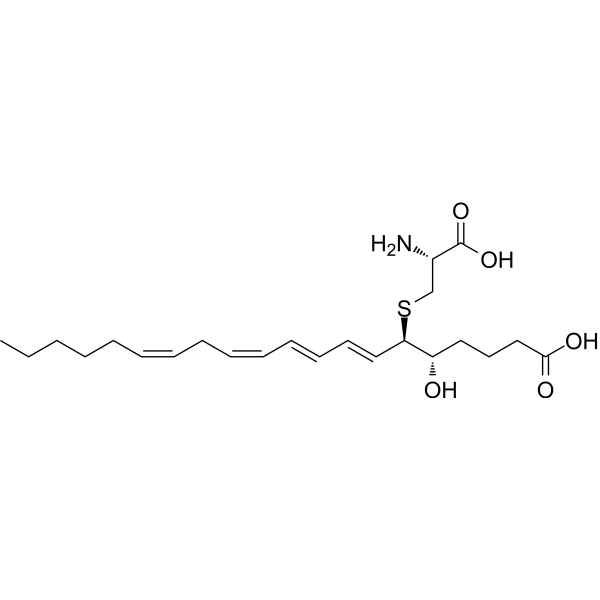
- HY-126823
-
|
PGSK diacetate (5/6-mixture)
|
Fluorescent Dye
|
Others
|
|
Phen green SK (PGSK) diacetate is a fluorescent heavy metal indicator that reacts with a variety of metal ions, including Fe2+, Cd2+, Co2+, Ni2+, Zn2+. PGSK diacetate displays excitation/emission maxima of 507/532 nm, respectively, and fluorescence is quenched upon interaction with metal ions
|
-
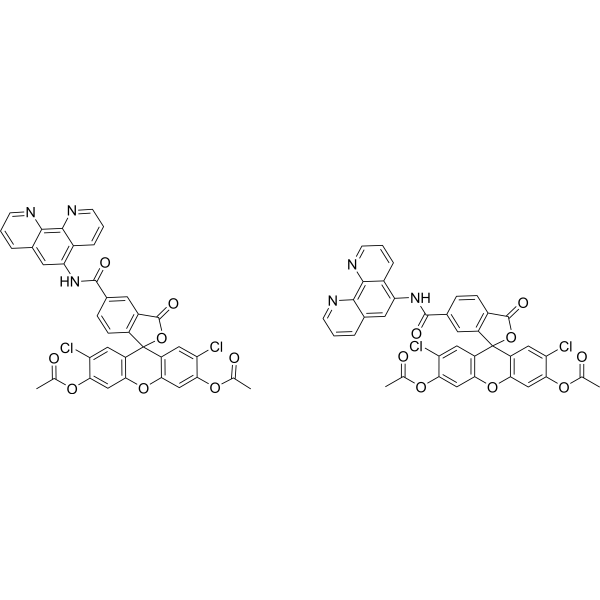
- HY-113245
-
|
|
Endogenous Metabolite
|
Others
|
|
3-Indolyl-β-D-glucuronide, a chromogenic substrate for β-D-glucuronidase, employs in the detection and enumeration of E. coli, yielding a blue precipitate upon cleavage. 3-Indolyl-β-D-glucuronide in? patients' plasma act as a new indicator of renal failure .
|
-

- HY-W027126
-
|
|
Apoptosis
|
Metabolic Disease
|
|
Hepatoprotective agent-2 (compound 2a), a 4-phenyl-tetrahydroquinoline derivative, displays a remarkable hepatoprotective effect. Hepatoprotective agent-2 has antiapoptotic activity. Hepatoprotective agent-2 notably prevents the chemically induced elevation of hepatic indicators associated with liver injury .
|
-
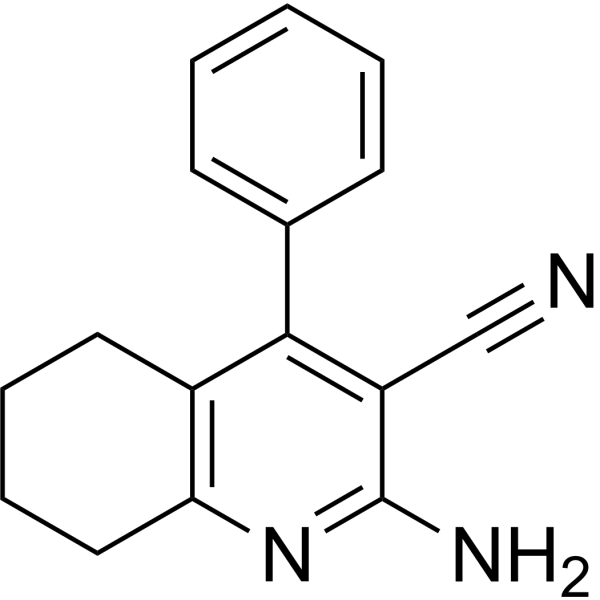
- HY-126923
-
|
2,3-Dinor-TXB2
|
Others
|
Cardiovascular Disease
Metabolic Disease
|
|
2,3-Dinor thromboxane B2 (2,3-Dinor-TXB2), a metabolite of urine, serves as an indicator of the production of thromboxane A2 (TxA2) in the body, and can be used as a tool to study the role of thromboxane in various pathophysiological processes in the human body .
|
-
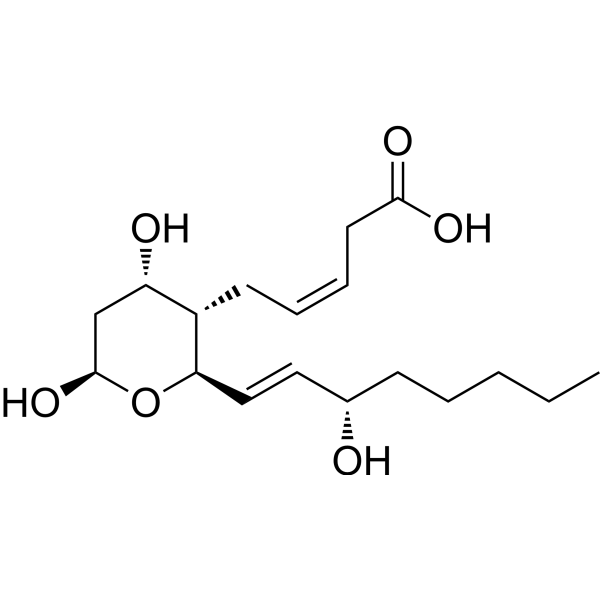
- HY-D1700
-
|
|
Fluorescent Dye
|
Others
|
|
Mag-indo-1/AM is a cell-permeable fluorescent indicator for Mg 2+ and also for Ca 2+ (Ex=340-390 nm, Em=410-490 nm). Mag-indo-1/AM can be used to determine intracellular Mg 2+ and Ca 2+ concentrations .
|
-
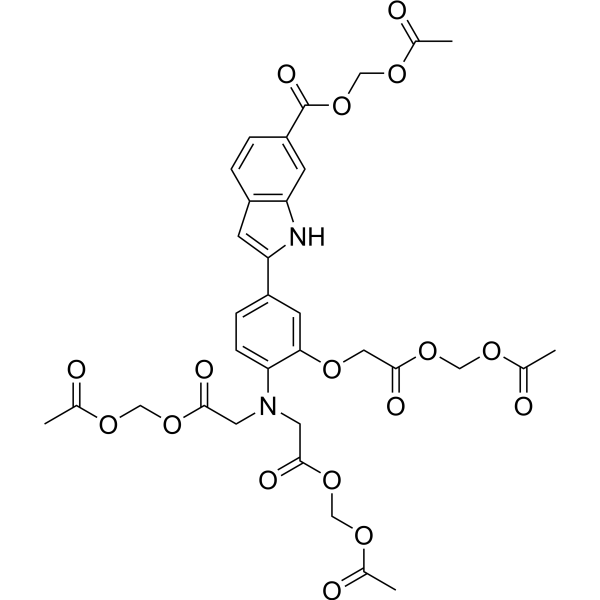
- HY-D0018
-
|
Dichlorophenylindophenol sodium; DCPIP sodium; Indochlorophenol sodium
|
Biochemical Assay Reagents
|
Others
|
|
DCIP sodium is a blue dye commonly used in various biochemical and biotechnological applications as an indicator of redox reactions. DCIP sodium has unique chemical properties that change color according to the oxidation state of the substance being tested. It is commonly used in enzyme assays, such as measuring the activity of succinate dehydrogenase, or in protein quantification methods, such as the Lowry assay.
|
-
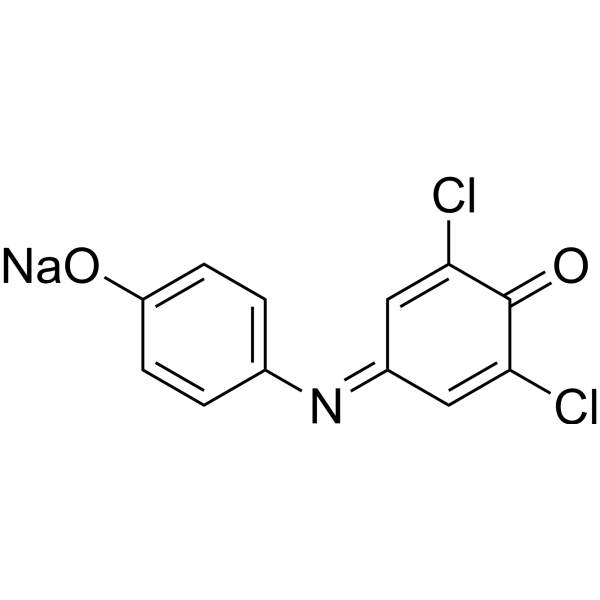
- HY-136457S
-
|
|
Isotope-Labeled Compounds
|
Others
|
|
2-NP-AHD- 13C3 is the 13C labled 2-NP-AHD (HY-136457) . 2-NP-AHD is a 2-nitrophenyl derivative of AHD (a metabolite of nitrofurans type of antibiotics), can be used as indicator of the illegal usage of nitrofuran agents .
|
-
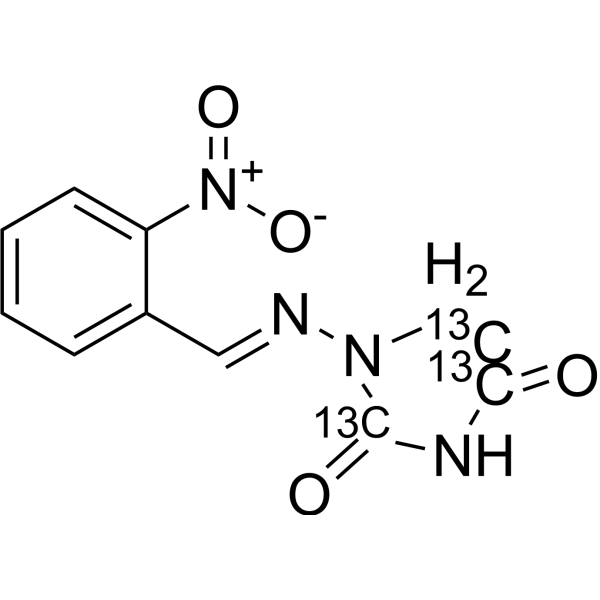
- HY-D1078
-
|
|
Reactive Oxygen Species
|
Others
|
|
5(6)-Carboxy-2',7'-dichlorofluorescein diacetate is a cell permeant fluorescent indicator. 5(6)-Carboxy-2',7'-dichlorofluorescein diacetate can be used to assess reactive oxygen species (ROS) generation within human neuronal-glial (HNG) cells in primary co-culture
|
-

- HY-113323
-
|
HMPG; MHPG; MOPEG
|
Endogenous Metabolite
|
Neurological Disease
|
|
3-Methoxy-4-hydroxyphenylglycol (HMPG) is a metabolite of norepinephrine degradation in the brain. 3-Methoxy-4-hydroxyphenylglycol is an indicators of central nervous system noradrenergic activity. 3-Methoxy-4-hydroxyphenylglycol can be used for research of depression, chronic schizophrenia, etc .
|
-
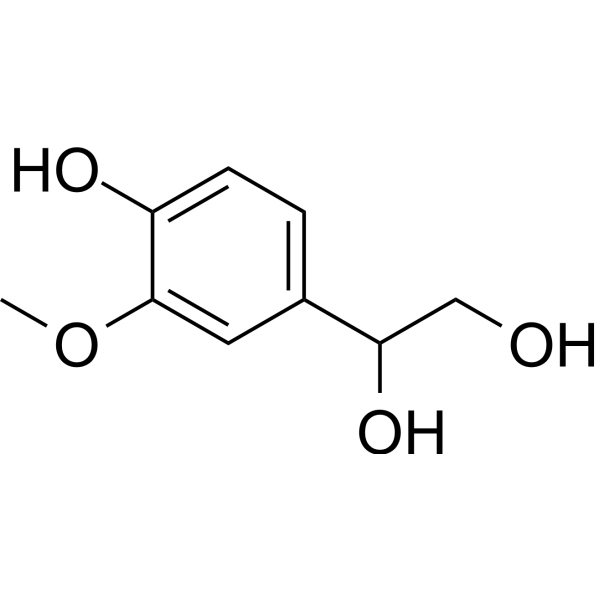
- HY-137805
-
|
|
Fluorescent Dye
|
Others
|
|
Ferrozine is a spectrophotometric reagent for iron, can react with divalent Fe to form a stable magenta complex species. The complex has an absorption peak at 562 nm .Ferrozine-based colorimetric assays can quantify iron in cells
|
-
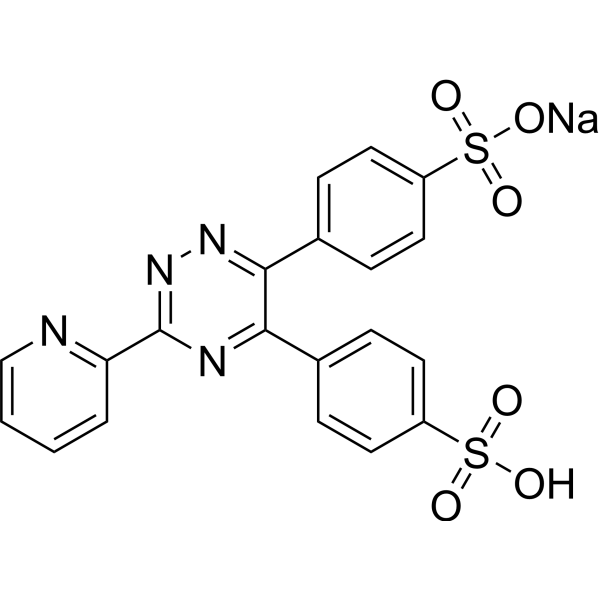
- HY-128369
-
|
Metanil Yellow
|
Cytochrome P450
|
Others
|
|
Acid Yellow 36 (Metanil Yellow) is an azo dye and a pH indicator. Acid Yellow 36 changes its color from red at pH 1.2 to yellow at pH 2.3. Acid Yellow 36 is used in the leather, paper and textile industries. Acid Yellow 36 acts as a bifunctional inducer of specific isozymes of P-450 and cytosolic enzymes .
|
-

- HY-125457
-
|
p-Naphtolbenzein
|
Fluorescent Dye
|
Others
|
|
α-Naphtholbenzein (p-Naphtolbenzein) is a dye. α-Naphtholbenzein can be used as a pH indicator. α-Naphtholbenzein has a visual transition from yellow (pH0-8.2) to turquoise (pH10). α-Naphtholbenzein is often used during sequential injection analysis technique done for acid-base titrations .
|
-
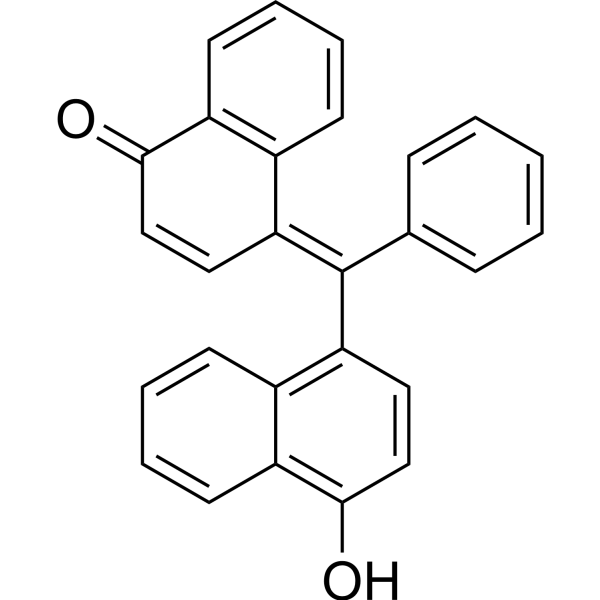
- HY-147181
-
|
|
Fluorescent Dye
|
Others
|
|
1,3-Di-(2-pyrenyl)propane is a fluorescent indicator. 1,3-Di-(2-pyrenyl)propane can be used in fluidity of bacterial membrane lipids monitored by intramolecular excimerization. 1,3-Di-(2-pyrenyl)propane shows temperature dependence of fluorescence lifetime distributions .
|
-
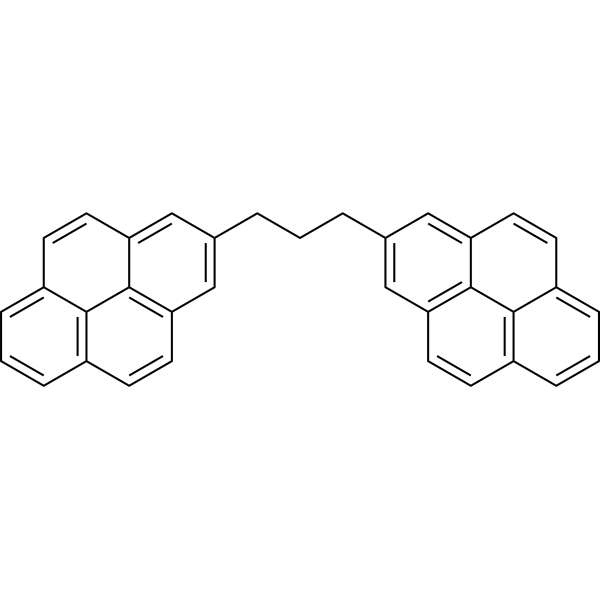
- HY-100168
-
|
|
Phospholipase
|
Others
|
|
BAPTA is a selective chelator for calcium. BAPTA, as calcium indicator, has high selectivity against magnesium and calcium. BAPTA is widely used as an intracellular buffer for investigating the effects of Ca 2+ release from intracellular stores or influx via Ca 2+-permeable channels in the plasma membrane. BAPTA can also inhibit phospholipase C activity independently of their role as Ca 2+ chelators .
|
-

- HY-15935C
-
|
|
Fluorescent Dye
|
Others
|
|
X-Gluc sodium is a dye reagent for the detection of β-glucuronidase (GUS), an enzyme produced by E. coli. X-Gluc sodium can be used to detect E. coli contamination in food, water and the urinary tract (GUS as a specific detection indicator). X-Gluc sodium is also widely used in molecular biology experiments to label and detect the expression of target genes (reacts with the GUS gene, appears blue) .
|
-

- HY-126821
-
|
|
Fluorescent Dye
|
Others
|
|
Fluo-3 and related molecule Fluo3/AM are used as a fluorescence indicator of intracellular calcium (Ca 2+). Fluo-3 may be use for flow cytometry and confocal laser scanning microscopy using visible light excitation (compatible with argon laser sources operating at 488 nm). Fluorescence intensity increases about 40-fold after calcium binding.
|
-
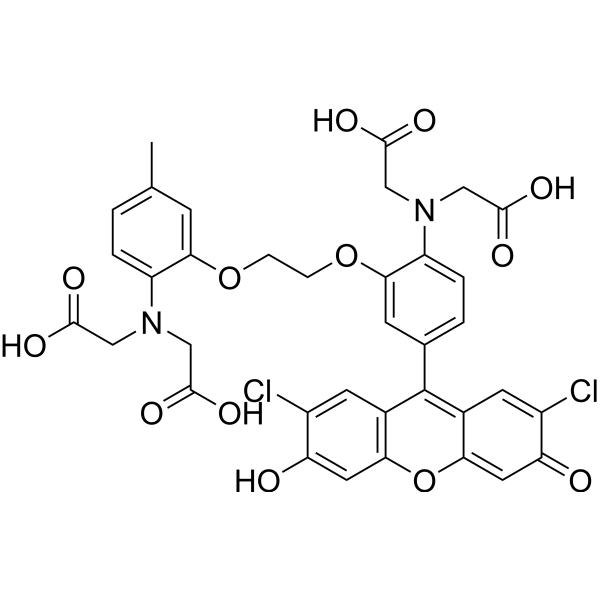
- HY-D0009
-
|
|
Fluorescent Dye
|
Others
|
|
Bromocresol green sodium is an anionic dye. Bromocresol green sodium can be used for pH indication and DNA agarose gel electrophoresis. Bromocresol green sodium is also used in mammalian albumin measurement. Bromocresol green sodium deprotonates and produces the monoanionic form of yellow colour at lower pH (acidic condition), and produces dianionic blue colour at the basic condition .
|
-

- HY-113465S
-
|
LTE4-d5
|
Endogenous Metabolite
|
Inflammation/Immunology
|
|
Leukotriene E4-d5 is the deuterium labeled Leukotriene E4. Leukotriene E4 (LTE4) is produced by the action of dipeptidase on LTD4. Leukotriene E4 is one of the constituents of slow-reacting substance of anaphylaxis (SRS-A). Leukotriene E4 accumulates in both plasma and urine and urinary excretion of Leukotriene E4 is most often used as an indicator of asthma.
|
-
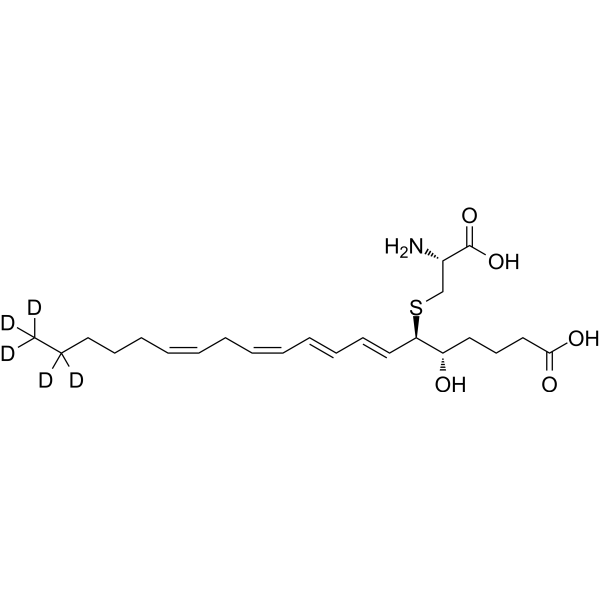
- HY-15935B
-
|
|
|
|
|
X-Gluc cyclohexanamine is a dye reagent for the detection of β-glucuronidase (GUS), an enzyme produced by E. coli. X-Gluc cyclohexanamine can be used to detect E. coli contamination in food, water and the urinary tract (GUS as a specific detection indicator). X-Gluc cyclohexanamine is also widely used in molecular biology experiments to label and detect the expression of target genes (reacts with the GUS gene, appears blue) .
|
-
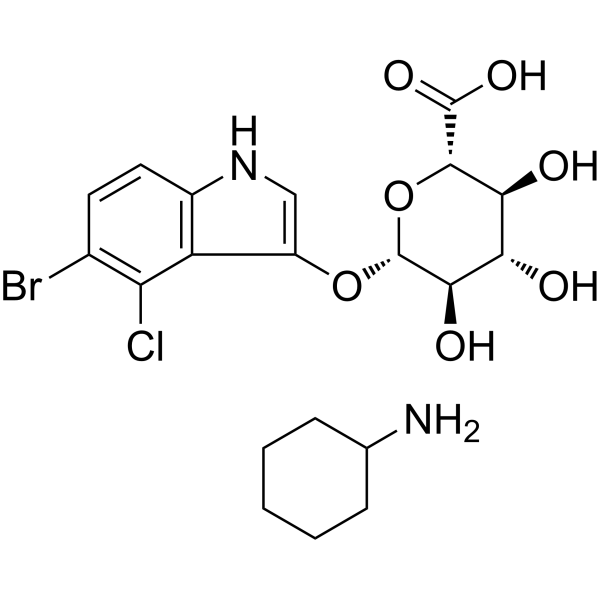
- HY-100168B
-
|
|
Phospholipase
|
Others
|
|
BAPTA tetrapotassium is a selective chelator for calcium. BAPTA, as calcium indicator, has high selectivity against magnesium and calcium. BAPTA tetrapotassium is widely used as an intracellular buffer for investigating the effects of Ca 2+ release from intracellular stores or influx via Ca 2+-permeable channels in the plasma membrane. BAPTA tetrapotassium can also inhibit phospholipase C activity independently of their role as Ca 2+ chelators .
|
-
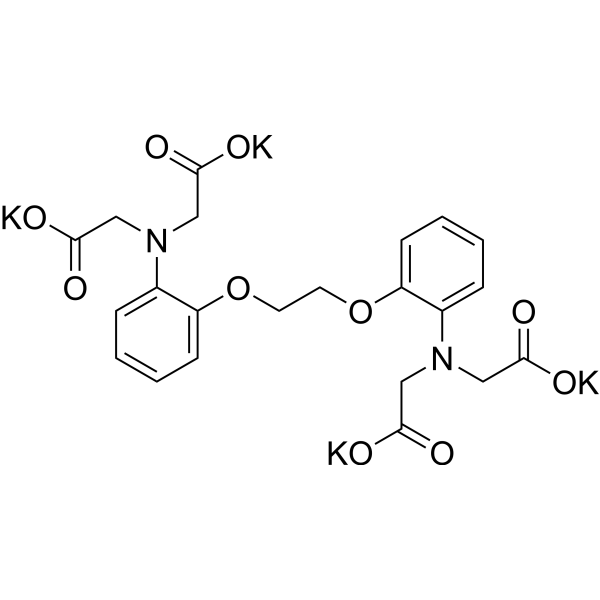
- HY-D0034
-
|
ABMDMA
|
Fluorescent Dye
|
Cancer
|
|
9,10-Anthracenediyl-bis(methylene)dimalonic acid (ABMDMA) is a biological dye and indicator used to detect singlet oxygen generation (SOG). 9,10-Anthracenediyl-bis(methylene)dimalonic acid is water-soluble derivative of anthracene. 9,10-Anthracenediyl-bis(methylene)dimalonic acid can be photobleached by singlet oxygen to its corresponding endoperoxide. This reaction can be monitored spectrophotometrically by recording the decrease of absorbance at 400 nm .
|
-

- HY-118540
-
|
Diazoresorcinol
|
Fluorescent Dye
|
Others
|
|
Resazurin (Diazoresorcinol) is a water-soluble, non-toxic, stable, membrane-permeable blue non-fluorescent dye (faintly fluorescent). Resazurin is used as a redox indicator, can be reduced to pink, highly fluorescent Resorufin (Ex=530-560 nm, Em=590 nm) in living cells. Resazurin can be used for the detection of cell viability, toxicity, proliferation, migration and invasion in cells (human, plant and animal, bacterial and fungal) .
|
-

- HY-W411215
-
|
|
Fluorescent Dye
|
Others
|
|
1,4-Diacetoxy-2,3-dicyanobenzene is a cell-permeable fluorescent probe. 1,4-Diacetoxy-2,3-dicyanobenzene crosses the cell membrane and is cleaved by cytosolic esterases to the fluorescent pH indicator 2,3-dicyano-hydroquinone (DCH). 1,4-Diacetoxy-2,3-dicyanobenzene can be used to monitor intracellular pH .
|
-
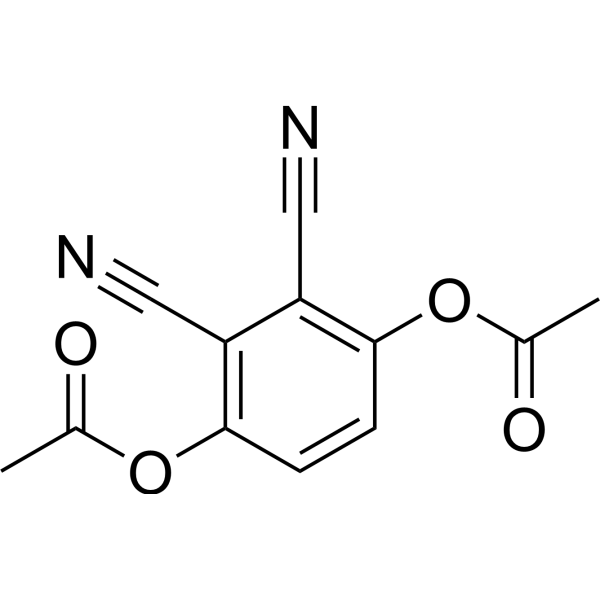
- HY-D1636
-
|
|
Fluorescent Dye
|
Others
|
|
5-Nitro BAPTA is a calcium chelator, combinded with 2-Me-substituted TM ( as a fluorescent moiety), can be used to form a red fluorescent probe (CaTM-2 AM), for imaging of cytoplasmic Ca 2+ in cultured living cells. 5-Nitro BAPTA is a building block used in the synthesis of Ca 2+ specific chelators, Ca 2+ buffers, and fluorescent Ca 2+ indicators .
|
-
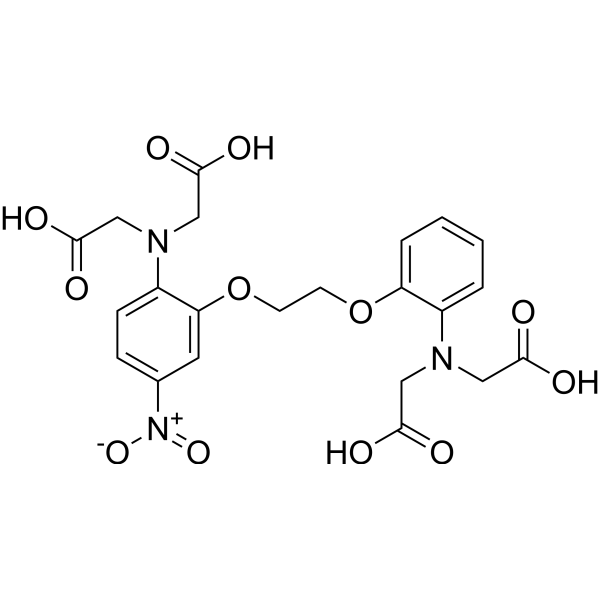
- HY-100168A
-
|
|
Phospholipase
|
Others
|
|
BAPTA tetrasodium is a selective chelator for calcium. BAPTA tetrasodium, as calcium indicator, has high selectivity against magnesium and calcium. BAPTA tetrasodium is widely used as an intracellular buffer for investigating the effects of Ca 2+ release from intracellular stores or influx via Ca 2+-permeable channels in the plasma membrane. BAPTA tetrasodium can also inhibit phospholipase C activity independently of their role as Ca 2+ chelators .
|
-

- HY-D0166A
-
|
|
Biochemical Assay Reagents
|
Others
|
|
Neutral Red (IND) is an organic dye commonly used in biology and cytology laboratories. It can be used to stain living cells, secreted proteins and other molecular structures, etc., and has a wide range of applications in cell imaging and staining. In addition, Neutral Red (IND) is widely used in industrial fields such as water treatment, food processing and paper manufacturing, for example as an indicator or colorant. Although the compound has no direct medical application, it has important application value in the fields of biology, chemistry and industry.
|
-

- HY-D1551
-
|
|
Fluorescent Dye
|
Others
|
|
10-(4-(Bis(2-hydroxyethyl)amino)phenyl)-5,5-difluoro-1,3,7,9-tetramethyl-5H-dipyrrolo[1,2-c:2',1'-f][1,3,2]diazaborinin-4-ium-5-uide, a BODIPY derivative, is a fluorescent indicator for detecting Pb 2+ (Ex=504 nM, Em=510 nM) .
|
-
![10-(4-(Bis(2-hydroxyethyl)amino)phenyl)-5,5-difluoro-1,3,7,9-tetramethyl-5H-dipyrrolo[1,2-c:2',1'-f][1,3,2]diazaborinin-4-ium-5-uide](//file.medchemexpress.com/product_pic/hy-d1551.gif)
- HY-D0079
-
|
Hydroethidine; PD-MY 003
|
Fluorescent Dye
|
Others
|
|
Dihydroethidium, also known as DHE, is a peroxide indicator. Dihydroethidium penetrates cell membranes to form a fluorescent protein complex with blue fluoresces. After entering the cells, Dihydroethidium is mainly localized in the cell membrane, cytoplasm and nucleus, and the staining effect is the strongest in the nucleus. Dihydroethidium produces inherent blue fluorescence with a maximum excitation wavelength of 370 nm and a maximum emission wavelength of 420 nm; after dehydrogenation, Dihydroethidium combines with RNA or DNA to produce red fluorescence with a maximum excitation wavelength of 300 nm and a maximum emission wavelength of 610 nm. 535 nm can also be used as the excitation wavelength for actual observation .
|
-

- HY-D1447
-
|
|
Fluorescent Dye
|
Others
|
|
Fluo-3FF pentapotassium is a cell-permeable acetoxy-methyl ester of Fluo-3FF, a fluorescent calcium indicator. Fluo-3FF is a di-fluorinated analog of Fluo-3 with a 100-fold lower affinity than Fluo-3 for calcium (Kds = 42 and 0.4 碌M, respectively). For its low affinity, Fluo-3FF is used for studying compartments with high concentrations of calcium, such as endoplasmic reticulum, where high affinity dyes will be insensitive to luminal fluctuations.
|
-
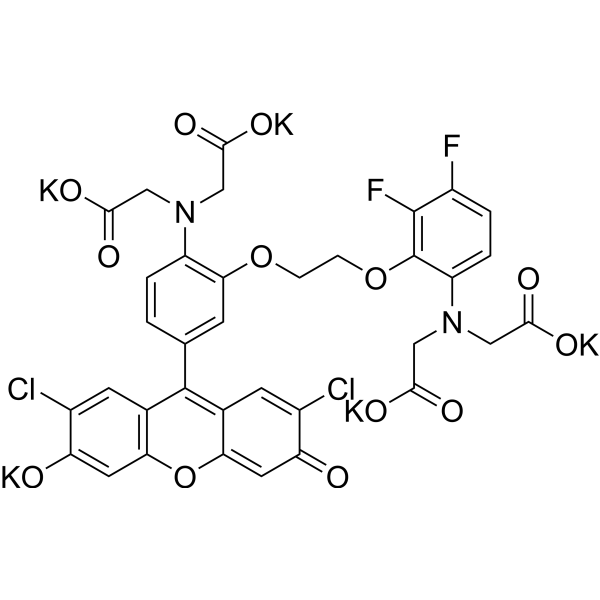
- HY-W040144
-
|
|
Fluorescent Dye
|
Others
|
|
Bromocresol green is a pH-sensitive triphenylmethane dye commonly used for the determination of protein and albumin in serum. Bromocresol green is a bio-based dye with a yellow-green to blue-green color. Bromocresol green turns yellow (λmax=435 nm, protonated form) when placed in acidic solution (e.g. pH=4.15), and turns blue in basic solution (λmax=615 nm, deprotonated form). Bromocresol green is widely used as a pH indicator in the field of biochemical analysis. In addition, Bromocresol green is also used to detect the concentration of molecules such as creatinine, and to judge the viability of cells .
|
-
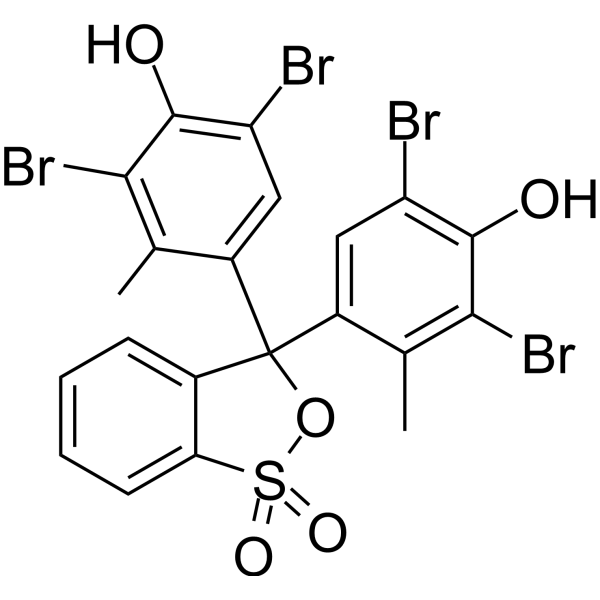
- HY-W250147
-
|
Victoria blue B
|
Biochemical Assay Reagents
|
Others
|
|
Basic blue 26 (Victoria blue B) is a synthetic cationic dye belonging to the class of triarylmethane dyes. It has a bright blue color and is commonly used as a colorant for a variety of applications, including textiles, paper and leather. Basic Blue 26 is also used as a biological stain for DNA and protein detection in laboratories. Due to its ability to bind negatively charged materials, it can be used as an indicator of the presence of specific molecules in biological samples. However, Basic blue 26 has been reported to have potentially harmful effects on human health and the environment and its use is regulated in some countries. Proper handling and disposal procedures are necessary to minimize its impact on the environment.
|
-
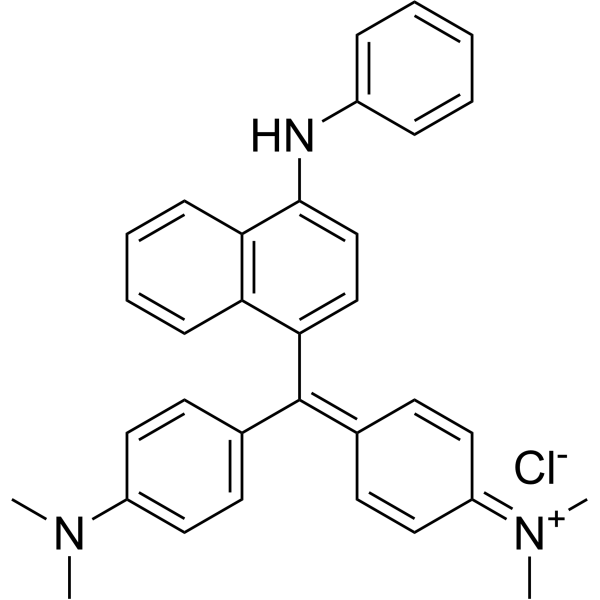
- HY-W250148
-
|
Spirit nigrosine
|
Biochemical Assay Reagents
|
Others
|
|
Solvent black 5 (Spirit nigrosine) is a synthetic dye belonging to the family of azo dyes. Also known as oil black or naphthol black, it is dark blue-black and has excellent solubility in organic solvents. Solvent black 5 is commonly used as a colorant in various industrial applications such as printing inks, coatings and plastics. It can also be used as an indicator dye to detect the presence of metals in solution. Furthermore, due to its high absorption and emission properties in the near-infrared region, it has been used in scientific research as a fluorescent biomarker for tissues and cells. However, Solvent black 5 has been reported to have potentially toxic effects on human health and the environment and its use is therefore regulated in some countries.
|
-

- HY-B1422S
-
|
Aminacrine-13C6
|
Bacterial
HIV
Isotope-Labeled Compounds
|
Infection
|
|
9-Aminoacridine-13C6 is the 13C-labeled 9-Aminoacridine(HY-B1422). 9-Aminoacridine, a fluorescent probe, acts as an indicator of pH for quantitative determination of transmembrane pH gradients (inside acidic). 9-Aminoacridine is an antimicrobial. 9-Aminoacridine exerts its antimicrobial activity by interacting with specific bacterial DNA and disrupting the proton motive force in K. pneumoniae. 9-Aminoacridine is a HIV-1 inhibitor and inhibits HIV LTR transcription highly dependent on the presence and location of the amino moiety. 9-Aminoacridine inhibits virus replication in HIV-1 infected cell lines. 9-Aminoacridine is used as a Rifampin (RIF; HY-B0272) adjuvant for the multidrug-resistant K. pneumoniae infections .
|
-

| Cat. No. |
Product Name |
Type |
-
- HY-D1620
-
-
- HY-126821A
-
|
|
Fluorescent Dyes/Probes
|
|
Fluo-3 pentaammonium is a fluorescence indicator of intracellular calcium (Ca 2+). Excitation/Emission = 488/525 nm .
|
-
- HY-D0219A
-
|
|
Fluorescent Dyes/Probes
|
|
Thymol Blue sodium is an acid-base indicator used to indicate changes in pH. Thymol Blue sodium fades from red to yellow at pH 1.2 to 2.8 and from yellow to blue at pH 8.0 to 9.6 .
|
-
- HY-W351340
-
|
|
Fluorescent Dyes/Probes
|
|
4-(Benzyloxy)-2-nitrophenol is a synthetic building block that can be used in the synthesis of fluorescent ion indicators .
|
-
- HY-D1628
-
-
- HY-D0219
-
|
Thymolsulphonephthalein
|
Fluorescent Dyes/Probes
|
|
Thymol Blue sodium is an acid-base indicator used to indicate changes in pH. Thymol Blue sodium fades from red to yellow at pH 1.2 to 2.8 and from yellow to blue at pH 8.0 to 9.6 . Storage: protect from light.
|
-
- HY-D0168
-
|
3,5-Dihydroxytoluene
|
Dyes
|
|
Orcinol (3,5-Dihydroxytoluene) is an organic compound used as biological dye and indicator for proteomics research.
|
-
- HY-D1492
-
|
|
Dyes
|
|
Fast Sulphon Black F is a specific copper indicator. Fast Sulphon Black F can be used for EDTA titration .
|
-
- HY-D0169A
-
|
Phenolsulfonephthalein sodium salt
|
Dyes
|
|
Phenol red (Phenolsulfonephthalein) sodium salt is a pH indicator dye, relying on a distinct color change from pink to yellow in case of a positive reaction .
|
-
- HY-D1436
-
|
|
Fluorescent Dyes/Probes
|
|
PBFI is the fluorescent indicator that is widely used for the determination of intracellular concentrations of K + .
|
-
- HY-D1484
-
|
1,1'-Diethyl-2,4'-cyanine iodide
|
Dyes
|
|
Ethyl red (1,1'-Diethyl-2,4'-cyanine) iodide is an azo dye and acid–base indicator .
|
-
- HY-W351339
-
|
|
Fluorescent Dyes/Probes
|
|
BAPTA-TMFM is a fluorescent chelating indicator used to study the role of cytosolic free calcium.
|
-
- HY-W110904
-
|
|
Dyes
|
|
Methylthymol blue tetrasodium is a metallochromic indicator dye and can be used for determination of sulfate and calcium .
|
-
- HY-D0215
-
|
Safranine T
|
Dyes
|
|
Safranin (Safranin T) is an important and classical phenazinium dye. Safranin has been extensively used in the academic field as a spectroscopic probe and indicator. Safranin possesses a planar structure and cationic charge. It can readily intercalate into biological macromolecules, including DNA and proteins. Safranin can be used as a redox indicator in the determination of metal ion concentration .
|
-
- HY-D0121
-
|
|
Fluorescent Dyes/Probes
|
|
INDO 1 is a fluorescent Ca 2+ indicator, binds specifically to Ca 2+ while emitting fluorescence, the maximum emission wavelength shifts from 485 nm before binding to 410 nm .
|
-
- HY-D0140
-
|
ETH 5294
|
Fluorescent Dyes/Probes
|
|
Chromoionophore I (ETH 5294) is a hydrophobic pH indicator. Chromoionophore I is used as a transmissive or fluorescent probe molecule in many types of hydrophobic sensor membranes. Chromoionophore I is oil-soluble .
|
-
- HY-D0121A
-
|
|
Fluorescent Dyes/Probes
|
|
INDO 1 pentapotassium is a fluorescent Ca 2+ indicator, binds specifically to Ca 2+ while emitting fluorescence, the maximum emission wavelength shifts from 485 nm before binding to 410 nm .
|
-
- HY-D0023
-
|
HPTS; Solvent Green 7
|
Fluorescent Dyes/Probes
|
|
Pyranine (HPTS; Solvent Green 7) is a pH-sensitive fluorescent indicator. Pyranine acts as a class of fluorescent chemosensor for the Cu + ion(λex=450 nm, λem=510 nm) .
|
-
- HY-118320
-
|
Mordant orange 1
|
Fluorescent Dyes/Probes
|
|
Alizarine Yellow R (Mordant orange 1), a salicylic acid derivative, is a azo dye. Alizarine Yellow R is mostly used as a pH indicator, as a biological stain in chemical examinations and also in dyeing industries .
|
-
- HY-D1442
-
|
|
Fluorescent Dyes/Probes
|
|
SBFI (tetraammonium), the tetraammonium salt of SBFI, is a sodium fluorescence indicator. SBFI (tetraammonium) is sodium-sensitive dye. The excitation wavelength is set 333 nm, and the emission wavelength is 539 nm for SBFI .
|
-
- HY-D0169
-
|
Phenolsulfonephthalein
|
Dyes
|
|
Phenol red (Phenolsulfonephthalein) is a pH indicator dye, relying on a distinct color change from pink to yellow in case of a positive reaction .
|
-
- HY-D1091
-
|
|
Fluorescent Dyes/Probes
|
|
DiSBAC2(3) is an anionic membrane-potential-sensitive dye. DiSBAC2(3) is a plasma membrane potential indicator .
|
-
- HY-D1616
-
|
|
Dyes
|
|
5-Bromo-5'-methyl BAPTA tetramethyl ester is a derivative of BAPTA, which is a calcium indicator suitable for measurement of relatively high level of calcium .
|
-
- HY-137103
-
|
|
Fluorescent Dyes/Probes
|
|
BTC-AM is a low affinity calcium indicator. BTC-AM has substantial calcium-independent fluorescence at all excitation wavelengths. BTC-AM is readily loaded into neurons and is rapidly hydrolysed .
|
-
- HY-W142631
-
|
|
Dyes
|
|
4-(Phenylazo)diphenylamine is an excellent colorimetric indicator for the accurate determination of the concentration for a variety of strong bases, Lewis acids, and hydride reducing agents .
|
-
- HY-D1435
-
|
|
Fluorescent Dyes/Probes
|
|
Oxonol VI acts as an optical indicator for membrane potentials in lipid vesicles. Oxonol VI is suitable for detecting changes of membrane potential associated with the activity of the (Na + + K +)-ATPase in reconstituted vesicles .
|
-
- HY-D0142
-
|
|
Fluorescent Dyes/Probes
|
|
Pyrene-1,3,6,8-tetrasulfonic acid tetrasodium is a fluorescent dye and pH indicator, also as a ligand of multifunctional metal-organic framework. Pyrene-1,3,6,8-tetrasulfonic acid tetrasodium has been used to detect CO2 release .
|
-
- HY-D1755
-
|
|
Fluorescent Dyes/Probes
|
|
Fluo-3FF AM is a low affinity (Kd = 42 μM) fluorescent Ca 2+ sensitive indicator (Abs/Em = 462 nm/526 nm). Fluo-3FF AM is Mg 2+ insensitive and relatively photostable. Fluo-3FF AM is an analog of Fluo-3FF AM. Fluo-3FF AM is essentially non-fluorescent, but exhibits a strong fluorescence enhancement upon entry into cells and binding to calcium.
|
-
- HY-D1536
-
|
|
Fluorescent Dyes/Probes
|
|
Glycine cresol red is a complexometric indicator. Glycine cresol red forms coloured complexes with Al 3+, Ga 3+ and In 3+ ions in aqueous solutions. Glycine cresol red can been used for the spectrophotometric determination of inorganic ions. Glycine cresol red can be used as a stain in neurohistology .
|
-
- HY-D1055
-
|
|
Fluorescent Dyes/Probes
|
MitoSOX Red is a live cell fluorescent probe that specifically targets mitochondria and is cell membrane permeable. MitoSOX Red enters mitochondria and is oxidized by superoxide but not by other ROS or RNS generating systems. The oxidized MitoSOX Red then binds to nucleic acids in mitochondria/nucleus, producing strong red fluorescence. MitoSOX Red can be used as a fluorescent indicator to specifically detect superoxide. In addition, superoxide dismutase (SOD) can prevent the oxidation of MitoSOX Red.
Excitation/emission wavelength: 510/580 nm.
|
-
- HY-D0166
-
|
|
Dyes
|
|
Neutral Red, a nitrogenous pH-indicator with a pKi of 6.8, is an indicator for the internal acidification of thylakoids. Neutral Red stains lysosomes red .
|
-
- HY-D0040
-
Calcein
4 Publications Verification
Fluorexon
|
Fluorescent Dyes/Probes
|
|
Calcein is a fluorescent dye and self-quenching probe, used as an indicator of lipid vesicle leakage, and also as a complexometric indicator for titration of calcium ions with EDTA, and for fluorometric determination of calcium.
|
-
- HY-D0012
-
|
|
Dyes
|
|
Bromothymol Blue is a pH indicator.
|
-
- HY-D0948
-
|
|
Dyes
|
|
Celestine Blue is a electroactive indicator in DNA biosensors. Celestine Blue is strongly adsorbed on the spinel phases and CNT (carbon nanotubes), facilitates dispersion, acts as a capping agent and allows for the fabrication of spinel decorated CNT. Celestine Blue is an efficient charge transfer mediator, which allows for significant improvement of capacitive behavior. TiO2 nanoparticles doped with Celestine Blue can be used as a label in a sandwich immunoassay for the hepatitis C virus (HCV) core antigen .
|
-
- HY-W331502
-
|
|
Dyes
|
|
Chlorophenol Red sodium is a pH indicator .
|
-
- HY-D1176
-
|
|
Fluorescent Dyes/Probes
|
|
Calcium Green 1AM is a cell-permeant fluorescent calcium indicator (Excitation 506 nm; Emission 531 nm). Calcium Green 1AM is converted to the fluorescent calcium indicator by intracellular esterases .
|
-
- HY-D0211
-
-
- HY-D1445
-
|
|
Fluorescent Dyes/Probes
|
|
PDMPO, a lysosome pH indicator, is an excellent fluorescent acidotropic reagent for fluorescence imaging. PDMPO is a potent tool with which to study acidic organelles of live cells. PDMPO exhibits pH-dependent dual-excitation and dual-emission spectral peaks. PDMPO produces a blue fluorescence in weakly acidic organelles and shifts to yellow in more acidic lysosomes (Abs=329 nm; Em=440 nm) .
|
-
- HY-101896
-
-
- HY-D0801
-
|
|
Fluorescent Dyes/Probes
|
|
Calmagite is a complexometric indicator which can be used to detect calcium and magnesium in various samples.
|
-
- HY-D1401
-
|
|
Fluorescent Dyes/Probes
|
|
OG 488, acid, a fluorescent pH indicator, has many applications in biochemistry and neurosciences .
|
-
- HY-D1779
-
-
- HY-101883
-
|
|
Fluorescent Dyes/Probes
|
|
BCECF-AM is a cell membrane permeable compound widely used as a fluorescent indicator for intracellular pH.
|
-
- HY-D0081A
-
-
- HY-D1502
-
-
- HY-D1750
-
|
|
Fluorescent Dyes/Probes
|
|
Rhodamine B thiolactone is a high-sensitive Hg 2+ indicator used for measuring Hg 2+ concentration.
|
-
- HY-D1776
-
|
|
Fluorescent Dyes/Probes
|
|
FFP-18-AM is a cell-permeable fluorescent indicator for measurement of near-membrane calcium.
|
-
- HY-126831
-
|
|
Fluorescent Dyes/Probes
|
|
SBFI-AM is a Na + selective fluorescent indicator. SBFI-AM shows selectivity for Na + over K + .
|
-
- HY-D1761
-
|
|
Fluorescent Dyes/Probes
|
|
Fura-4F pentapotassium is a cell-impermeant fluorescent indicator for intracellular calcium ion measurement.
|
-
- HY-101897
-
|
Fura-2 Acetoxymethyl ester
|
Fluorescent Dyes/Probes
|
|
Fura-2 AM is a high affinity, intracellular, UV light-excitable and ratiometric fluorescent Ca 2+ indicator.
|
- HY-B1422
-
|
Aminacrine
|
Fluorescent Dyes/Probes
|
|
9-Aminoacridine, a fluorescent probe, acts as an indicator of pH for quantitative determination of transmembrane pH gradients (inside acidic). 9-Aminoacridine is an antimicrobial. 9-Aminoacridine exerts its antimicrobial activity by interacting with specific bacterial DNA and disrupting the proton motive force in K. pneumoniae. 9-Aminoacridine is a HIV-1 inhibitor and inhibits HIV LTR transcription highly dependent on the presence and location of the amino moiety. 9-Aminoacridine inhibits virus replication in HIV-1 infected cell lines. 9-Aminoacridine is used as a Rifampin (RIF; HY-B0272) adjuvant for the multidrug-resistant K. pneumoniae infections .
|
- HY-133527
-
|
Oregon green 488 succinimidyl ester
|
Dyes
|
|
OG 488, SE (Oregon green 488 succinimidyl ester), a fluorescent pH indicator, has many applications in biochemistry and neurosciences .
|
- HY-130575
-
|
|
Fluorescent Dyes/Probes
|
|
Fura-FF AM is a cell-permeable acetoxymethyl ester of fura-FF, a dluorescent calcium indicator. Fura-FF AM is hydrolyzed by intracellular esterases to release fura-FF in cells. Fura-FF is a difluorinated derivative of the calcium indicator fura-2. Compared to fura-2, fura-FF has a low affinity for calcium and is suitable for studying compartments with high concentrations of calcium.
|
- HY-D0110A
-
|
|
Fluorescent Dyes/Probes
|
|
Fura-2 pentapotassium is a scaled fluorescent dye that can be used for intracellular calcium imaging with the Kd value of 140 nM. Fura-2 pentapotassium has an emission wavelength of 510 nm and excitation wavelengths of 340 nm or 380 nm and the ratio of 340/380 fluorescence intensity is proportional to the intracellular Ca 2+ level .
|
- HY-D1477
-
|
|
Fluorescent Dyes/Probes
|
|
5(6)-Carboxyfluorescein diisobutyrate is a protected 5(6)-carboxyfluorescein. 5(6)-carboxyfluorescein is a fluorescence pH indicator .
|
- HY-W110883
-
|
|
Dyes
|
|
Xylenol Orange (tetrasodium), metal indicator, AR is a biochemical reagent that can be used as a biological material or organic compound for life science related research.
|
- HY-101887
-
|
|
Fluorescent Dyes/Probes
|
|
Calcein Blue, a membrane-impermeant fluorescent dye, is a coumarin derivative that contains an iminodiacetic acid structure. Calcein Blue is also a metallofluorochromic indicator .
|
- HY-W110884
-
|
|
Dyes
|
|
Eriochrome cyanine R indicator (C.I. 43820) is a biochemical reagent that can be used as a biological material or organic compound for life science related research.
|
- HY-D1758
-
|
|
Fluorescent Dyes/Probes
|
|
Fura-5F AM is a membrane-permeant fluorescent calcium indicator. Upon entering the cell, this probe is hydrolyzed by cytosilic esterases and trapped as the active chelator.
|
- HY-D1759
-
|
|
Fluorescent Dyes/Probes
|
|
Fura-4F AM is a cell-permeant fluorescent calcium indicator. Upon entering the cell, this probe is hydrolyzed by cytosilic esterases and trapped as the active chelator.
|
- HY-D1773
-
|
|
Fluorescent Dyes/Probes
|
|
YOYO-3 is a cell-impermeant dye with far-red fluorescence used as nulear counterstain and dead cell indicator. It generates bright fluorescence upon binding to DNA.
|
- HY-D1488
-
|
|
Fluorescent Dyes/Probes
|
|
Ethyl benzo[6,7]-4-oxo-4H-quinolizine-3-carboxlate (Compound 3) is a Mg 2+ selective fluorescent indicator .
|
- HY-D0112
-
|
|
Fluorescent Dyes/Probes
|
|
7-Hydroxycoumarin-4-acetic acid, a pH-indicator dye, is covalently bound to bovine serum albumin (BSA) at the positions of reactive amino groups (λmax=326 nm) .
|
- HY-D1760
-
|
Sodium-binding benzofuran isophthalate
|
Fluorescent Dyes/Probes
|
|
SBFI is a membrane-permeant, fluorescent Na + indicator dye. SBFI is excited at 340 nm and the fluorophore emission is collected at 450 nm . SBFI selective for Na + over K + with Kd values of 20 and 120 mM for these ions, respectively. .
|
- HY-131510
-
|
SNARF-DE
|
Dyes
|
|
Chromoionophore XIII (SNARF-DE) is a pH senor that enables excitation with red light. Chromoionophore XIII functionality renders the indicator molecule lipophilic and water-insoluble but also prevents lactonization of the dye in an apolar environment .
|
- HY-W074143
-
|
|
Fluorescent Dyes/Probes
|
|
Tris(4,7-diphenyl-1,10-phenanthroline)ruthenium(II) dichloride is an oxygen-sensitive fluorescent indicator widely used as a probe for luminescence detection and quantitative oxygen determination .
|
- HY-129547
-
|
|
Fluorescent Dyes/Probes
|
|
Fluo-3 pentapotassium is a fluorescent indicator for intracellular Ca 2+ that is used in flow cytometry and cell-based experiments. Fluo-3 pentapotassium produces fluorescence with an emission maximum at 525 nm upon binding to calcium.
|
- HY-D1769
-
|
|
Fluorescent Dyes/Probes
|
|
N-hydroxy Rhodamine B amide is a ClO - indicator, which is hydrolyzed to prduce fluorescence in the presence of ClO -. The fluorescence intensity of N-hydroxy Rhodamine B amide is proportional to the product, thus can be used to quantify ClO -.
|
- HY-104058
-
|
Oregon Green 488 BAPTA 1AM
|
Fluorescent Dyes/Probes
|
|
Oregon-BAPTA Green 1AM (Oregon Green 488 BAPTA 1AM) is a fluorescent Ca 2+ indicator that consists of a green fluorescent probe OG 488 and a cell-permeable Ca 2+ chelator BAPTA AM.
|
- HY-D1894
-
|
|
Fluorescent Dyes/Probes
|
|
5-Br-PAPS is a highly specific Zn 2+ metallochromic indicator. 5-Br-PAPS is used in assays for measuring free Zn 2+ by forming a deeply colored red Zn 2+ complex .
|
- HY-D0015A
-
|
|
Dyes
|
|
Cresol Red sodium is a triarylmethane dye. Cresol Red sodium can be used for indicating pH, temperatures and salinities .
|
- HY-D1768
-
|
|
Fluorescent Dyes/Probes
|
|
Fluo-4FF AM is a cell-permeant fluorescent calcium indicator. Fluo-4FF is an analog of Fluo-4 with a lower affinity for calcium, which is suitable for investigation of relatively high level of intracellular calcium.
|
- HY-D0720
-
|
NSC-151912; L-6868
|
Fluorescent Dyes/Probes
|
|
Lucigenin is a chemiluminescence probe. Lucigenin can be used to detect the production of endogenous superoxide anion radical (O 2-). Lucigenin is extremely sensitive to chloride ions, while it combined with chloride ions, the fluorescence will be quenched. Lucigenin also can be used as a chloride indicator. Ex/Em=455/505 nm .
|
- HY-D1702
-
|
|
Fluorescent Dyes/Probes
|
|
Mag-Fura-2 tetrapotassium is a UV excitable rational fluorescent Mg 2+/Ca 2+ indicator (Ex=334-360 nm, Em=510 nm). Mag-Fura-2 tetrapotassium can be used for the determination of Mg 2+ and Ca 2+ concentrations .
|
- HY-111330
-
|
HPF; 3'-p-(Hydroxyphenyl) fluorescein
|
Fluorescent Dyes/Probes
|
|
Hydroxyphenyl Fluorescein (HPF) is a stable ROS fluorescent probe dye. Hydroxyphenyl Fluorescein has stronger specificity and stability than H2DCFDA (HY-D0940). Hydroxyphenyl Fluorescein can produce strong green fluorescence through hydroxyl radical reaction with intracellular peroxynitroso. Hydroxyphenyl Fluorescein can be applied for fluorescence microscopy, high-throughput imager, luciferase microplate reader or flow cytometry. Ex/Em=490/515 nm .
|
- HY-D1700
-
|
|
Fluorescent Dyes/Probes
|
|
Mag-indo-1/AM is a cell-permeable fluorescent indicator for Mg 2+ and also for Ca 2+ (Ex=340-390 nm, Em=410-490 nm). Mag-indo-1/AM can be used to determine intracellular Mg 2+ and Ca 2+ concentrations .
|
- HY-D0018
-
|
Dichlorophenylindophenol sodium; DCPIP sodium; Indochlorophenol sodium
|
Dyes
|
|
DCIP sodium is a blue dye commonly used in various biochemical and biotechnological applications as an indicator of redox reactions. DCIP sodium has unique chemical properties that change color according to the oxidation state of the substance being tested. It is commonly used in enzyme assays, such as measuring the activity of succinate dehydrogenase, or in protein quantification methods, such as the Lowry assay.
|
- HY-137805
-
|
|
Dyes
|
|
Ferrozine is a spectrophotometric reagent for iron, can react with divalent Fe to form a stable magenta complex species. The complex has an absorption peak at 562 nm .Ferrozine-based colorimetric assays can quantify iron in cells
|
- HY-128369
-
|
Metanil Yellow
|
Dyes
|
|
Acid Yellow 36 (Metanil Yellow) is an azo dye and a pH indicator. Acid Yellow 36 changes its color from red at pH 1.2 to yellow at pH 2.3. Acid Yellow 36 is used in the leather, paper and textile industries. Acid Yellow 36 acts as a bifunctional inducer of specific isozymes of P-450 and cytosolic enzymes .
|
- HY-15935C
-
|
|
Fluorescent Dyes/Probes
|
|
X-Gluc sodium is a dye reagent for the detection of β-glucuronidase (GUS), an enzyme produced by E. coli. X-Gluc sodium can be used to detect E. coli contamination in food, water and the urinary tract (GUS as a specific detection indicator). X-Gluc sodium is also widely used in molecular biology experiments to label and detect the expression of target genes (reacts with the GUS gene, appears blue) .
|
- HY-126821
-
|
|
Fluorescent Dyes/Probes
|
|
Fluo-3 and related molecule Fluo3/AM are used as a fluorescence indicator of intracellular calcium (Ca 2+). Fluo-3 may be use for flow cytometry and confocal laser scanning microscopy using visible light excitation (compatible with argon laser sources operating at 488 nm). Fluorescence intensity increases about 40-fold after calcium binding.
|
- HY-D0009
-
|
|
Dyes
|
|
Bromocresol green sodium is an anionic dye. Bromocresol green sodium can be used for pH indication and DNA agarose gel electrophoresis. Bromocresol green sodium is also used in mammalian albumin measurement. Bromocresol green sodium deprotonates and produces the monoanionic form of yellow colour at lower pH (acidic condition), and produces dianionic blue colour at the basic condition .
|
- HY-D0034
-
|
ABMDMA
|
Dyes
|
|
9,10-Anthracenediyl-bis(methylene)dimalonic acid (ABMDMA) is a biological dye and indicator used to detect singlet oxygen generation (SOG). 9,10-Anthracenediyl-bis(methylene)dimalonic acid is water-soluble derivative of anthracene. 9,10-Anthracenediyl-bis(methylene)dimalonic acid can be photobleached by singlet oxygen to its corresponding endoperoxide. This reaction can be monitored spectrophotometrically by recording the decrease of absorbance at 400 nm .
|
- HY-118540
-
|
Diazoresorcinol
|
Fluorescent Dyes/Probes
|
|
Resazurin (Diazoresorcinol) is a water-soluble, non-toxic, stable, membrane-permeable blue non-fluorescent dye (faintly fluorescent). Resazurin is used as a redox indicator, can be reduced to pink, highly fluorescent Resorufin (Ex=530-560 nm, Em=590 nm) in living cells. Resazurin can be used for the detection of cell viability, toxicity, proliferation, migration and invasion in cells (human, plant and animal, bacterial and fungal) .
|
- HY-W411215
-
|
|
Fluorescent Dyes/Probes
|
|
1,4-Diacetoxy-2,3-dicyanobenzene is a cell-permeable fluorescent probe. 1,4-Diacetoxy-2,3-dicyanobenzene crosses the cell membrane and is cleaved by cytosolic esterases to the fluorescent pH indicator 2,3-dicyano-hydroquinone (DCH). 1,4-Diacetoxy-2,3-dicyanobenzene can be used to monitor intracellular pH .
|
- HY-D0166A
-
|
|
Dyes
|
|
Neutral Red (IND) is an organic dye commonly used in biology and cytology laboratories. It can be used to stain living cells, secreted proteins and other molecular structures, etc., and has a wide range of applications in cell imaging and staining. In addition, Neutral Red (IND) is widely used in industrial fields such as water treatment, food processing and paper manufacturing, for example as an indicator or colorant. Although the compound has no direct medical application, it has important application value in the fields of biology, chemistry and industry.
|
- HY-D0079
-
|
Hydroethidine; PD-MY 003
|
Fluorescent Dyes/Probes
|
|
Dihydroethidium, also known as DHE, is a peroxide indicator. Dihydroethidium penetrates cell membranes to form a fluorescent protein complex with blue fluoresces. After entering the cells, Dihydroethidium is mainly localized in the cell membrane, cytoplasm and nucleus, and the staining effect is the strongest in the nucleus. Dihydroethidium produces inherent blue fluorescence with a maximum excitation wavelength of 370 nm and a maximum emission wavelength of 420 nm; after dehydrogenation, Dihydroethidium combines with RNA or DNA to produce red fluorescence with a maximum excitation wavelength of 300 nm and a maximum emission wavelength of 610 nm. 535 nm can also be used as the excitation wavelength for actual observation .
|
- HY-D1447
-
|
|
Fluorescent Dyes/Probes
|
|
Fluo-3FF pentapotassium is a cell-permeable acetoxy-methyl ester of Fluo-3FF, a fluorescent calcium indicator. Fluo-3FF is a di-fluorinated analog of Fluo-3 with a 100-fold lower affinity than Fluo-3 for calcium (Kds = 42 and 0.4 碌M, respectively). For its low affinity, Fluo-3FF is used for studying compartments with high concentrations of calcium, such as endoplasmic reticulum, where high affinity dyes will be insensitive to luminal fluctuations.
|
- HY-W250147
-
|
Victoria blue B
|
Dyes
|
|
Basic blue 26 (Victoria blue B) is a synthetic cationic dye belonging to the class of triarylmethane dyes. It has a bright blue color and is commonly used as a colorant for a variety of applications, including textiles, paper and leather. Basic Blue 26 is also used as a biological stain for DNA and protein detection in laboratories. Due to its ability to bind negatively charged materials, it can be used as an indicator of the presence of specific molecules in biological samples. However, Basic blue 26 has been reported to have potentially harmful effects on human health and the environment and its use is regulated in some countries. Proper handling and disposal procedures are necessary to minimize its impact on the environment.
|
- HY-W250148
-
|
Spirit nigrosine
|
Dyes
|
|
Solvent black 5 (Spirit nigrosine) is a synthetic dye belonging to the family of azo dyes. Also known as oil black or naphthol black, it is dark blue-black and has excellent solubility in organic solvents. Solvent black 5 is commonly used as a colorant in various industrial applications such as printing inks, coatings and plastics. It can also be used as an indicator dye to detect the presence of metals in solution. Furthermore, due to its high absorption and emission properties in the near-infrared region, it has been used in scientific research as a fluorescent biomarker for tissues and cells. However, Solvent black 5 has been reported to have potentially toxic effects on human health and the environment and its use is therefore regulated in some countries.
|
| Cat. No. |
Product Name |
Type |
-
- HY-W110798
-
|
|
Biochemical Assay Reagents
|
|
Bromophenol blue indicator (3.0-4.6) is a synthetic dye commonly used as an acid-base indicator with a transition range of pH 3.0-4.6. Bromophenol blue indicator (3.0-4.6) is water soluble and changes color from yellow to blue as the pH of the solution changes from acidic to basic. Its unique chemical properties make it an important ingredient in a variety of scientific applications, especially in biochemistry and molecular biology. In addition, it can be used as a stain in microbiology and histology. However, Bromophenol blue indicator (3.0-4.6) has potential irritating and staining properties.
|
-
- HY-111391A
-
|
Diazoresorcinol (sodium), indicator
|
Biochemical Assay Reagents
|
|
Resazurin sodium salt, indicator is a biochemical reagent that can be used as a biological material or organic compound for life science related research.
|
-
- HY-B1359A
-
|
|
Biochemical Assay Reagents
|
|
Methylene blue indicator is a biochemical reagent that can be used as a biological material or organic compound for life science related research.
|
-
- HY-W760733
-
|
|
Biochemical Assay Reagents
|
|
2,4-Decadienal is a toxic aldehyde produced by the oxidation of linoleic acid-rich oils. 2,4-decadienal can be used as an alternative oxidation indicator for linoleic acid-rich oils .
|
-
- HY-D0309A
-
|
Basic Red 1 (indicator)
|
Biochemical Assay Reagents
|
|
Rhodamine 6G, indicator is a biochemical reagent that can be used as a biological material or organic compound for life science related research.
|
-
- HY-W110896
-
|
Phthalein Purple
|
Biochemical Assay Reagents
|
|
Phthalate complexing agent [Chelation indicator] is a biochemical reagent that can be used as a biological material or organic compound for life science related research.
|
-
- HY-W110927
-
|
|
Biochemical Assay Reagents
|
|
Alizarin red S indicator (C.I. 58005) is a biochemical reagent that can be used as a biological material or organic compound for life science related research.
|
-
- HY-W110910
-
|
|
Biochemical Assay Reagents
|
|
Eriochrome black T indicator (C.I. 14645), 1% solid is a biochemical reagent that can be used as a biological material or organic compound for life science related research.
|
-
- HY-W110794
-
|
|
Biochemical Assay Reagents
|
|
Crystal violet indicator (0.0-2.0)(C.I. 42555), AR is a biochemical reagent that can be used as a biological material or organic compound for life science related research.
|
-
- HY-D0011
-
|
|
Biochemical Assay Reagents
|
|
Bromophenol blue sodium is a pH indicator. It changes from yellow at pH 3.0 to blue at pH 4.6. Bromophenol blue sodium is also used as a tracking dye to monitor the process of agarose gel electrophoresis and polyacrylamide gel electrophoresis .
|
-
- HY-125457
-
|
p-Naphtolbenzein
|
Biochemical Assay Reagents
|
|
α-Naphtholbenzein (p-Naphtolbenzein) is a dye. α-Naphtholbenzein can be used as a pH indicator. α-Naphtholbenzein has a visual transition from yellow (pH0-8.2) to turquoise (pH10). α-Naphtholbenzein is often used during sequential injection analysis technique done for acid-base titrations .
|
-
- HY-100168
-
|
|
Biochemical Assay Reagents
|
|
BAPTA is a selective chelator for calcium. BAPTA, as calcium indicator, has high selectivity against magnesium and calcium. BAPTA is widely used as an intracellular buffer for investigating the effects of Ca 2+ release from intracellular stores or influx via Ca 2+-permeable channels in the plasma membrane. BAPTA can also inhibit phospholipase C activity independently of their role as Ca 2+ chelators .
|
-
- HY-100168B
-
|
|
Biochemical Assay Reagents
|
|
BAPTA tetrapotassium is a selective chelator for calcium. BAPTA, as calcium indicator, has high selectivity against magnesium and calcium. BAPTA tetrapotassium is widely used as an intracellular buffer for investigating the effects of Ca 2+ release from intracellular stores or influx via Ca 2+-permeable channels in the plasma membrane. BAPTA tetrapotassium can also inhibit phospholipase C activity independently of their role as Ca 2+ chelators .
|
-
- HY-W040144
-
|
|
Biochemical Assay Reagents
|
|
Bromocresol green is a pH-sensitive triphenylmethane dye commonly used for the determination of protein and albumin in serum. Bromocresol green is a bio-based dye with a yellow-green to blue-green color. Bromocresol green turns yellow (λmax=435 nm, protonated form) when placed in acidic solution (e.g. pH=4.15), and turns blue in basic solution (λmax=615 nm, deprotonated form). Bromocresol green is widely used as a pH indicator in the field of biochemical analysis. In addition, Bromocresol green is also used to detect the concentration of molecules such as creatinine, and to judge the viability of cells .
|
| Cat. No. |
Product Name |
Category |
Target |
Chemical Structure |
| Cat. No. |
Product Name |
Chemical Structure |
-
- HY-32349S
-
|
|
|
Ercalcidiol-d3 is the deuterium labeled Ercalcidiol. Ercalcidiol is a metabolite of Vitamins D2. Ercalcidiol can be used as an indicator of vitamins D status .
|
-

-
- HY-W012982S
-
|
|
|
3-Amino-2-oxazolidinone-d4 is a deuterium labeled 3-Amino-2-oxazolidinone. 3-Amino-2-oxazolidinone (AOZ) is the metabolite of Furazolidone (HY-B1336). 3-Amino-2-oxazolidinone is always be detected as an indicator of furazolidone residues[1][2].
|
-

-
- HY-B2033S1
-
|
|
|
Pyrimethanil-d5 is the deuterium labeled Hypoxanthine. Hypoxanthine, a purine derivative, is a potential free radical generator and could be used as an indicator of hypoxia.
|
-

-
- HY-103395S
-
|
|
|
Methylmalonic acid-d3 is the deuterium labeled Methylmalonic acid. Methylmalonic acid (Methylmalonate) is an indicator of Vitamin B-12 deficiency in cancer[1][2].
|
-

-
- HY-113486S1
-
|
|
|
lathosterol-d7 is deuterium labeled lathosterol. Lathosterol is a cholesterol-like molecule. Serum Lathosterol concentration is an indicator of whole-body cholesterol synthesis[1].
|
-

-
- HY-W009300S1
-
|
|
|
4-Hydroxyestrone- 13C6 is a 13C-labeled Hypoxanthine. Hypoxanthine, a purine derivative, is a potential free radical generator and could be used as an indicator of hypoxia.
|
-

-
- HY-103395S1
-
|
|
|
Methylmalonic acid- 13C4 is the 13C labeled Methylmalonic acid[1]. Methylmalonic acid (Methylmalonate) is an indicator of Vitamin B-12 deficiency in cancer[2].
|
-

-
- HY-N0091S5
-
|
|
|
Hypoxanthine-d4 is the deuterium labeled Hypoxanthine[1]. Hypoxanthine, a purine derivative, is a potential free radical generator and could be used as an indicator of hypoxia[2].
|
-

-
- HY-N0091S6
-
|
|
|
Hypoxanthine-d2 is the deuterium labeled Hypoxanthine[1]. Hypoxanthine, a purine derivative, is a potential free radical generator and could be used as an indicator of hypoxia[2].
|
-

-
- HY-113486S
-
|
|
|
(S)-Lathosterol-d4 is the deuterium labeled (S)-Lathosterol. Lathosterol is a cholesterol-like molecule. Serum Lathosterol concentration is an indicator of whole-body cholesterol synthesis[1].
|
-

-
- HY-41121S1
-
|
|
|
Boc-L-Ala-OH-3- 13C is a 13C-labeled Hypoxanthine. Hypoxanthine, a purine derivative, is a potential free radical generator and could be used as an indicator of hypoxia.
|
-

-
- HY-N0091S7
-
1 Publications Verification
|
|
Hypoxanthine- 15N4 is the 15N labeled Hypoxanthine[1]. Hypoxanthine, a purine derivative, is a potential free radical generator and could be used as an indicator of hypoxia[2].
|
-

-
- HY-108398AS
-
|
|
|
Mead acid-d6 is the deuterium labeled Mead acid. Mead acid (5,8,11-Eicosatrienoic acid), an unsaturated (Omega-9) fatty acid, is an indicator of essential fatty acid deficiency[1].
|
-

-
- HY-W017006S
-
|
|
|
1-Methyl-L-histidine-d3 is the deuterium labeled 1-Methyl-L-histidine. 1-Methyl-L-histidine is an objective indicator of meat ingestion and exogenous 3-methylhistidine (3MH) intake.
|
-

-
- HY-W012855S
-
|
|
|
3-Mercapto-3-methylbutan-1-ol-d6 is the deuterium labeled Hypoxanthine. Hypoxanthine, a purine derivative, is a potential free radical generator and could be used as an indicator of hypoxia.
|
-

-
- HY-W008016S
-
|
|
|
Fmoc-Tyr(tBu)-OH- 13C9, 15N is a 15N-labeled and 13C-labled Hypoxanthine. Hypoxanthine, a purine derivative, is a potential free radical generator and could be used as an indicator of hypoxia.
|
-

-
- HY-W008820S
-
|
|
|
Glutaric acid-d6 is the deuterium labeled Glutaric acid. Glutaric acid is an intermediate during the catabolic pathways of lysine and tryptophan. Glutaric acid affects pericyte contractility and migration. Glutaric acid is an indicator of glutaric aciduria type I[1][2][3].
|
-

-
- HY-B1727S
-
|
|
|
Phenanthrene-d10 is the deuterium labeled Phenanthrene. Phenanthrene is a polycyclic aromatic hydrocarbon (PAH) and has been frequently used as an indicator for monitoring PAH contaminated matrices[1]. Phenanthrene induces oxidative stress and inflammation[2].
|
-

-
- HY-W008820S1
-
|
|
|
Glutaric acid-d4 is the deuterium labeled Glutaric acid. Glutaric acid, C5 dicarboxylic acid, is an intermediate during the catabolic pathways of lysine and tryptophan. Glutaric acid affects pericyte contractility and migration. Glutaric acid is an indicator of glutaric aciduria type I[1][2][3].
|
-

-
- HY-W008820S2
-
|
|
|
Glutaric acid-d2 is the deuterium labeled Glutaric acid. Glutaric acid, C5 dicarboxylic acid, is an intermediate during the catabolic pathways of lysine and tryptophan. Glutaric acid affects pericyte contractility and migration. Glutaric acid is an indicator of glutaric aciduria type I[1][2][3].
|
-

-
- HY-136457S
-
|
|
|
2-NP-AHD- 13C3 is the 13C labled 2-NP-AHD (HY-136457) . 2-NP-AHD is a 2-nitrophenyl derivative of AHD (a metabolite of nitrofurans type of antibiotics), can be used as indicator of the illegal usage of nitrofuran agents .
|
-

-
- HY-113465S
-
|
|
|
Leukotriene E4-d5 is the deuterium labeled Leukotriene E4. Leukotriene E4 (LTE4) is produced by the action of dipeptidase on LTD4. Leukotriene E4 is one of the constituents of slow-reacting substance of anaphylaxis (SRS-A). Leukotriene E4 accumulates in both plasma and urine and urinary excretion of Leukotriene E4 is most often used as an indicator of asthma.
|
-

-
- HY-B1422S
-
|
|
|
9-Aminoacridine-13C6 is the 13C-labeled 9-Aminoacridine(HY-B1422). 9-Aminoacridine, a fluorescent probe, acts as an indicator of pH for quantitative determination of transmembrane pH gradients (inside acidic). 9-Aminoacridine is an antimicrobial. 9-Aminoacridine exerts its antimicrobial activity by interacting with specific bacterial DNA and disrupting the proton motive force in K. pneumoniae. 9-Aminoacridine is a HIV-1 inhibitor and inhibits HIV LTR transcription highly dependent on the presence and location of the amino moiety. 9-Aminoacridine inhibits virus replication in HIV-1 infected cell lines. 9-Aminoacridine is used as a Rifampin (RIF; HY-B0272) adjuvant for the multidrug-resistant K. pneumoniae infections .
|
-

Your information is safe with us. * Required Fields.
Inquiry Information
- Product Name:
- Cat. No.:
- Quantity:
- MCE Japan Authorized Agent:






























































































![Phthalate complexing agent [Chelation <em>indicator</em>]](http://file.medchemexpress.com/product_pic/hy-w110896.gif)


































![Ethyl benzo[6,7]-4-oxo-4H-quinolizine-3-carboxlate](http://file.medchemexpress.com/product_pic/hy-d1488.gif)





























































![10-(4-(Bis(2-hydroxyethyl)amino)phenyl)-5,5-difluoro-1,3,7,9-tetramethyl-5H-dipyrrolo[1,2-c:2',1'-f][1,3,2]diazaborinin-4-ium-5-uide](http://file.medchemexpress.com/product_pic/hy-d1551.gif)








